Early Views of Hollywood (1920 +)
| Historical Photos of Early Hollywood |
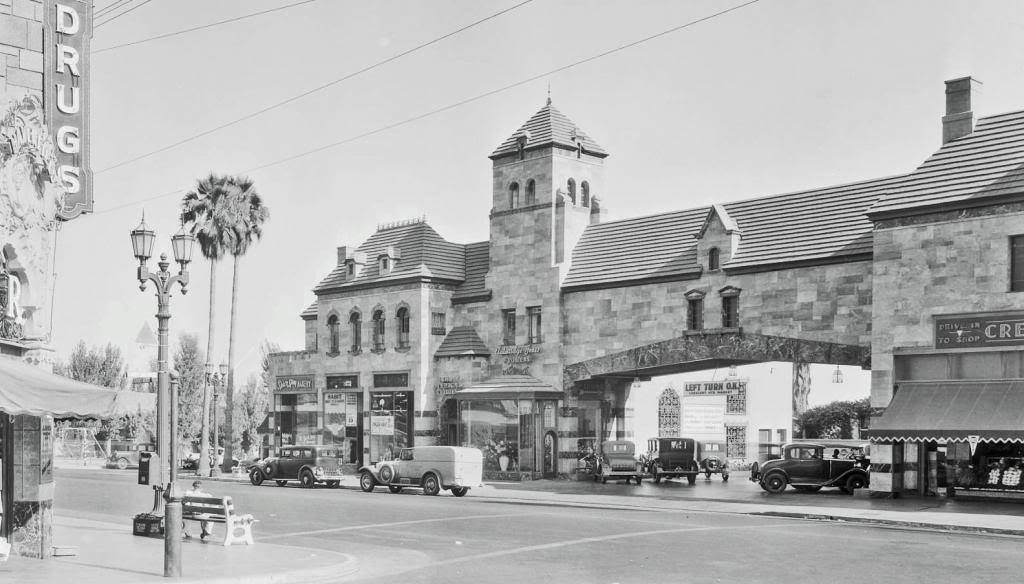 |
|
| (ca. 1931)* – Panoramic view showing the Sunset Medical Building (aka “Crescent Heights Shopping Center”) located on the south side of Sunset at Laurel. The Crescent Heights Market is on the right, and further to the right (out of frame) is Schwab's Pharmacy. On the left is Haverfield Drugs. West Hollywood is west of Crescent Heights. |
Historical Notes The beautiful 'French Norman revival' building was located on the southeast corner of Sunset Blvd. and Crescent Heights Blvd., just east of the Garden of Allah apartments. The structure faced Sunset Blvd. |
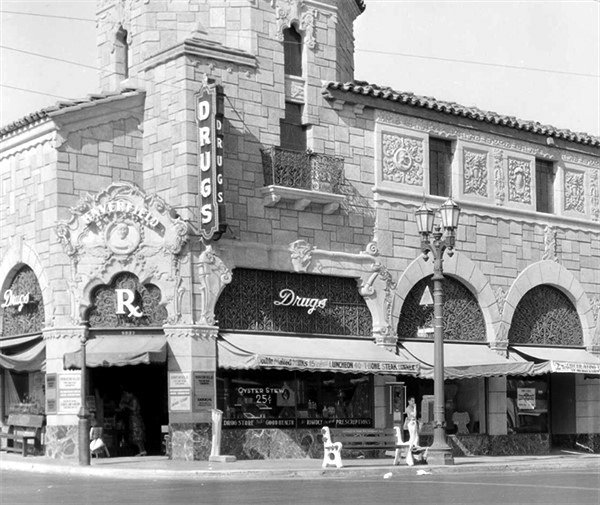 |
|
| (1928)* – View showing Haverfield Drugs at the northeast corner of Sunset and Laurel Canyon Blvd., across the street from the Crescent Heights Market and Schwab’s Pharmacy. The building is still standing today and a UPS Store now occupies the corner store. Click HERE for contemporary view. |
Then and Now
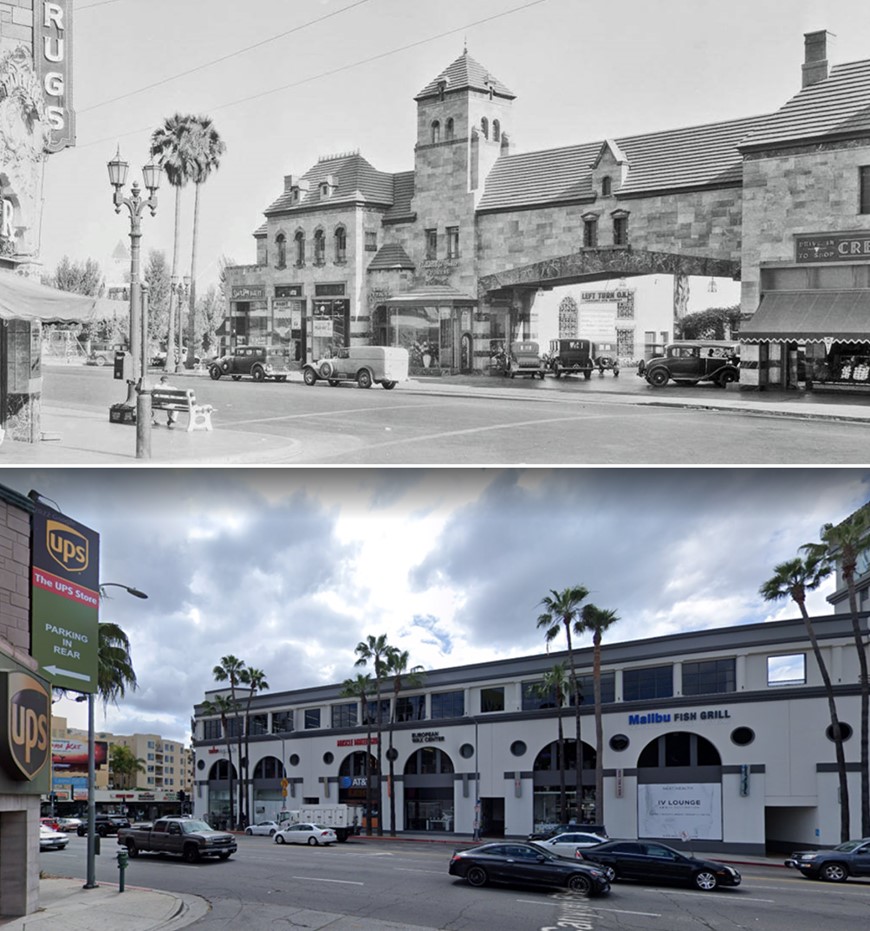 |
|
| (1931 vs 2019)* - View looking southeast from the corner of Laurel Canyon and Sunset Boulevard. |
Historical Notes Today, the 8000 Sunset Strip Shopping Center stands at the southeast corner of Sunset and Crescent Heights. The center includes Trader Joe's, CB2 (Crate & Barrel), Sundance Cinema, Crunch Fitness, Subway and several offices. |
Schwab's Pharmacy
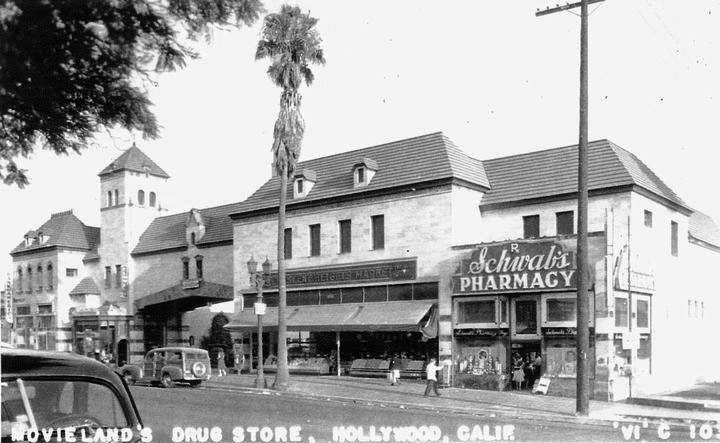 |
|
| (1940s)* – Postcard view looking at the south side of Sunset east of Crescent Heights showing “Movieland’s Drug Store” (Schwab’s Pharmacy). Photo: Vintage Los Angeles. |
Historical Notes Schwab's Pharmacy was a popular hangout for movie actors and movie industry dealmakers from the 1930s through the 1950s. Like many drug stores in the United States throughout the mid-twentieth century, Schwab's sold medicines and had a counter serving ice cream dishes and light meals. |
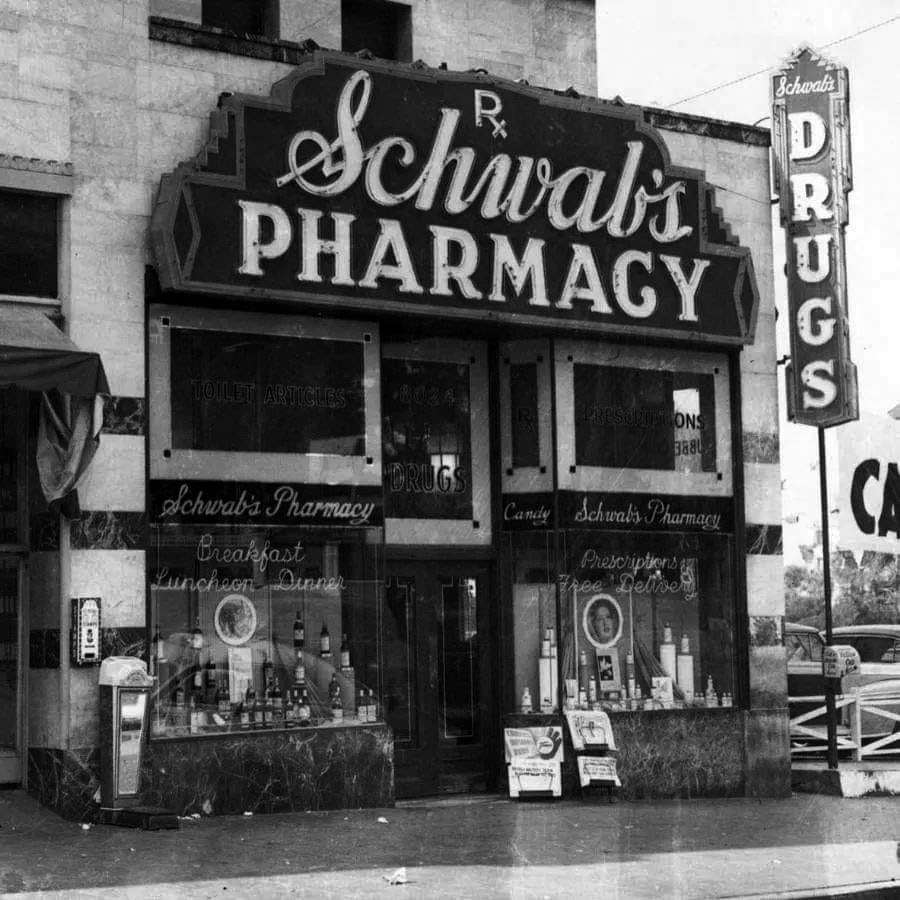 |
|
| (1940s)^x^ – Close-up view of Schwab’s Pharmacy at 8024 Sunset Boulevard in West Hollywood. |
Historical Notes Schwab's opened in 1932 when Philadelphia natives and brothers, Jack, Leon, Bernard and Martin Schwab, bought a failing pharmacy on the corner of Sunset and Crescent Heights boulevards. The pharmacy was located just around the corner from several studios and the brothers set up their pharmacy to cater to the Hollywood crowd. Schwab's was more than just a place to fill prescriptions: there was a grocery store, a make-up counter (Gloria Swanson bought all her cosmetics there) and a restaurant that served all-American fare like hamburgers and meatloaf (Marlon Brando and Orson Welles were fans).* |
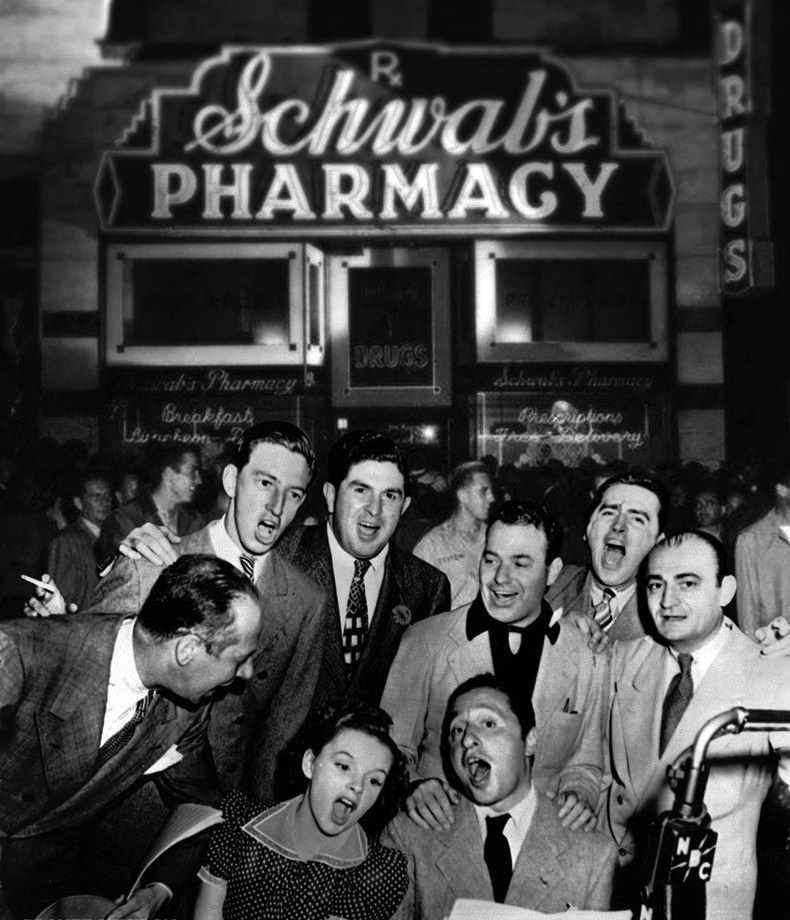 |
|
| (ca. 1939)^^ - Standing, Bert Lahr, Ray Bolger, MGM executive L.K. Sydney, E.Y. Harburg, Meredith Wilson, & publisher Harry Link. Judy Garland & Harold Arlen are at the piano. |
Historical Notes 1938 - Harold Arlen was working on a movie score for an upcoming film, The Wizard of Oz. He was having a difficult time composing a ballad for one particular scene. Ballads were usually love songs, but this scene was about a lonely farm girl longing for "a place where there isn't any trouble," and it had him stumped. He decided to take a break from writing and catch a movie at Grauman's Theater with his wife, Anya. He sat in the passenger seat with Anya at the wheel. They turned onto Sunset Blvd, heading East, when suddenly he touched her arm and asked her to pull over. Anya parked the car under the neon sign of Schwab's Pharmacy, as Harold scribbled the melody that just came to him. He rushed inside to call his writing partner, Yip Harburg, from the Schwab's payphone. "Yippers, can you meet me at my house in 10 minutes? I think I got a nugget." |
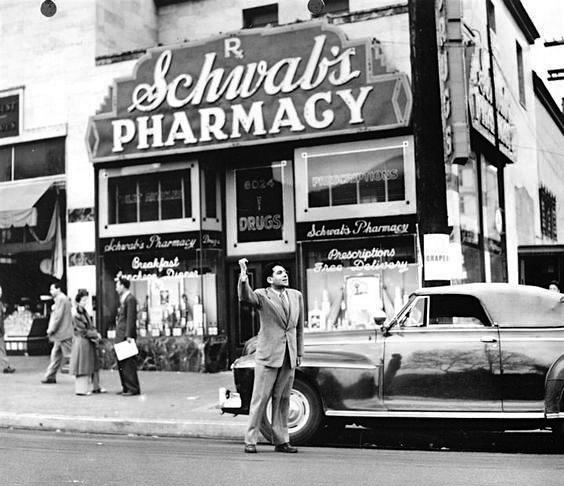 |
|
| (1940s)^x^ - View showing Sidney Skolsky, a gossip columnist, in front of Schwab’s Pharmacy on Sunset Blvd. |
Historical Notes Sidney Skolsky, a syndicated Hollywood gossip columnist for the New York Daily News who was the first journalist to use the nickname "Oscar" for the Academy Award in print, made Schwab's famous in the 1930s. He used the drugstore as his office, and called his column in Photoplay, the premiere movie magazine in the U.S. at the time, "From A Stool At Schwab's". |
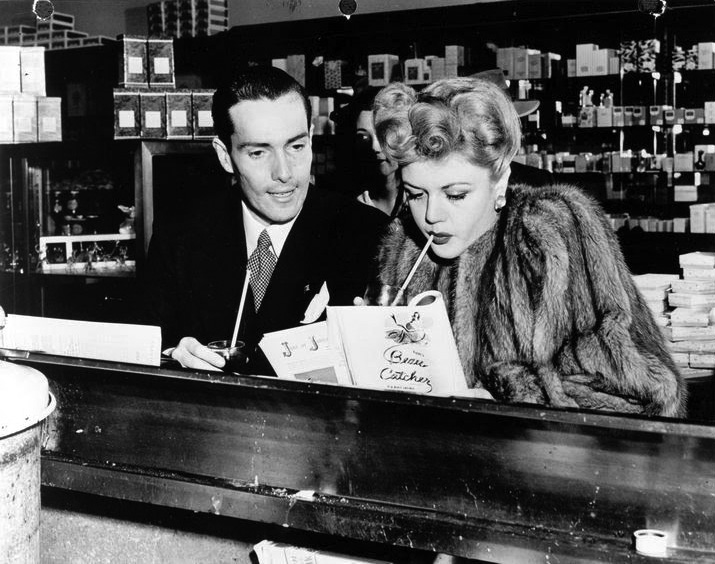 |
|
| (1945)^.^ - Hurd Hatfield and Angela Lansbury hanging out at the counter of Schwab's Pharmacy and (maybe) reading reviews of their film "The Picture of Dorian Gray", which was released in March of that year. |
Historical Notes A persistent Hollywood legend has it that actress Lana Turner was "discovered" by director Mervyn LeRoy while at the soda counter at Schwab's. While the 16-year-old Turner was indeed discovered at a soda counter, the actual location was not Schwab's but another Sunset Boulevard establishment, the Top Hat Cafe, and the person who discovered her was not LeRoy but Hollywood Reporter publisher William Wilkerson.^ |
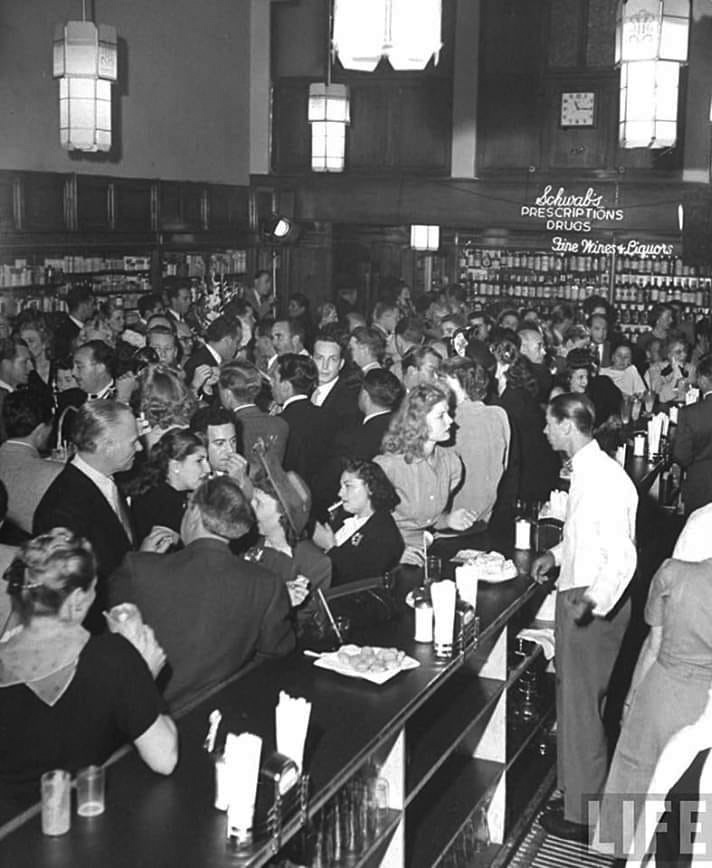 |
|
| (1948)^.^ - Schwab's Pharmacy on Sunset Blvd on a Friday night. It was a hangout for Hollywood Stars and up--and-comers. Life Magazine Photo |
Historical Notes Schwab’s became an essential piece not only of Hollywood day-to-day living but of Hollywood lore. Open from early in the morning until past midnight, the place was a clubhouse, a headquarters, and a hearth fro up-and-comers, never-quite-ever-beens, rubberneckers, and strivers and schemers trying to pry a way into (sometimes back into) the movie business.* |
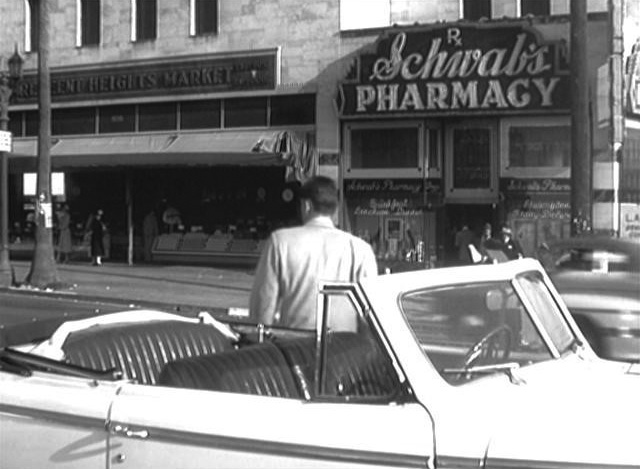 |
|
| (1950)^.^ – William Holden waits for traffic to clear as he attempts to cross Sunset Blvd on his way to Schwab’s Pharmacy in this scene from the movie Sunset Boulevard. Crescent Heights Market is seen on the left. |
Historical Notes The 1950 film, Sunset Boulevard, stars William Holden as Joe Gillis, a struggling screenwriter, and Gloria Swanson as Norma Desmond, a former silent-film star who draws him into her demented fantasy world, where she dreams of making a triumphant return to the screen. Erich von Stroheim plays Max von Mayerling, her devoted butler, and Nancy Olson, Jack Webb, Lloyd Gough, and Fred Clark appear in supporting roles. Director Cecil B. DeMille and gossip columnist Hedda Hopper play themselves, and the film includes cameo appearances by leading silent-film actors Buster Keaton, H. B. Warner, and Anna Q. Nilsson.^ |
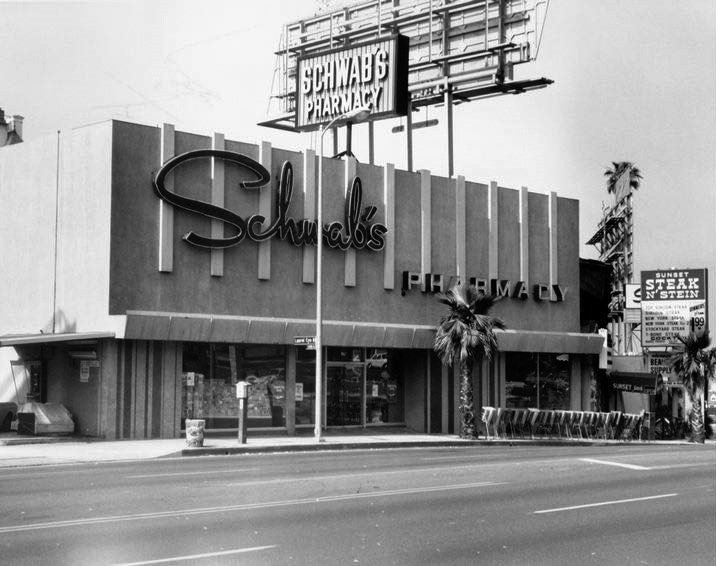 |
|
| (ca. 1960s)^.^ – View showing Schwab's Pharmacy after it was completely rebuilt. Sunset Steak n’ Stein is on the right, where Googie’s used to be located. |
Historical Notes Over the years, Schwab’s became a popular local mini-chain, with locations at 6255 Hollywood Boulevard, 430 N. Roxbury Boulevard and 401 N. Bedford Drive. The Bedford Drive location, which had a special department and phone number reserved for the famous, was where Marilyn Monroe filled her prescriptions. One of her prescription bottles sold for $3,200 in 2014.* |
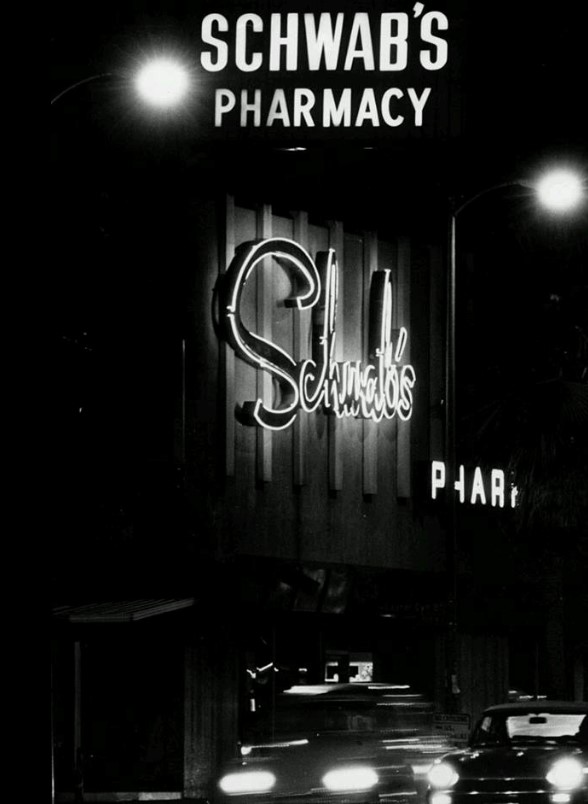 |
|
| (ca. 1960s)^.^ - Nighttime view of Schwab's Pharmacy after it was enlarged and given a new facelift. |
Historical Notes Schwab's continued to be a popular hang-out well into the 1970s with luminaries like Cher, Linda Ronstadt and Diane Keaton frequenting the Hollywood hot spot. |
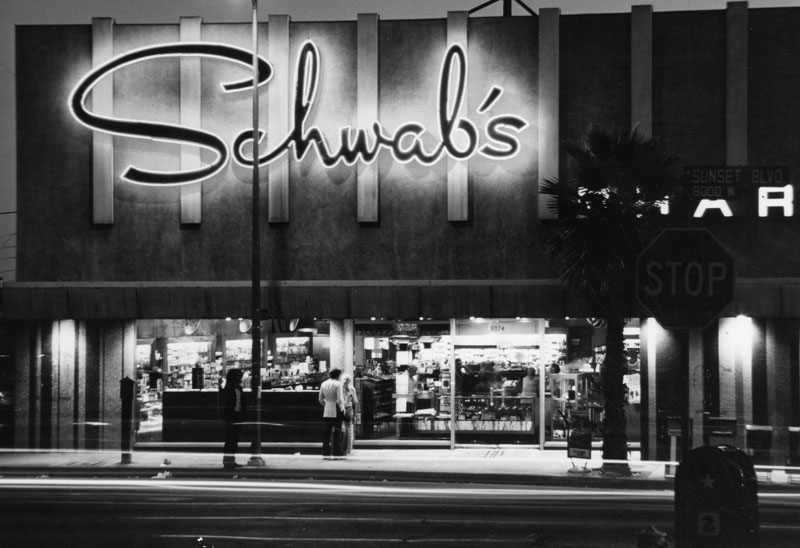 |
|
| (1980)* - Exterior of Schwab's Pharmacy at 8024 Sunset Boulevard, in West Hollywood. |
Historical Notes In the 1970s and early ’80s, a new set of celebrities began gracing the fountain with their presence, including Eric Estrada, Al Pacino, Sylvester Stallone, Goldie Hawn and Jerry Brown. In 1980, Jack Schwab passed away at age 75, and after five decades of service, the Schwab’s on Sunset Boulevard closed down. Leon Schwab stated that the closure was due to family reasons, but the truth was that the company was in financial distress. In 1983, everything that was not bolted down, from the stools and counters to the pharmacy’s famous Rolodex, was auctioned off to the highest bidder. The large red-and-blue neon sign that hung over the front door sold for $650.* It took the wrecking ball a couple of more years to knock down Schwab's, but in 1988 the building came down, making way for a large retail complex. |
Googie's Coffee Shop
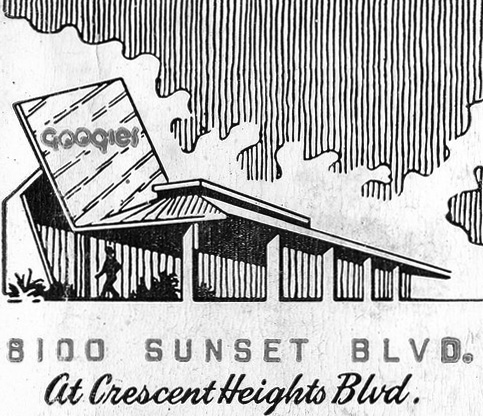 |
|
| (1950s)^ - Matchbook cover image advertising Googie's Coffee Shop located at the SE corner of Sunset and Cresecent Heights boulevards. |
Historical Notes The origin of the name Googie dates to 1949, when architect John Lautner designed the West Hollywood coffee shop Googies, which had distinct architectural characteristics. The name "Googie" had been a family nickname of Lillian K. Burton, the wife of the original owner, Mortimer C. Burton.* |
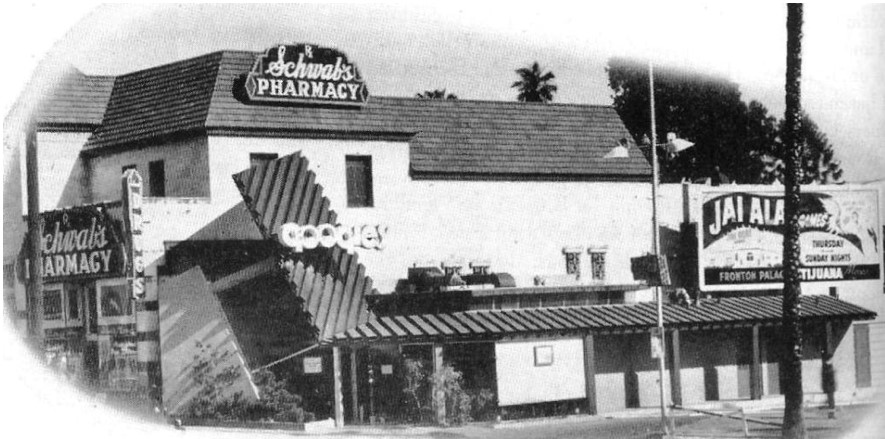 |
|
| (1950s)* - View showing Schwab’s Pharmacy and Googie’s Coffee Shop near the corner of Sunset Boulevard and Crescent Heights. Note the signboard on the right advertises the sport of Jai Alai at the Fronton Palace in Tijuana, Mexico. |
The Origins of Googie Architectrure Alan Hess, the author of Googie: Fifties Coffeeshop Architecture, traces Googie back to three Coffee Dan's restaurants designed by John Lautner in the early forties. "He selected the vaults and glass walls and trusses and angles of his buildings to fit the original, often unusual, concepts of space he favored," writes Hess. Lautner originated the style that would be refined and reinterpreted by many others. Unintentionally, he also gave the style a name when, in 1949, he designed Googie's Coffee Shop at the corner of Sunset Boulevard and Crescent Heights in Los Angeles. Professor Douglas Haskell of Yale was driving through Los Angeles when he and architectural photographer Julius Shulman came upon Googie's. "Stop the car!" Haskell yelled. "This is Googie architecture." While Haskell was dubious about the style, he made the name "Googie architecture" stick by using it in a 1952 article in House and Home magazine.* |
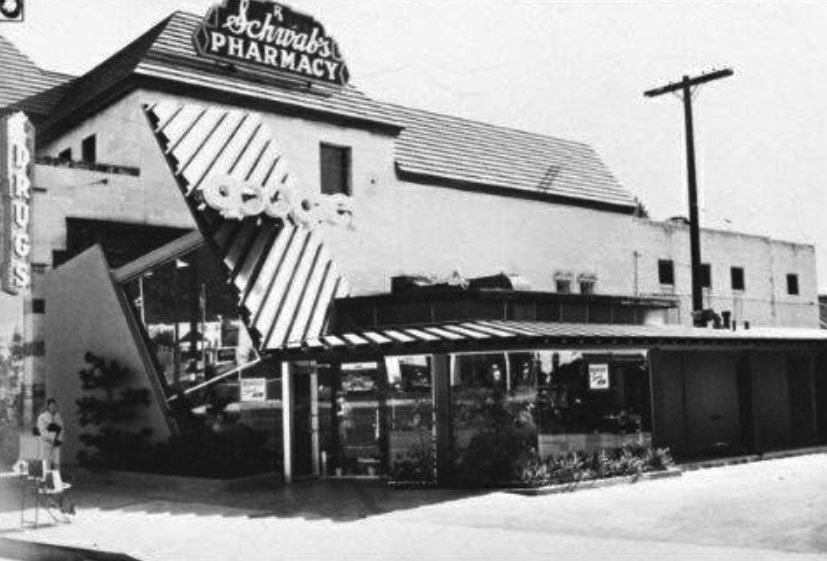 |
|
| (1952)^* - Close-up view of Googie's Coffee shop and its neighbor Schwab’s Pharmacy located near the SE corner of Sunset and Crescent Heights. |
The Googie Look Although Googie buildings were often quite different from one another, Douglas Haskell noted that the style had certain rules: 1. It can look organic, but it must be abstract. "If it looks like a bird, it must be a geometric bird. It's better yet if the house had more than one theme: like an abstract mushroom surmounted by an abstract bird." 2. Ignore gravity altogether. "Whenever possible, the building must hang from the sky." 3. Multiple structural elements. Inclusion is the rule, rather than minimalism. New materials, including sheet glass, glass blocks, asbestos, plywood and plastic gave the architect a whole new palette to work with. Other innovations allowed steel and cement to be used in new ways. Suddenly, architects had more elbowroom for their dreams. A room made of plastic could look like a log cabin, a space ship, or almost anything.* |
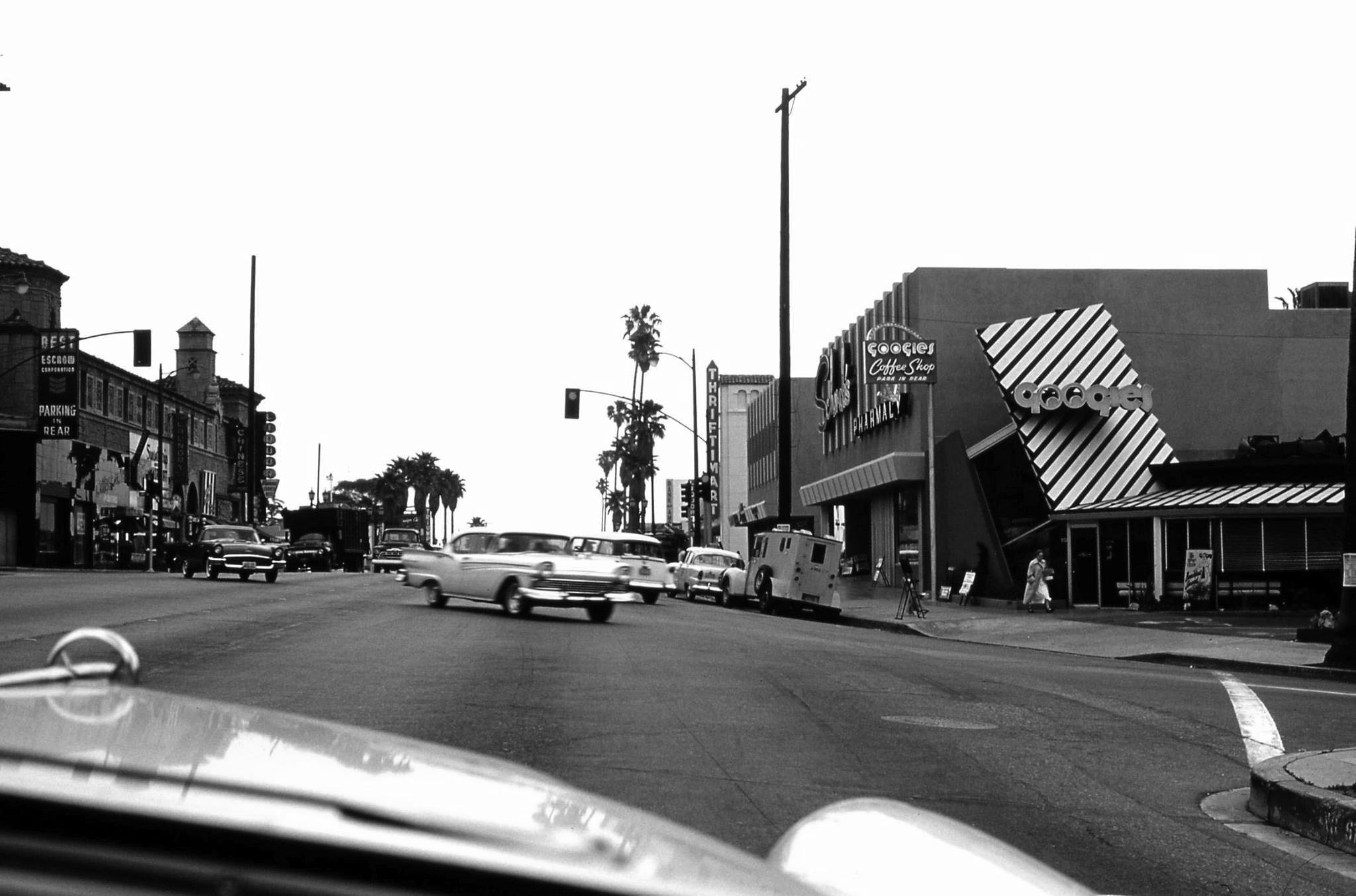 |
|
| (ca. 1957)^ – View looking east on Sunset at Crescent Heights in West Hollywood as seen from the passenger seat of a long nose V8 bomb sight Buick. On the right is the original high style Googie's Coffee Shop and landmark Schwabs Drug Store. Photo courtesy of Kent Adamson and Richard Wojcik via Vintage Los Angeles |
Googie Architectrure Googie was about the past, the present and the future -- But mostly the future. It was part of the popular culture, which reinforced a unified vision of a utopian future built on mankind's work and ingenuity. |
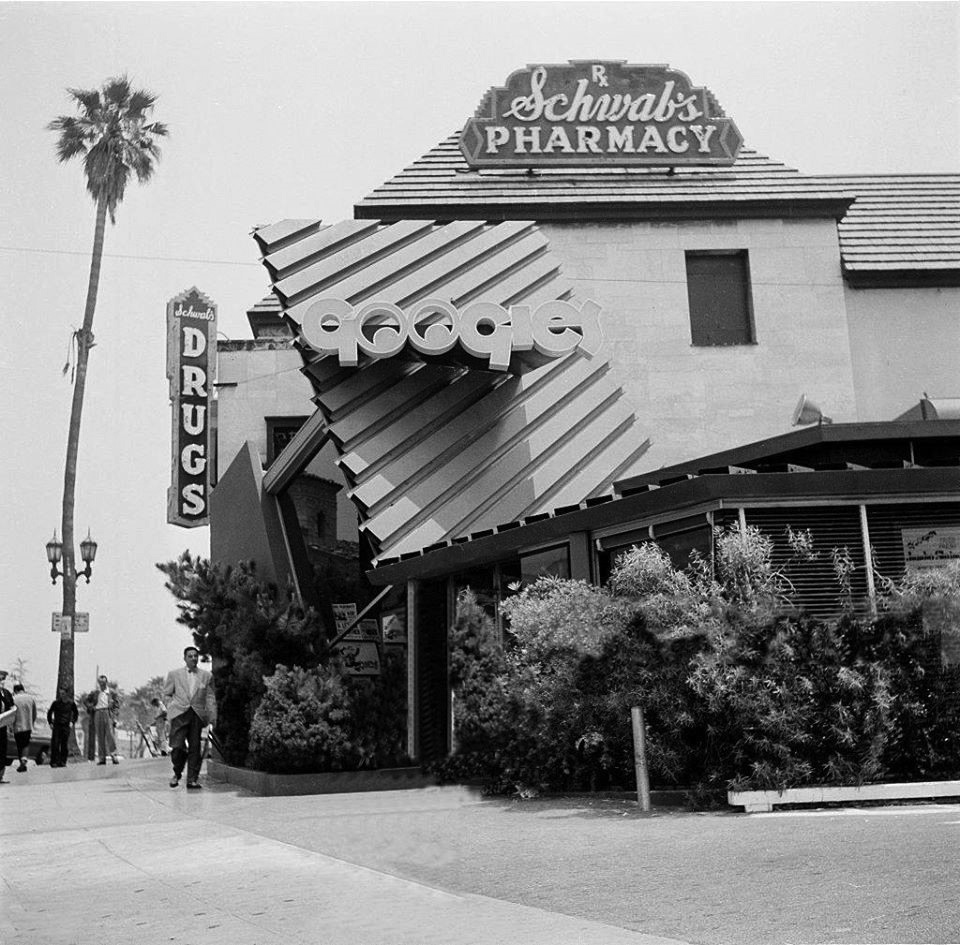 |
|
| (1954)^ – A man in a light sport coat and bow tie walks by Schwab’s Pharmacy and Googies Coffee Shop. Photo courtesy of Bruce Ablin |
Historical Notes Googie’s Coffee Shop was located next door to celebrated Schwab’s drug store, on the corner of Sunset and Crescent Heights Boulevards. It was all the rage among young, up and coming stars in 1950s Hollywood who went to table hop, not necessarily to eat. |
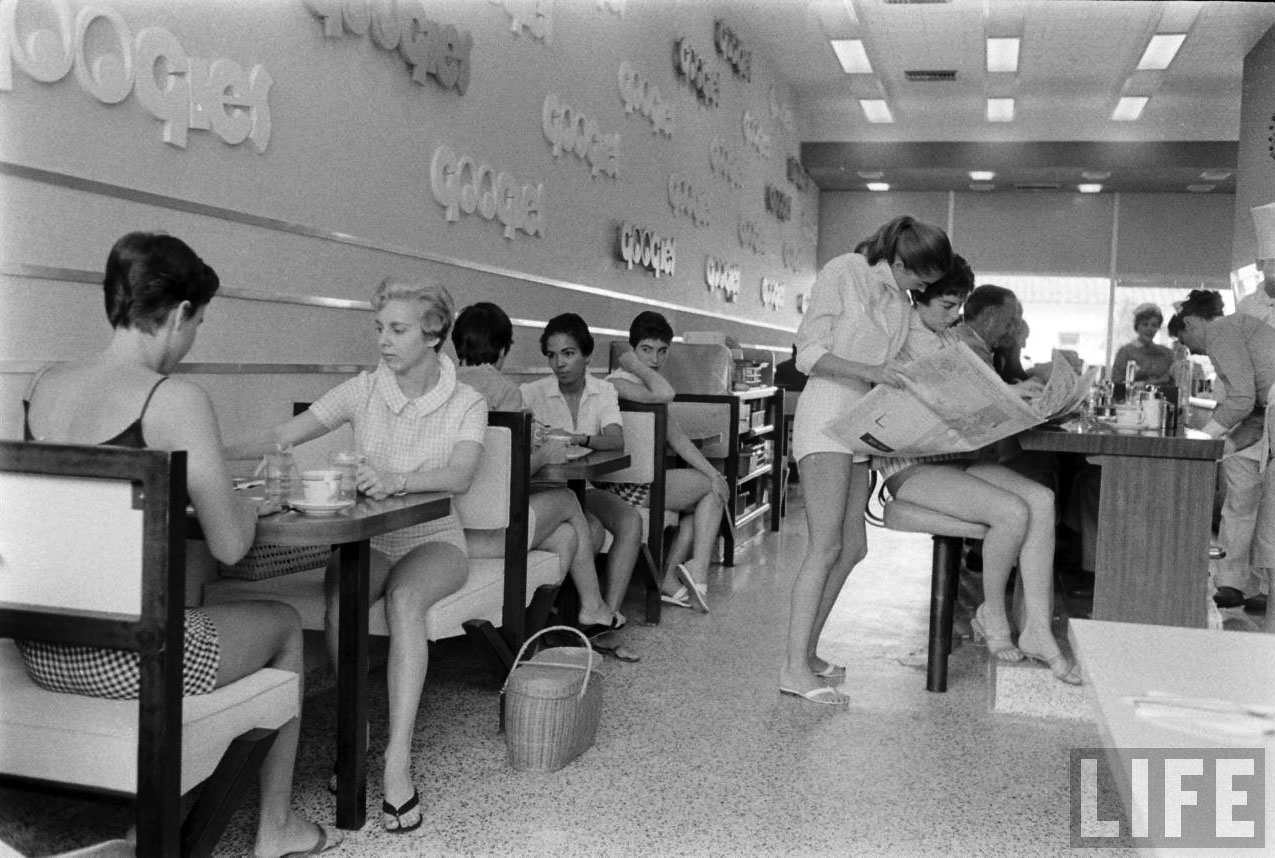 |
|
| (1950s)* - Interior view of Googie’s Coffee Shop whose quirky angles lent its name to a whole architectural style that became a distinctive addition to the Southern California landscape. Photo taken at the Googie’s located at 420 N Roxbury Drive, Beverly Hills, in the City National Bank building. Photo: Allan Grant, LIFE archives |
Historical Notes Googie captured the post-war high that made people feel that the future was now and they were living in it. As time passed, Googie came to reflect a very 1950s and ’60s view of what “the future” meant.* |
 |
|
| (1950s)*- Shorts only at Googie's Coffee Shop. Photo taken at the Googie’s located at 420 N Roxbury Drive, Beverly Hills, in the City National Bank building. Photo: Allan Grant, LIFE archives |
Historical Notes Like most art forms that told a story or inspired with optimism, Googie went out of fashion in the mid-1960s.* |
Then and Now
 |
|
| (1957 vs 2022)* – Sunset and Crescent Heights |
* * * * * |
West Hollywood
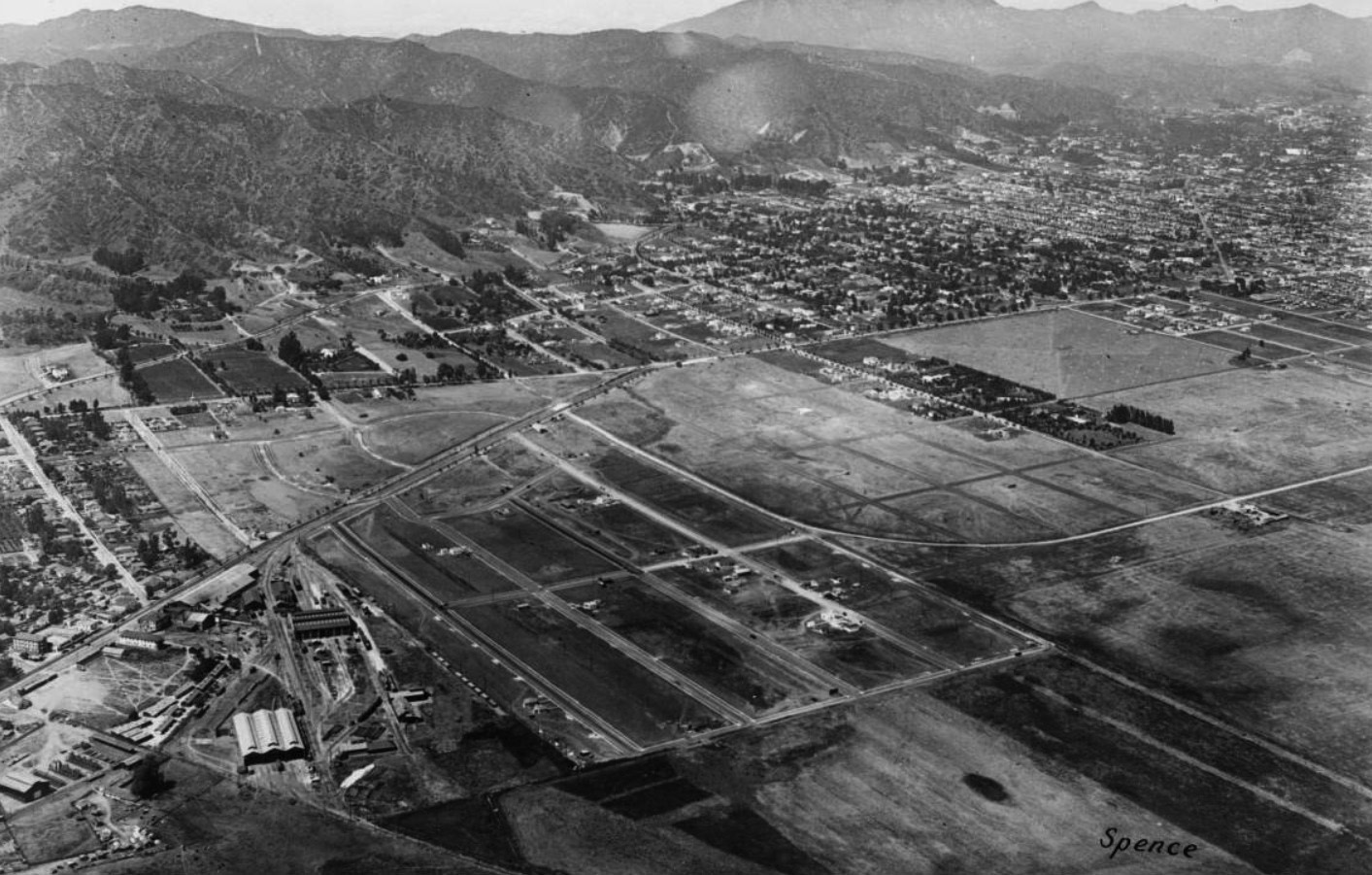 |
|
| (1922)^^ – Aerial view of Sherman (later West Hollywood) looking northeast with Santa Monica Boulevard running diagonally from lower-left to center, past La Cienega Boulevard, where it turns east and heads toward Hollywood (at the time Colegrove). The original settlement of Sherman is visible along the left edge of the photo, next to the rail yard. |
Historical Notes During the final decade years of the nineteenth century, the first large land development in what would later become West Hollywood—the town of "Sherman"—was established by Moses Sherman and his partners of the Los Angeles Pacific Railroad, an interurban railroad line which later became part of the Pacific Electric Railway system. Sherman became the location of the railroad's main shops, railroad yards, and "car barns". Many working-class employees of the railroad settled in this town. It was during this time that the city began to earn its reputation as a loosely regulated, liquor-friendly (during Prohibition) place for eccentric people wary of government interference. For years, farms and open fields separated the town of Sherman from the neighboring communities of Colegrove and Hollywood (an independent city from 1903 to 1910). Though connected by the tracks of the Pasadena and Pacific—later bounded on each side by paved roadways for motor cars and named Santa Monica Boulevard—it was not until the early 1920s that the growing Los Angeles metropolis met the street grid of Sherman. ^ |
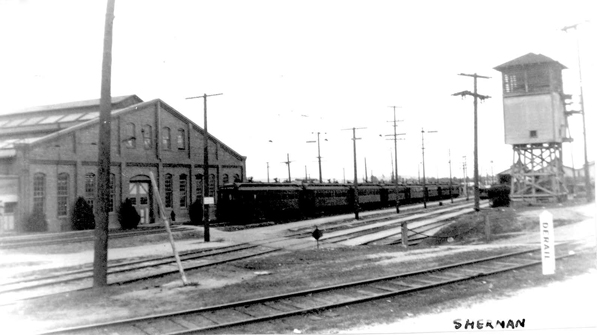 |
|
| (n.d.)*^* - View of the Pacific Electric's Sherman rail yard, current location of the Pacific Design Center. |
Historical Notes In 1896, Sherman and Clark built a rail yard and power plant at roughly the midpoint between Los Angeles and Santa Monica, where today's Santa Monica and San Vicente boulevards intersect. |
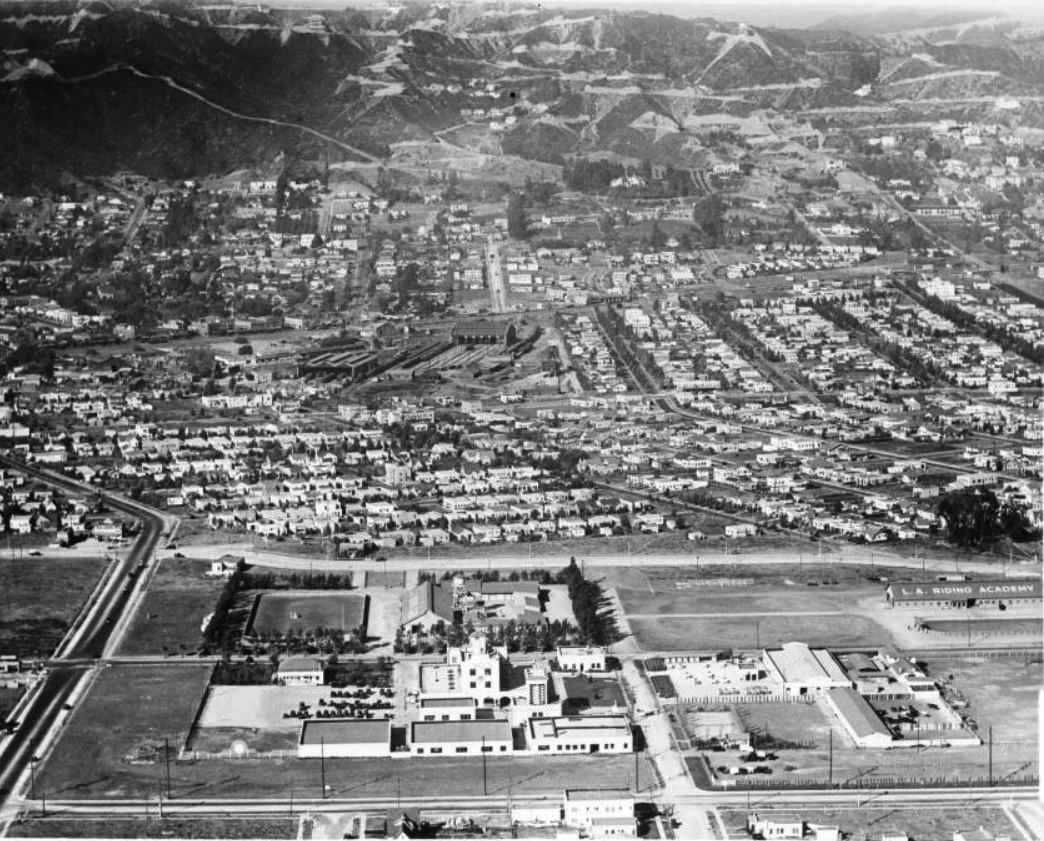 |
|
| (ca. 1928)^^ – Aerial view looking north showing West Hollywood (Sherman until 1925) with the Hollywood Hills seen in the background. What would become Beverly Boulevard runs horizontally at center of photo and Third Street is at bottom. Robertson Boulevard runs away from camera at left and dog legs up toward Santa Monica Boulevard. The Sherman train yard (upper center-left) sits near the intersection of San Vicente and Santa Monica boulevards. In the foreground is a large dirt arena and a stable housing the Los Angeles Riding Academy which is on property now occupied by Cedars-Sinai Medical Center. |
Historical Notes For many years, the area that is now the city of West Hollywood was an unincorporated area in the midst of Los Angeles. Because gambling was illegal in the city of Los Angeles, but still legal in Los Angeles County, the 1920s saw the proliferation of many casinos, night clubs, etc., along Sunset Boulevard (which starts in downtown Los Angeles and runs westward). These businesses were immune from the sometimes heavy-handed law-enforcement of the L.A. Police Department. In 1925, In a controversial decision, Sherman adopted "West Hollywood", "...a moniker pioneered earlier in the decade by the West Hollywood Realty Board" as its informal name, though it remained under the governance of Los Angeles County.*^ |
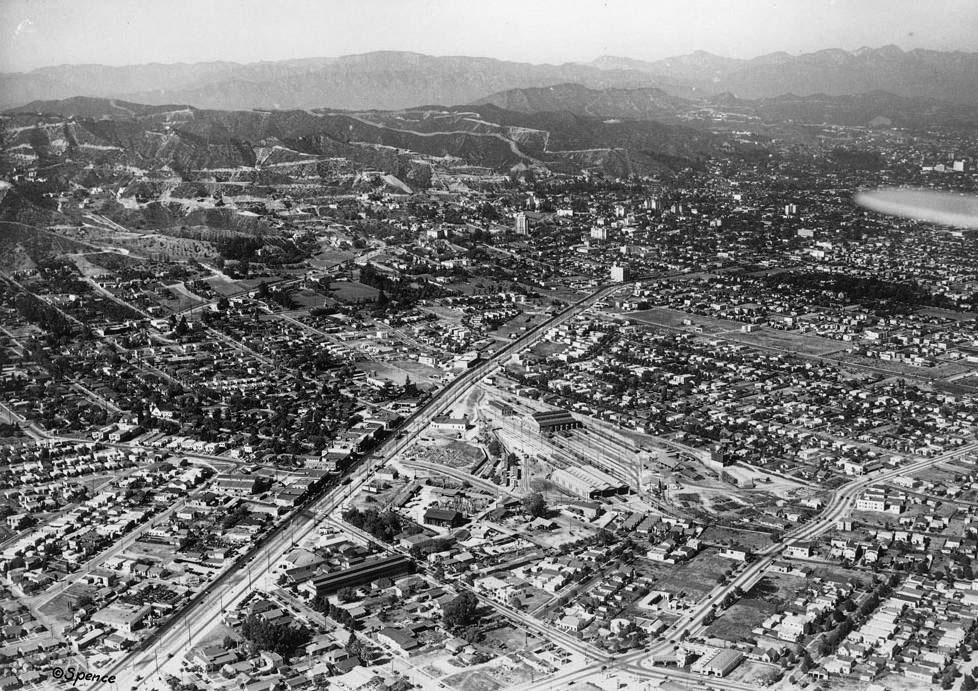 |
|
| (ca. 1931)^^ - Aerial view of West Hollywood looking northeast. The wide street running from lower-left to upper-right is Santa Monica Boulevard. In the right-center is the Sherman train yard where the Pacific Design Center stands today. |
Historical Notes Beginning in 1922, Sherman's population boomed. As the town's development began to merge with that of Hollywood, by then a part of the City of Los Angeles, some in both Sherman and the metropolis began speaking of annexation. Los Angeles promptly annexed several large but mostly vacant tracts surrounding Sherman; the 1,203-acre Fairfax district became part of Los Angeles with the unanimous approval of its 16 residents, and a 7-0 vote joined the 430-acre Melrose district with L.A. L.A. easily incorporated these vast tracts into its city limits without contention, but Sherman was an established community with an independent identity, and the issue of annexation divided Sherman's population and business interests. Realtors supported it, arguing that future development depended on access to Los Angeles' sewer and fire protection services. Sherman's Board of Trade and Chamber of Commerce opposed joining the city, however, fearful of increased property taxes. Ultimately the anti-annexationist forces prevailed. Instead of relying on L.A.'s utility connections and public services, Sherman financed construction of its own sewer system and relied upon the county for police and fire protection services. ^ |
Santa Monica Boulevard
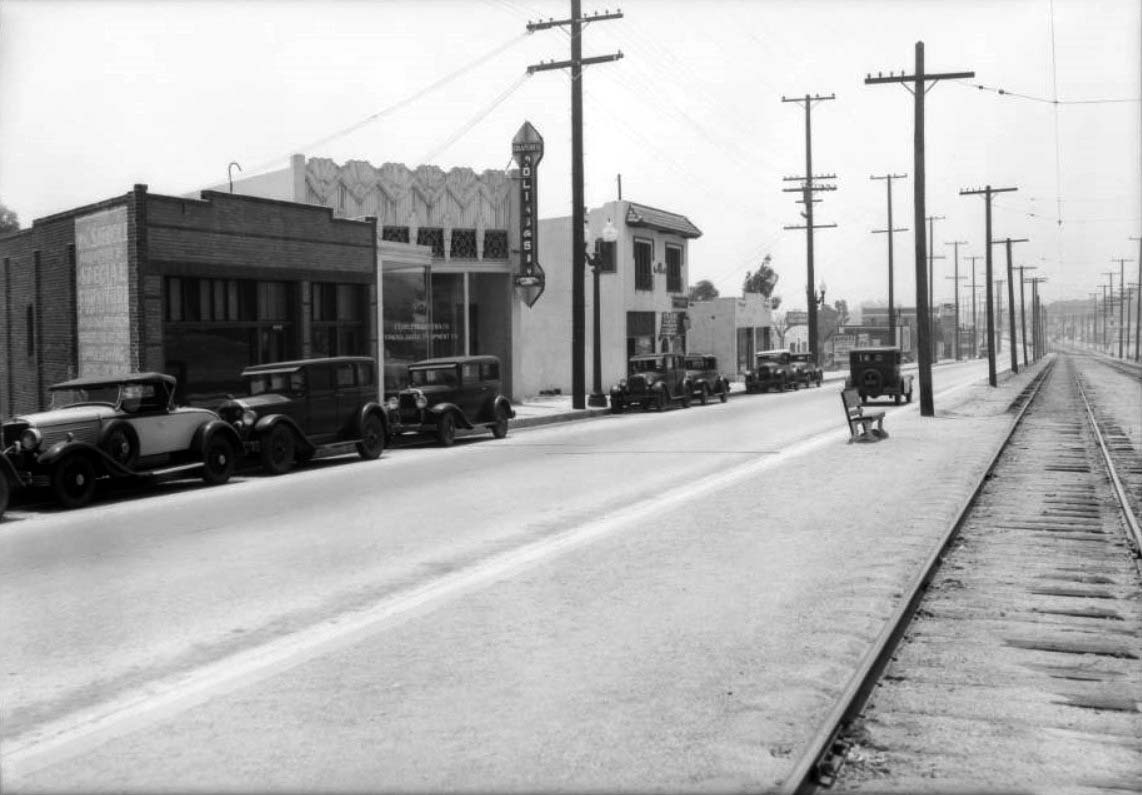 |
|
| (ca. 1933)^^ - View looking southwest on the 8500 block of Santa Monica Boulevard, between San Vicente and La Cienega boulevards, in West Hollywood. Railroad tracks run down the center of the street. |
Historical Notes The tracks running down the center of Santa Monica Boulevard became part of the Pacific Electric Railway in 1911 and carried red cars until 1954. They then remained largely unused for decades, serving the occasional Southern Pacific freight train through the 1970s. It was not until 1999 that the West Hollywood segment of the tracks were dug up and replaced by a landscaped median.^ Click HERE to see same view in 2016. |
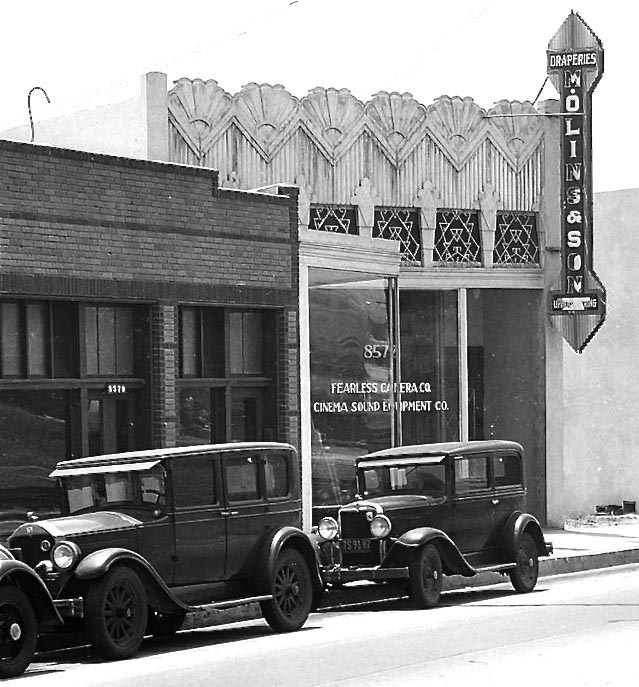 |
|
| (1933)^^ - Blow-up view of previous photo showing the Art Deco building at 8572 Santa Monica Boulevard with large sign reading: Molins & Son Draperies. Tenant also includes Fearless Camera Co. & Cinema Sound Co. |
Then
 |
|
| (1933)^.^ – View looking west on Santa Monica Boulevard toward Westbourne Drive. The building seen on the NW corner (center-right) is still there. This was taken at around 8612 Santa Monica, which puts it approximately where LA Fitness now stands. |
Now
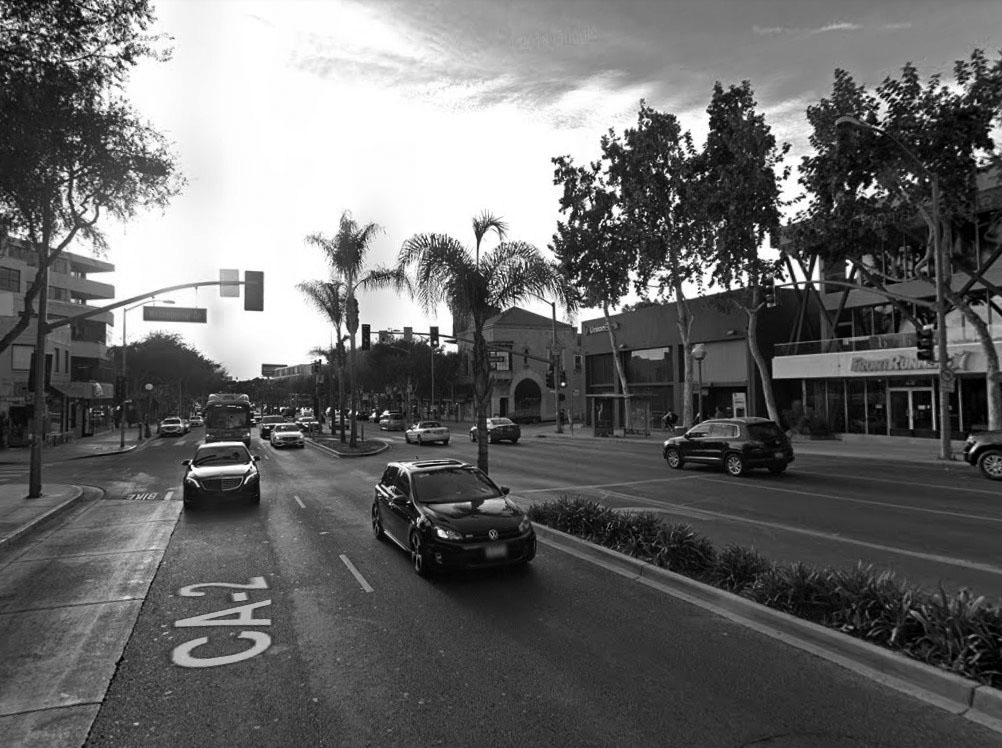 |
|
| (2018)*### – Google street view looking west on Santa Monica toward Westbourne Drive. Note that the building on the NW corner is still there (compare to previous photo). |
Then and Now
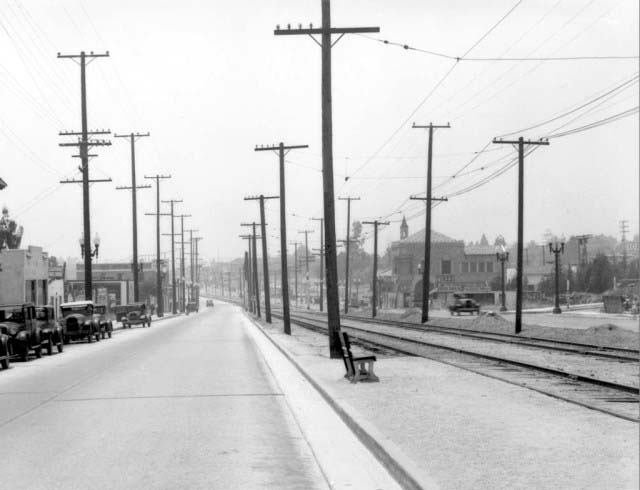 |
|
 |
| (1933 vs. 2018) - Looking west on Santa Monica Boulevard toward Westbourne Drive. Building on the SW corner is still there. |
|
Santa Monica and La Brea
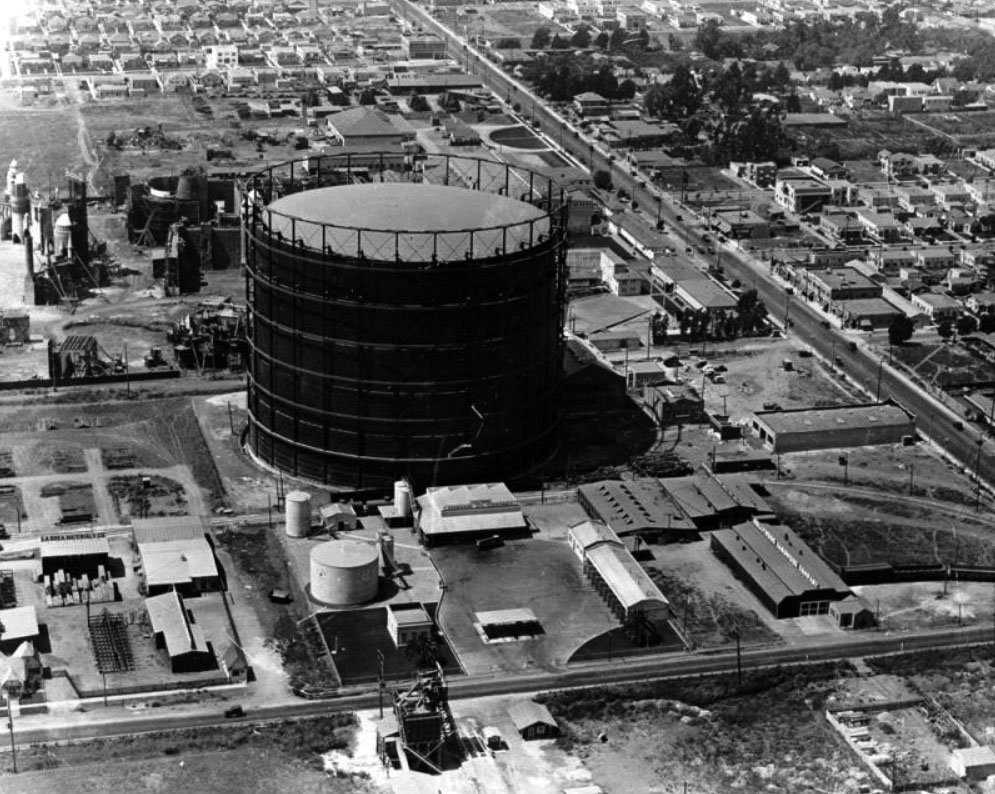 |
|
| (1920s)* – Aerial view looking West showing a “Gasometer” (Gas Storage Tank) located near the intersection of Formosa Ave and Romaine Street. La Brea runs across the bottom of photo. Santa Monica Boulevard runs diagonally from right-center to top center. Picford-Fairfanks Stuidos can be seen on the other side of Formosa Ave behind the tank. The SE corner of Formosa and Santa Monica Blvd (center-right) is where the iconic Formosa Cafe would be built. |
Historical Notes The huge tank seen above was installed by LA Gas and Electric Company which later evolved into Southern California Gas Company. These large tanks were known as "gas holders" (aka gasometers), and helped supply natural gas to the city. They rose or sank in height depending on the amount of gas being stored. |
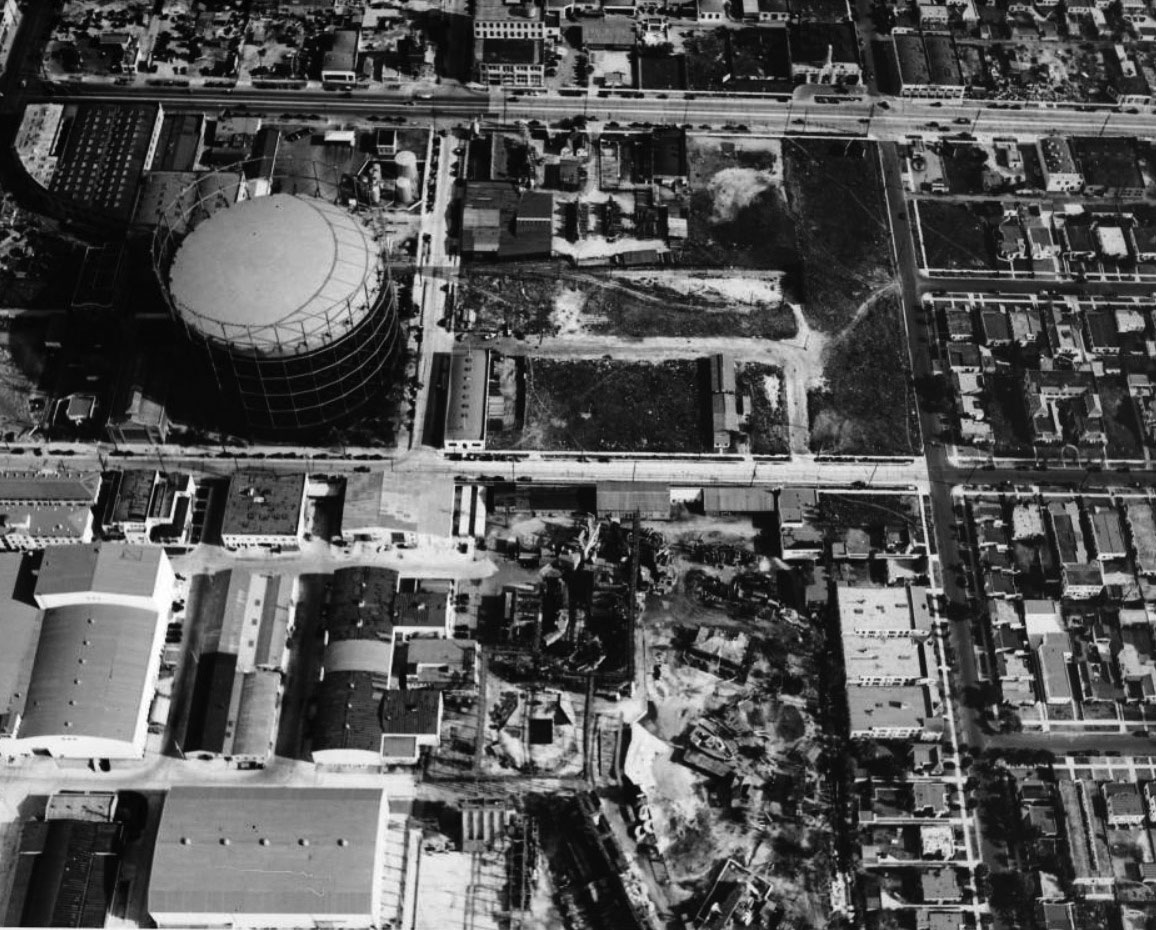 |
|
| (1937)^^ - Aerial view looking east showing the United Artists Studios with a very large gas storage tank (Gasometer) seen here at the NE corner of Formosa and Romaine. La Brea runs horizontally at top of photo. Santa Monica Boulevard is on the left (out of view). The Formosa Cafe would be built to the north of the Gas Tank on the SE corner of Formosa and Santa Monica Blvd. |
Historical Notes The above Gasometer was dismantled in the mid-1970s. Click HERE to see more in Gasometers of Early Los Angeles. |
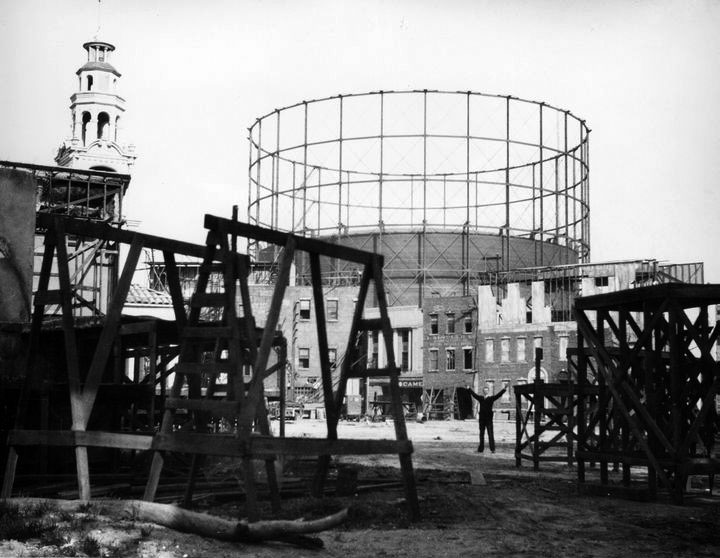 |
|
| (1926)*# - View of the Pickford-Fairbanks Studios lot on Santa Monica Boulevard in West Hollywood, showing the nearby Gasometer towering in the background. |
Then and Now
.jpg) |
|
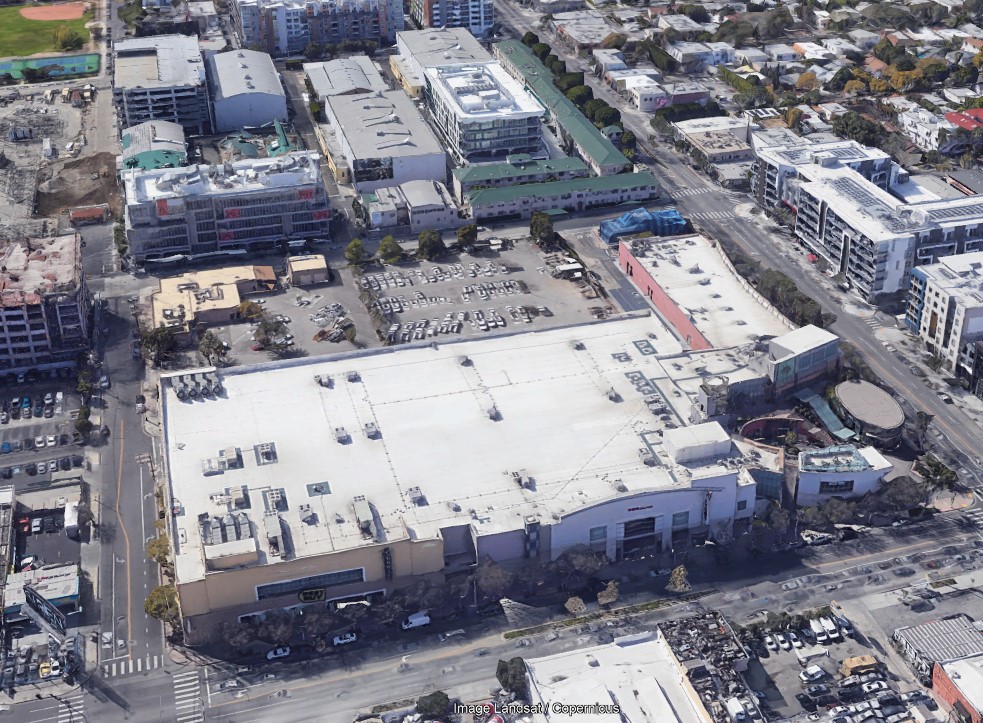 |
|
| (1920s vs 2019)^ - Then and Now |
Historical Notes The building at top center-right in the contemporary view is covered in blue. It is the Formosa Cafe during a remodel located on SE corner of Santa Monica and Formosa. Click HERE to see more. |
Pickford-Fairbanks Studios (later United Artists, Samuel Goldwyn, Warner Brothers, and "The Lot")
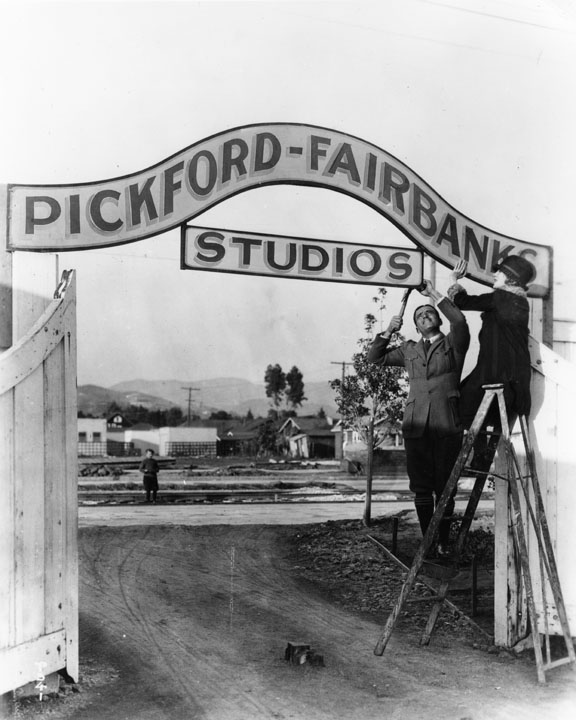 |
|
| (1922)^ - Mary Pickford and Douglas Fairbanks hang the entrance signs for their Pickford-Fairbanks Studios near the corner of Santa Monica Boulevard and Formosa Avenue in West Hollywood. |
Historical Notes When United Artists was formed in 1919 by Charlie Chaplin, Mary Pickford, Douglas Fairbanks, and D. W. Griffith, the founders never intended the company to be like a regular Hollywood studio. It started solely as a distribution company. Its mission was to release films made by independent producers, therefore it had no studio lot. However, many of the independent producers owned their own property, like the Charlie Chaplin Studio on Sunset Boulevard. The closest thing to a studio lot was the property owned by Pickford and Fairbanks on the corner of Santa Monica Boulevard and Formosa Avenue in Hollywood. The studio lot's address is now 1041 North Formosa Avenue. |
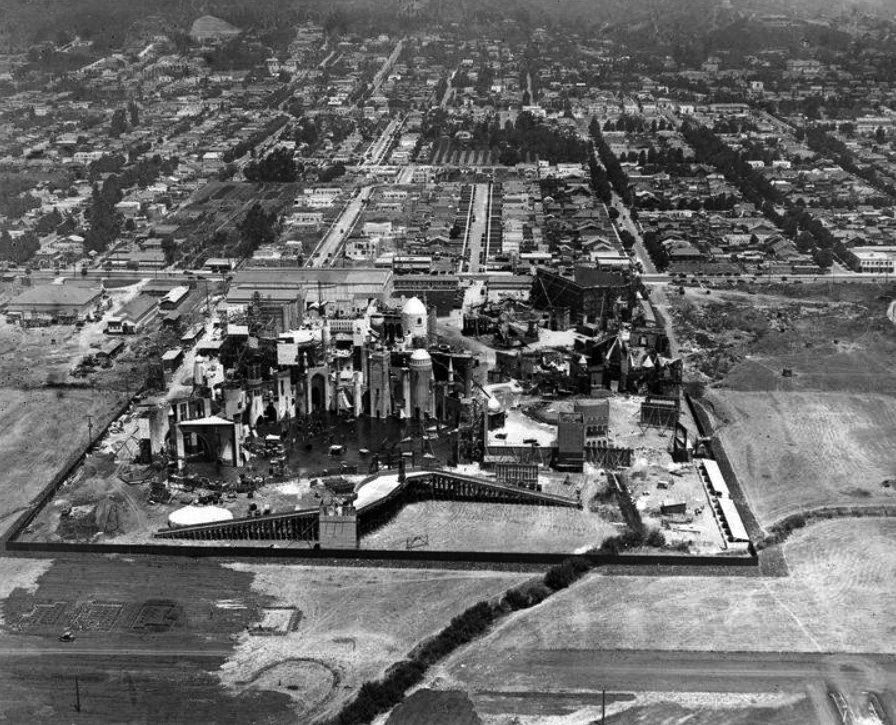 |
|
| (1923)* - Aerial view of the Pickford-Fairbanks Studios located at the corner Santa Monica Boulevard and Formosa Avenue, showing the amazing set for Douglas Fairbanks’ “Thief of Bagdad”. Note all the open land surrounding the studio. |
Historical Notes The 18-acre property on the corner of Santa Monica Boulevard and Formosa Avenue was originally owned by Jesse Durham Hampton, and then became known as the Pickford-Fairbanks Studio. As United Artists began to lure independent producers away from the major studios, many of the producers like Samuel Goldwyn and Joseph Schenck rented offices and stages on the property. In the early 1920s, the lot was renamed the United Artists Studio, though it was operated as a separate entity from United Artists the distribution company.* |
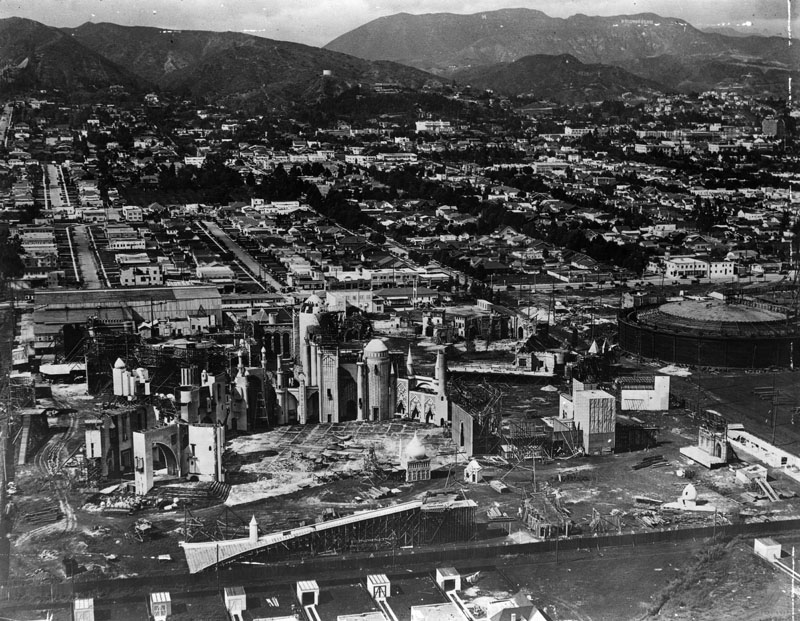 |
|
| (ca. 1924)* - Aerial view of the Thief of Bagdad set at the Pickford-Fairbanks Studios. The Studio was located at Santa Monica Blvd. and Formosa. The Hollywoodland Sign is seen in the distance (upper-right). Note the large circular structure at center-right. It is a gas holder (or Gasometer) which holds natural gas. |
Historical Notes Goldwyn and Schenck financed the expansion of the studio, creating an awkward ownership structure. Pickford and Fairbanks controlled the deed to the land, but Goldwyn and Schenck owned the actual facilities on the lot. In 1935 when Scheck left United Artists, Goldwyn took over his share. |
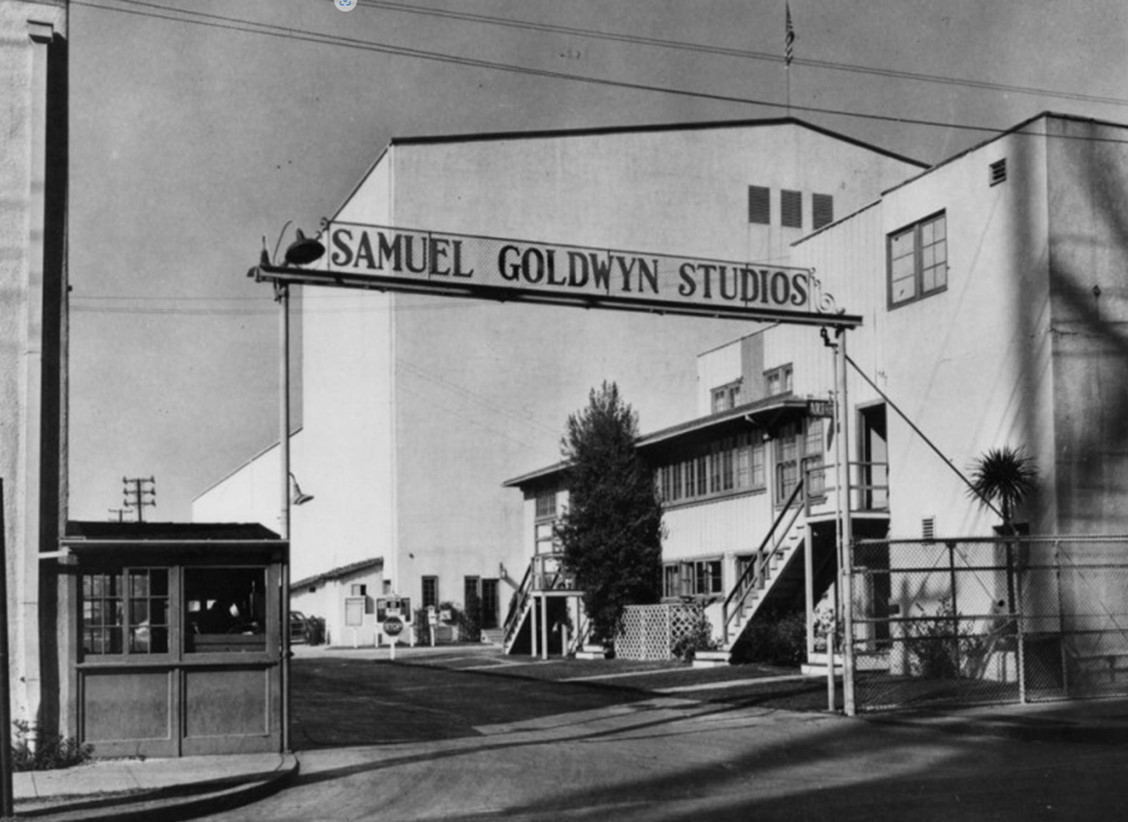 |
|
| (1948)* - The entrance to the Samuel Goldwyn Studios, located at 1041 North Formosa Avenue in Hollywood (previously Pickford-Fairbanks Studio). |
Historical Notes After Douglas Fairbanks died in 1939, leaving his share of the deed to Mary Pickford, Goldwyn sought to rename the lot "Samuel Goldwyn Studio." Pickford and Goldwyn fought over the name and ownership of the property until a court ordered that the lot be auctioned in 1955. James Mulvey, Goldwyn's most trusted business confidant and president of Samuel Goldwyn Inc., outbid Pickford for the property. The lot officially became Samuel Goldwyn Studio and remained so until Warner Brothers purchased the site in 1980.^ Warner Bros. sold the studio lot in 1999 and the name of this studio lot was changed to "The Lot." Across the street is the Formosa Cafe, a legendary Hollywood hangout. |
* * * * * |
Richfield Service Station - West Hollywood
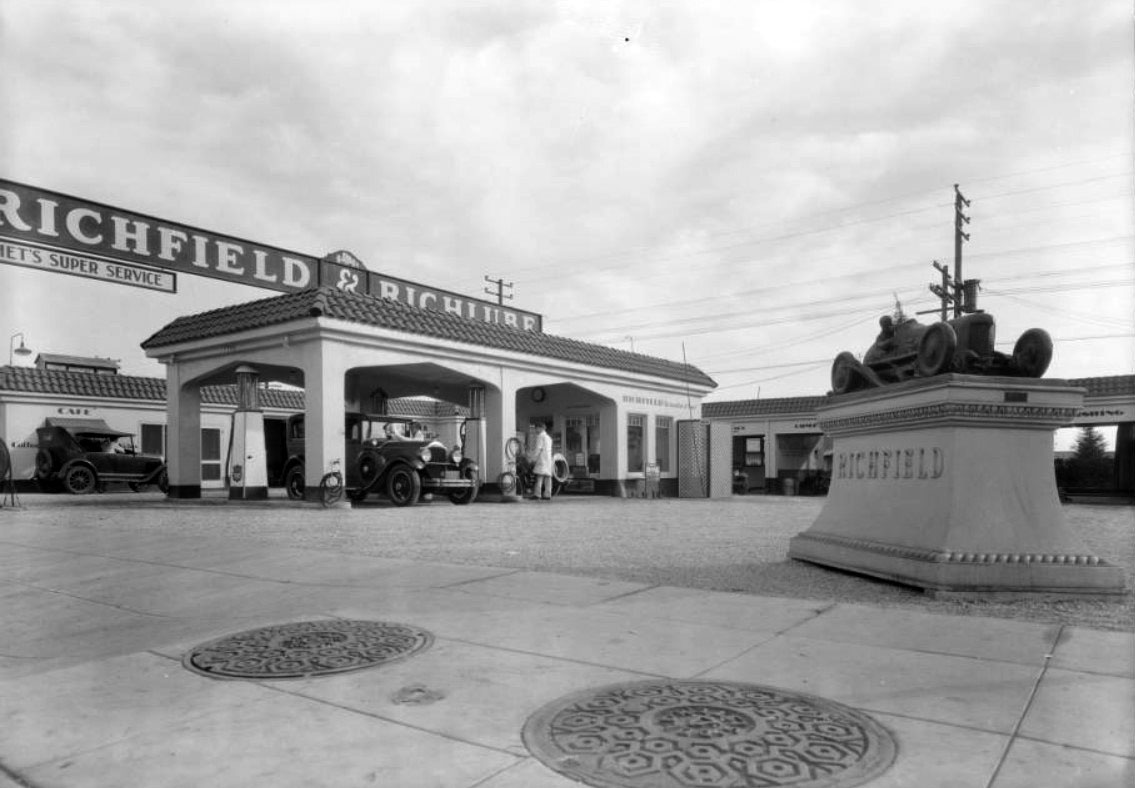 |
|
| (1929)^^ – Richfield Service Station at 7786 Santa Monica Boulevard, West Hollywood (2 blocks East of Fairfax). Note the pedestal-mounted racecar on the right. |
Historical Notes Gas Stations used to be called service stations ... they would rush to your car, check the water and oil, put air in your tires, wash your windows, and pump your gas. Click HERE to see more Early Views of LA Gas Stations. |
.jpg) |
|
| (1929)^^ - Closer view showing the pumps at the Richfield Service Station located on the southeast corner of Santa Monica Boulevard and Ogden Avenue in West Hollywood. Today, a parking lot occupies this space. |
Sunset Boulevard
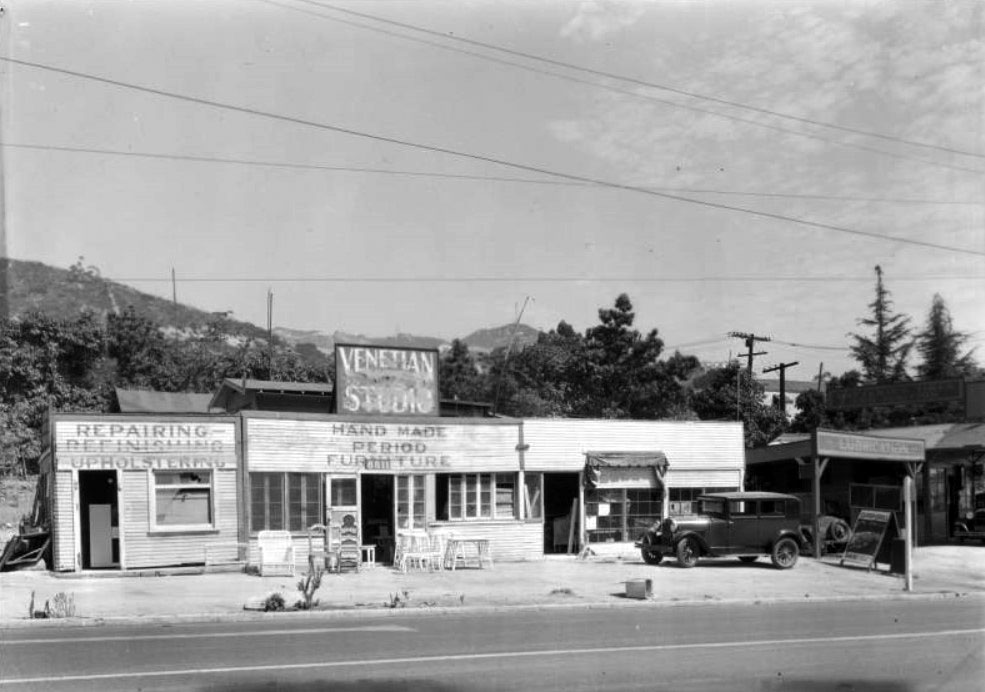 |
|
| (ca. 1935)^^ – View of the Venetian Studio Furniture Store located at 8811 Sunset Boulevard (north side of Sunset between Larrabee Street and Horn Ave). The clapboard store at center is a rundown structure with light-colored walls and a flat roof. Large rectangular windows can be seen along the front side of the building. Several tables and chairs are in front of the building. An early automobile can be seen parked at right near a service station. Legible signs include, from left to right: "Repairing Refinishing Upholstering", "Venetian Studio", "Hand Made Period Furniture", "Lubrication", "Batteries, Tires and Ignitions". This would become the future location of Tower Records (1970 - 2006). |
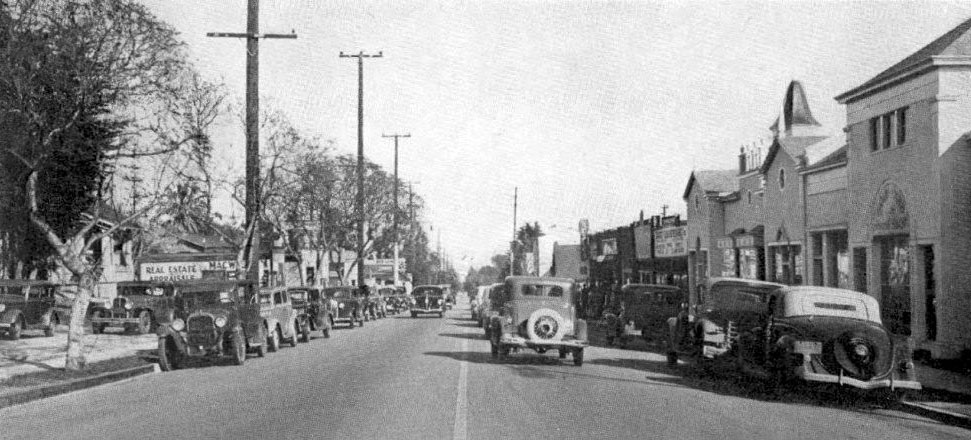 |
|
| (1936)#**# – View looking east along the 8800 block of Sunset Boulevard (San Vicente Blvd to Horn Ave). |
.jpg) |
|
| (1941)^.^ – Same view looking east along the 8800 block of Sunset Boulevard 5 years later, after the street was widened. Click HERE to see contemporary view. |
Sunset Tower
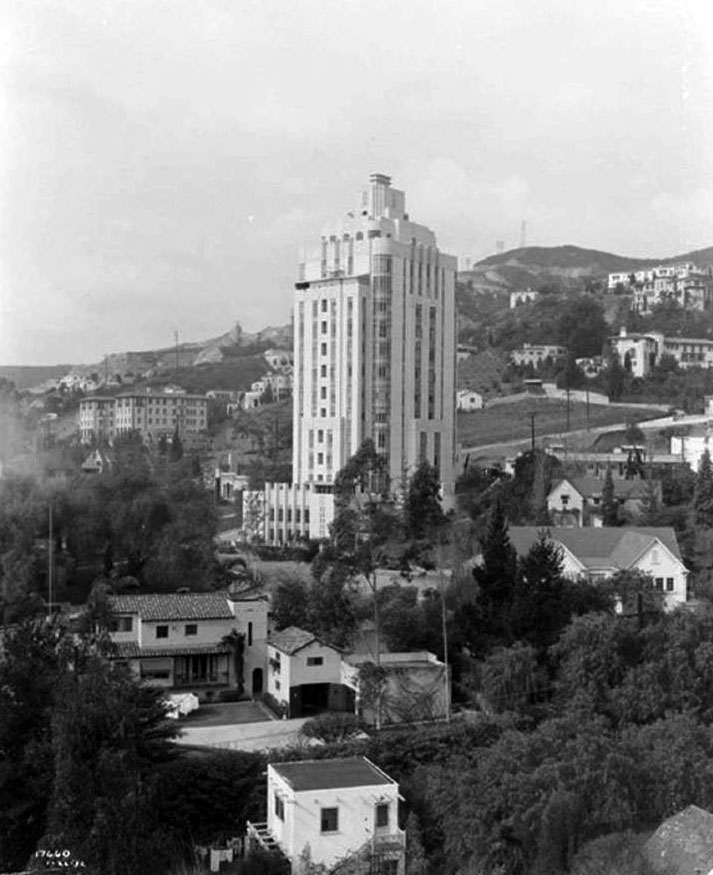 |
|
| (1932)* - View looking northwest showing the Sunset Tower Apartment Building located on Sunset Boulevard with the Hollywood Hills in the background. Note how the area around Sunset Boulevard is still largely residential. |
Historical Notes Designed in 1929 by architect Leland A. Bryant, opened in 1931, the Sunset Tower is considered one of the finest examples of Art Deco architecture in the Los Angeles area. In its early years, it was the residence of many Hollywood celebrities, including John Wayne and Howard Hughes.^ |
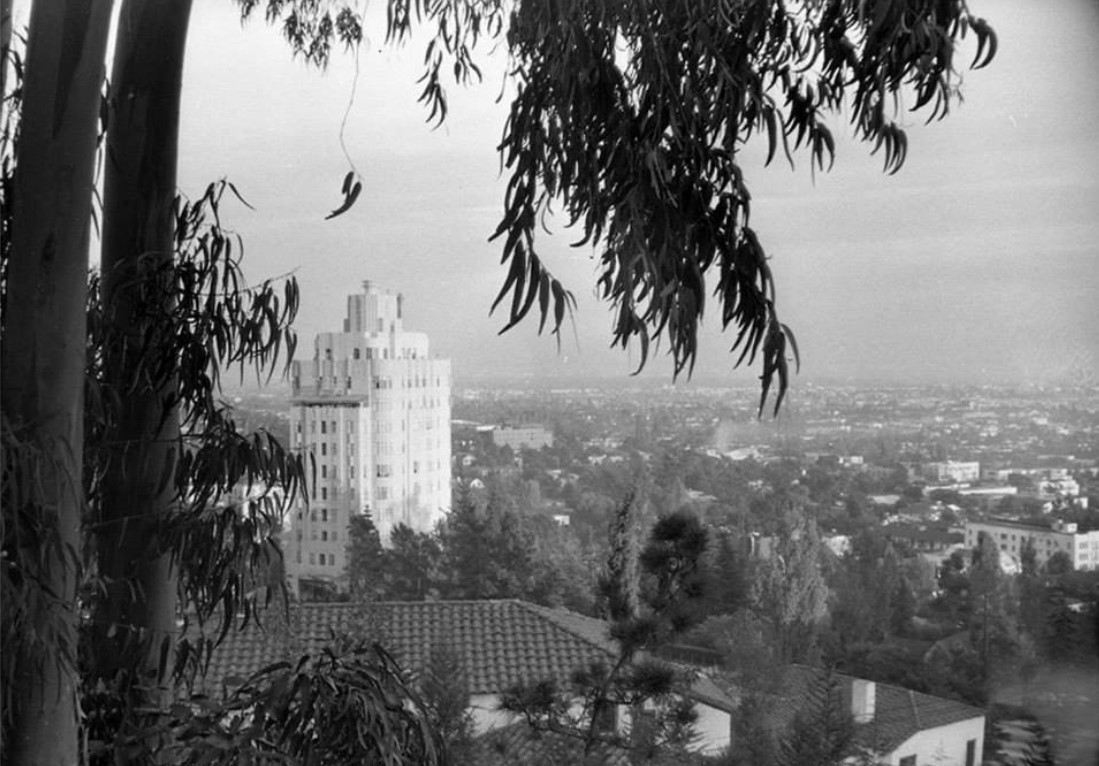 |
|
| (1930s)^^ – View looking down toward the Sunset Tower through a Eucalyptus Tree. The Art Deco apartment building is located at 8358 Sunset Boulevard. |
Historical Notes The building was renamed the Sunset Tower Hotel in 2004, after going through several incarnations as the infamous St. James’s Club and The Argyle. Its dramatic setting and elegant Art Deco architecture, along with its proximity to famous restaurants and nightclubs of the 1930s and 1940s, contributed to its landmark status. |
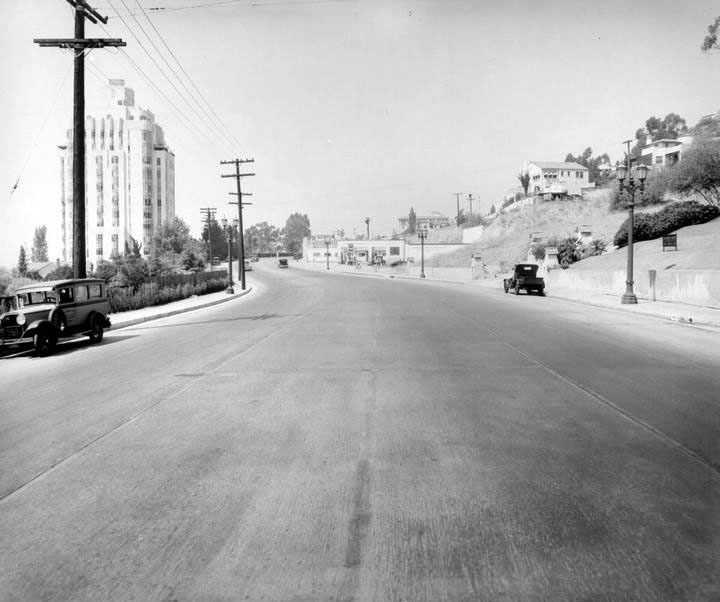 |
|
| (ca. 1930)***^ - View of the Sunset Strip in the early 1930s. The Sunset Tower Apartment Building is the tallest building in the area. Click HERE to see contemporary view. |
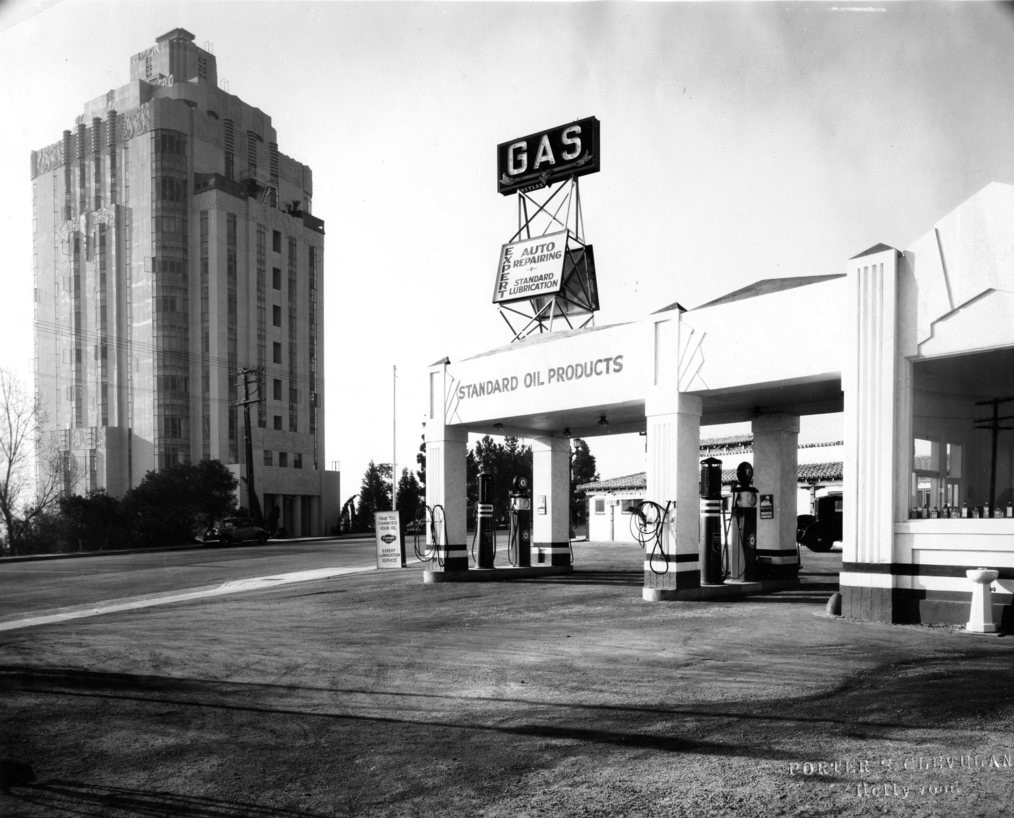 |
|
| (1933)^^ - Sunset Tower Apartments as seen from a gas station across the street. Built partly above and partly below the Strip, the Sunset Tower apartment building was the tallest thing going on the strip when it was built in 1931. |
Historical Notes Originally operated as a luxury apartment hotel, it was one of the first high-rise reinforced concrete buildings in California. When it was completed in August 1931 at a cost of $750,000, the Los Angeles Times reported: "What is described to be the tallest apartment-house in Los Angeles County, rising 15 stories or 195 feet, was completed last week at Kings Road and Sunset Boulevard by W.I. Moffett, general contractor, for E.M. Fleming, owner."^ |
Then and Now
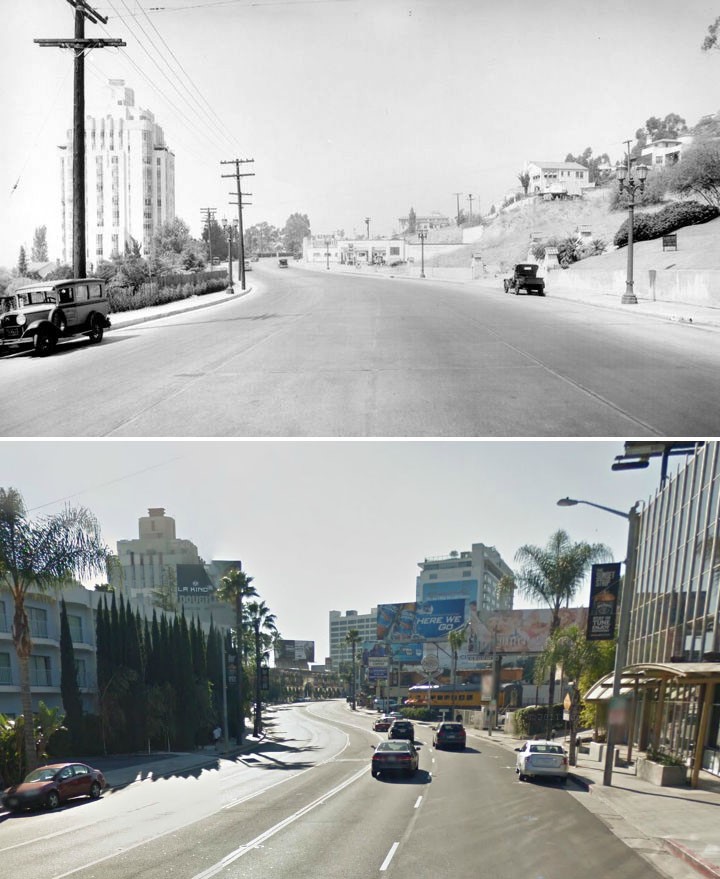 |
|
| (1931 vs 2014)* - The Art Deco Sunset Tower Apartments on the Sunset Strip - Then and Now |
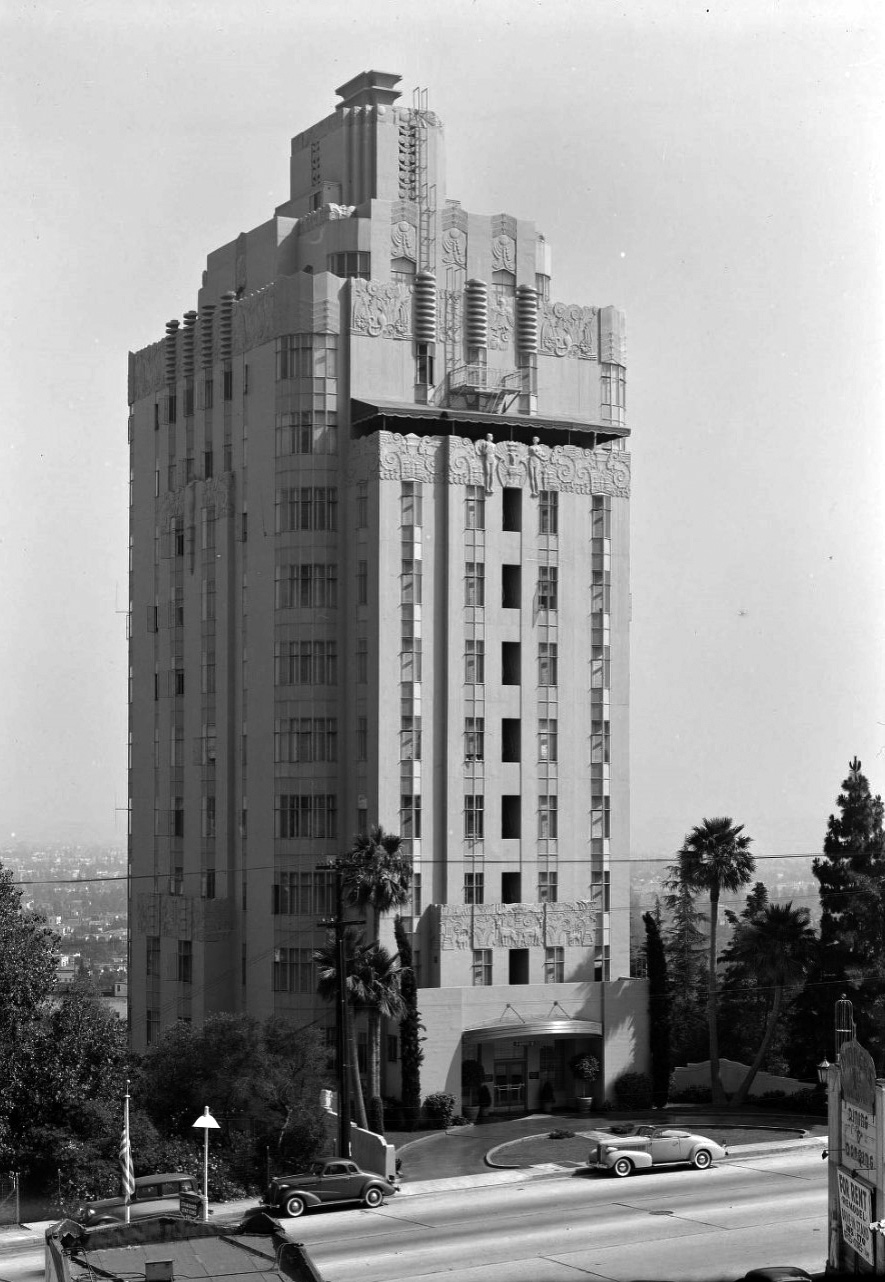 |
|
| (1939)^^ – Early model cars are parked on Sunset Boulevard in front of the Sunset Tower. |
Historical Notes In 1933, the Los Angeles Times ran an article about the trend toward luxurious penthouse apartments in the city and noted that Sunset Tower boasted the city's highest penthouse: "It is the highest in the city and due to the location of the fifteen-story structure that supports it, its tenants live on a level with the tower of the Los Angeles City Hall. Imagine the view!" ^ |
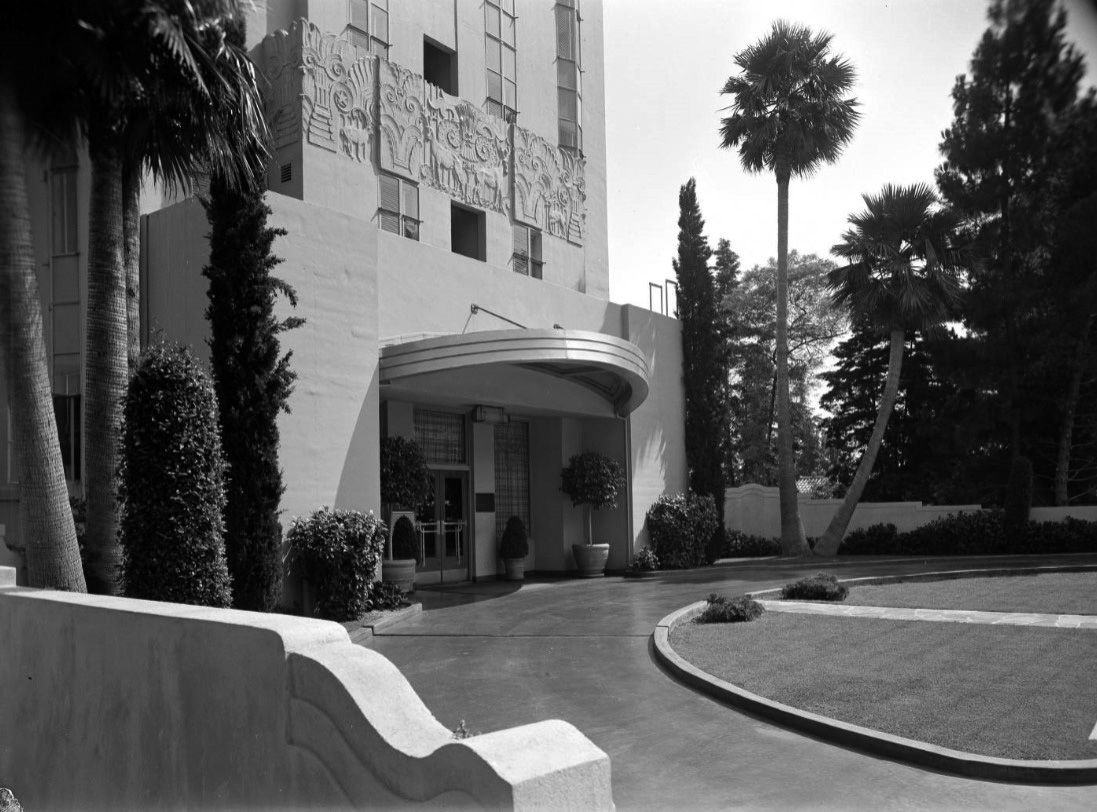 |
|
| (1939)^^ – Close-up view showing the front entrance of the Sunset Tower. |
Historical Notes Marketing the building to Hollywood celebrities, an advertisement in the February 1938 issue of the Screen Actors Guild magazine read: "Faultless in Appointment-The Ultimate in Privacy . . . Hollywood's Most Distinguished Address." |
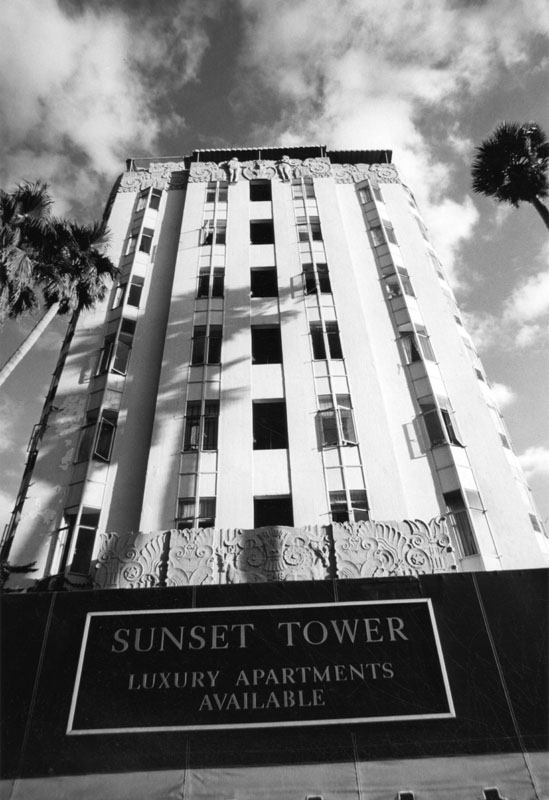 |
|
| (1930s)* - An Art Deco masterpiece, the Sunset Tower 'Luxury' Apartments, located at 8358 Sunset Boulevard. |
Historical Notes John Wayne, Howard Hughes, Frank Sinatra, Jerry Buss and novelist James Wohl lived in the penthouse at different times, and Hughes reportedly also rented some of the lower apartments for his girlfriends or mistresses. Other former residents include Clark Gable, Errol Flynn, Marilyn Monroe, Michael Caine, Quincy Jones, Roger Moore, Zsa Zsa Gabor, Billie Burke, Joseph Schenck, Paulette Goddard, Zasu Pitts, George Stevens, Preston Sturges, and Carol Kane.^ |
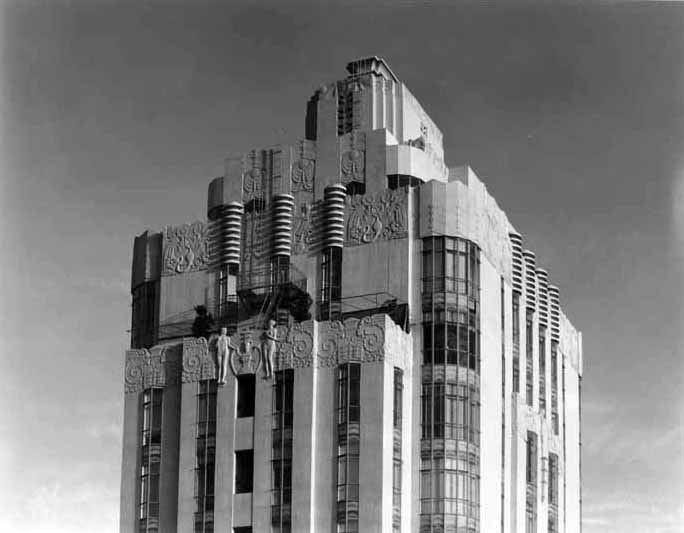 |
|
| (1936)* – The art deco Sunset Tower is considered one of the finest examples of the Streamline Moderne form of Art Deco architecture in Southern California. |
Historical Notes In their guide to Los Angeles architecture, David Gebhard and Robert Winter wrote that "this tower is a first class monument of the Zig Zag Moderne and as much an emblem of Hollywood as the Hollywood sign." It is situated in a commanding location on the Sunset Strip with views of the city and is decorated with plaster friezes of plants, animals, zeppelins, legendary creatures and Adam and Eve.^ |
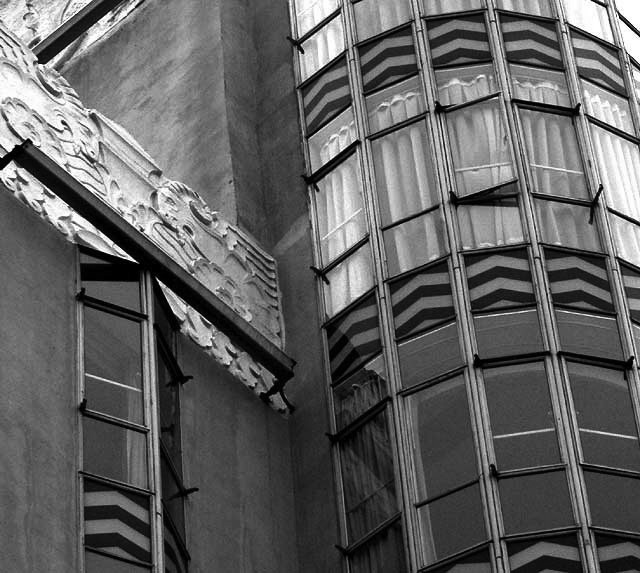 |
|
| (2009)^ – Close-up detail view showing the Zig-Zag design on the windows of the Art Deco Sunset Tower. Photo Courtesy of Alan M. Pavlik - 'Just Above Sunset'. |
Historical Notes The building is decorated with plaster friezes of plants, animals, zeppelins, mythological creatures and Adam and Eve. |
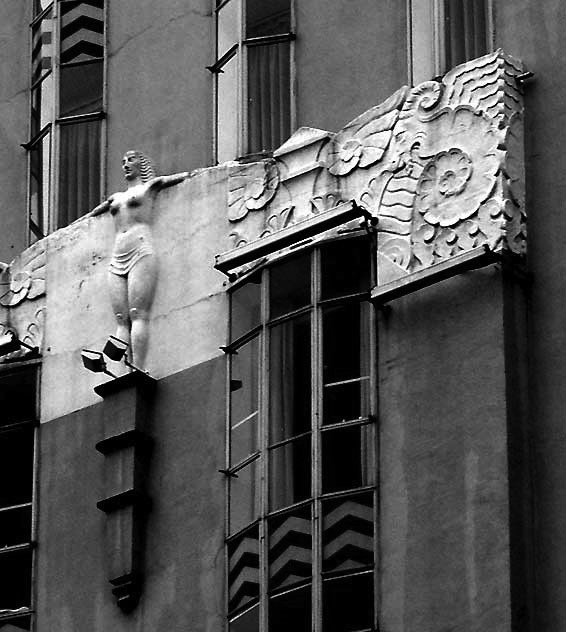 |
|
| (2009)^ – Close-up detail view showing the bas-relief figures and Art Deco Zig-Zag design of the Sunset Tower. Photo Courtesy of Alan M. Pavlik - 'Just Above Sunset'. |
Historical Notes Architect Leland Bryant specialized in luxury apartments, but the Sunset Tower was his crowning achievement. His work was predominantly in Period Revival, but with this building he proved that he was equally adept with the then contemporary Deco style.* |
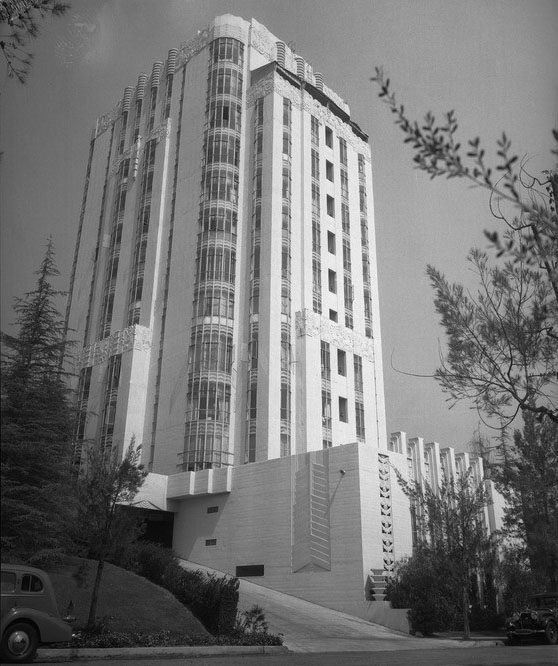 |
|
| (1940s)* – View looking up at the Sunset Tower Apartments from the De Longpre Avenue side of the building. |
Historical Notes To attract a demanding clientele, the Sunset Tower incorporated the latest in both technology and design. There were modern conveniences, like outlets in every bathroom for electric shavers, and the windows were made larger to take advantage of the spectacular views.* |
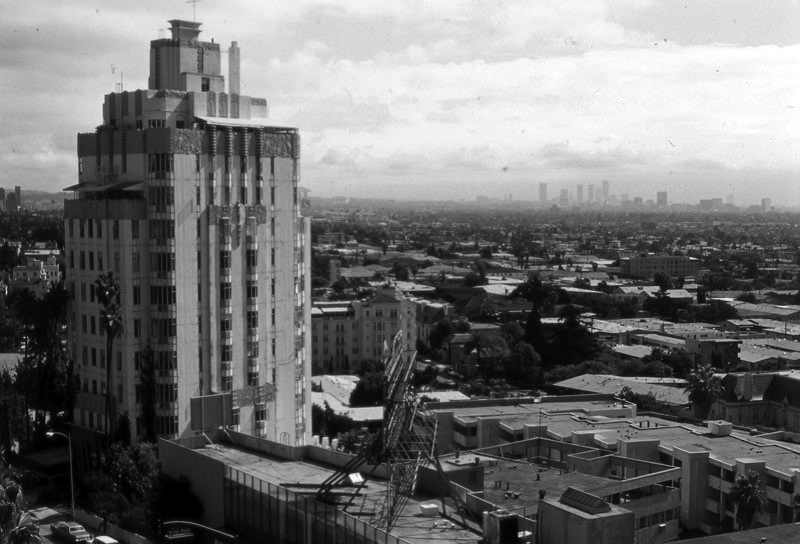 |
|
| (1979)* - Looking out upon West Hollywood from a balcony at the Sunset Hyatt Hotel (later Andaz West Hollywood), showing the neighborhood and the iconic Sunset Tower; Downtown Los Angeles is partially visible through the haze on the right. |
Historical Notes After a period of decline in the early 1980s, the building was renovated and has been operated as a luxury hotel under the names The St. James's Club, The Argyle, and most recently the Sunset Tower Hotel. |
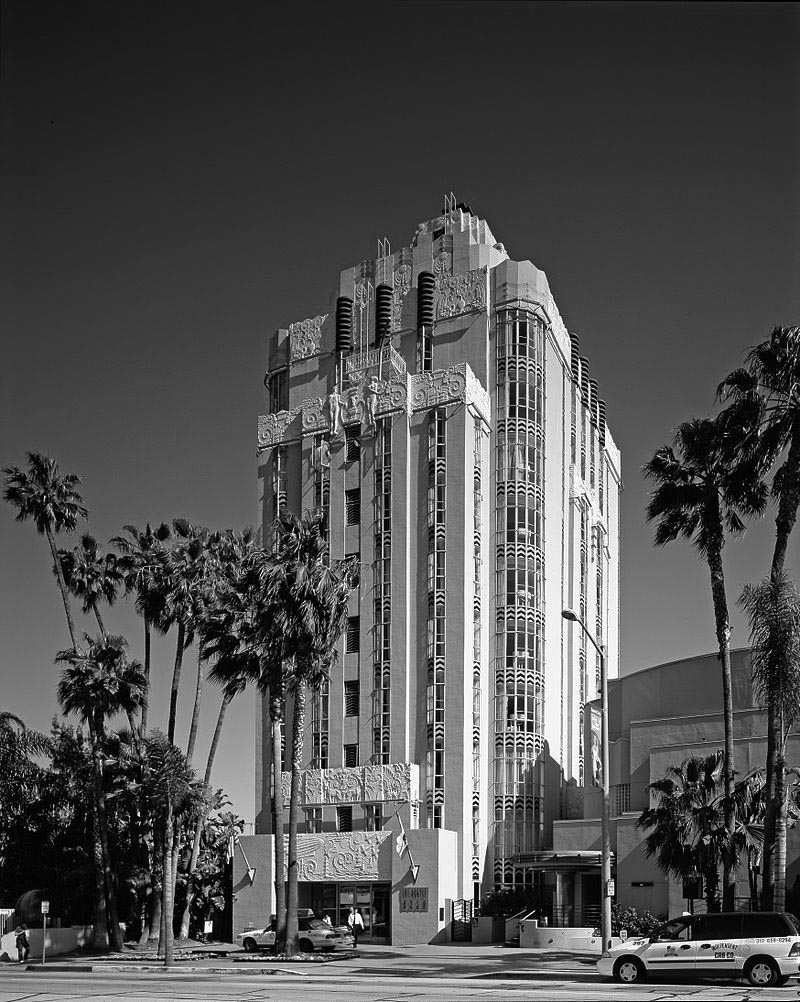 |
|
| (2005)*^ – View showing the Sunset Tower Hotel located at 8358 Sunset Boulevard in West Hollywood. Photo by Carol M. Highsmith via Wikipedia |
Historical Notes The building was saved from deterioration and possible demolition when it was purchased in 1985 from architect David Lawrence Gray, FAIA by Peter de Savary who promised to "lovingly restore" the building to its former glory by spending $25 million to convert the building into the first American branch of his luxury hotel chain, the St. James's Club. The Lancaster Group purchased the hotel from de Savary in 1992, renaming it the Argyle. In 2004, Jeff Klein purchased the hotel. Klein hired designer Paul Fortune to renovate the hotel, adding more modern amenities, and restored its original name.^ |
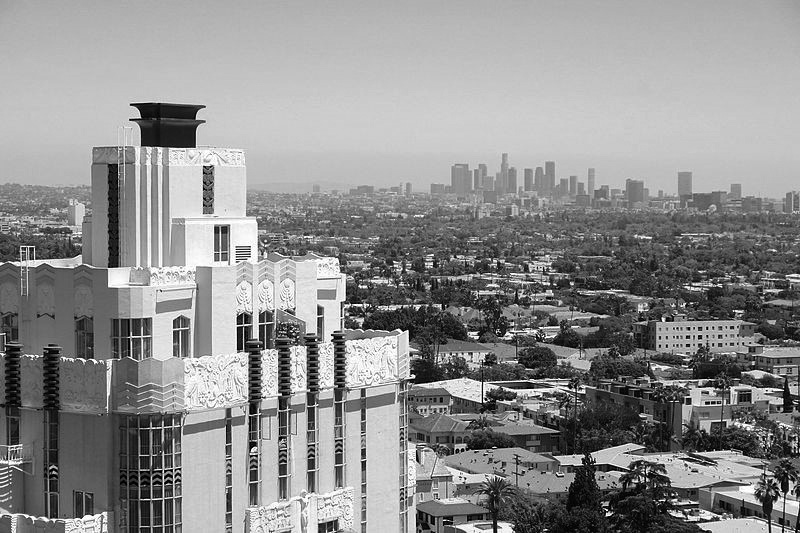 |
|
| (2011)^ - Sunset Tower, 8358 Sunset Blvd in West Hollywood, with the Downtwon LA skyline in the background. Photo by Mike Jiroch via Wikipedia |
Historical Notes The Sunset Tower building was listed on the National Register of Historic Places in 1980. In the 1990's the Sunset Tower Hotel was known as the Argyle Hotel. Before that it was known as the St. James Club and Hotel, a grand 13 story, the Strip's 1st high-rise (built in 1931), and one of Hollywood 's best examples of Art Deco design. Virtually every star in Hollywood stayed here at one time or another. It was a favorite of Howard Hughes, who kept a number of suites here fore his various girlfriends; other guest included Clark Gable, Jean Harlow, Marilyn Monroe, Frank Sinatra and John Wayne (who is said to have kept a cow on the balcony outside his penthouse suite for fresh milk). |
* * * * * |
Club Casanova
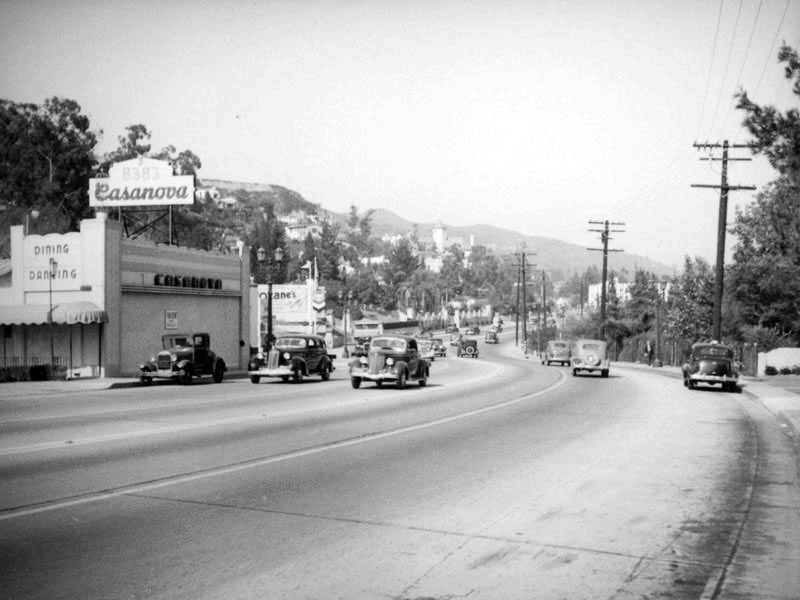 |
|
| (ca. 1936)* - View of Sunset Boulevard in the city of West Hollywood showing the Casanova Club located at 8383 Sunset Blvd. A large castle-like tower can be seen in the distance (center-top). This is the famous Chateau Marmont Hotel, located at 8221 Sunset Blvd. |
Historical Notes Sunset Boulevard, a long winding thoroughfare that begins in downtown Los Angeles and runs westward over 20 miles, ends at the Pacific Ocean near Malibu. The best-known portion of the boulevard is the mile and a half stretch between Hollywood and Beverly Hills, known as "The Sunset Strip".* The Chateau Marmont Hotel was a great castle on the hill inspired by the architecture of the Loire Valley in France was built in 1927, opened in 1929 as an apartment house, and was changed to a hotel in 1931, becoming the "Hotel to the Stars".* |
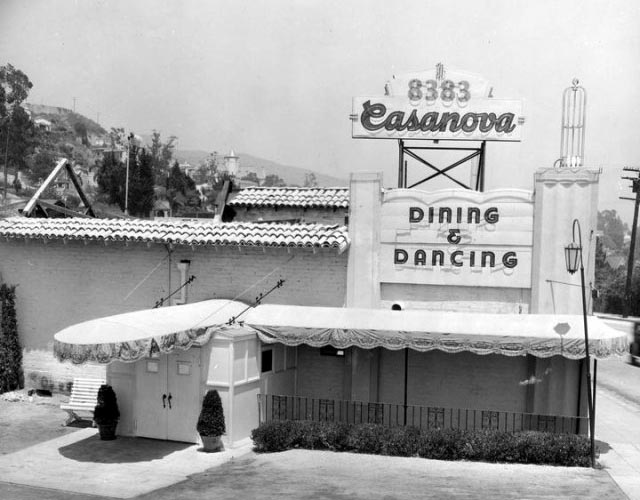 |
|
| (ca. 1936)**## – Close-up view showing the Club Casanova located at 8383 Sunset Boulevard on the Sunset Strip. |
Historical Notes The Club Casanova opened in August 1936 and lasted only 16 months. In 1937, it became U-Gene’s Bagdad Café, then two years later, Bow’s Inn. Today, the Saddle Ranch Chop House stands at this location, on the N/E corner of Sunset and N. Kings Rd. |
Players Nightclub
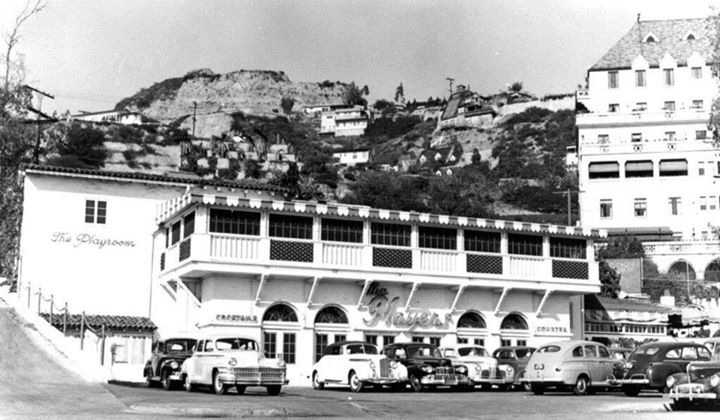 |
|
| (ca. 1940)** - View showing the Players Nightclub at 8225 Sunset Boulevard, opened by director Preston Sturges during the Summer of 1940. The Chateau Marmont Hotel is on the right. |
Historical Notes In 1940 Preston Sturges, successful Hollywood writer and director, opened Players Nightclub. Stars and writers made it their home base. Humphrey Bogart, Dorothy Parker, Robert Benchley, George S. Kaufman (writer of several Marx Brothers movies), and Donald Ogden Stewart (screenwriter of 1938’s Marie Antoinette and 1940’s The Philadelphia Story) all got smashed on The Players’ drinks, which were said to be the most potent in town. Barbara Stanwyck (Sturges’ leading lady in The Lady Eve), Orson Welles (who stayed next door at the Chateau Marmont when he first came to Hollywood), Joel McCrea (who starred in three of Sturges’ pictures), Rudy Vallee, director William Wyler, and writer William Faulkner were all regulars at their friend’s establishment. Multi-millionaire Howard Hughes became a regular guest. He often dined on the top floor, frequently preferring to eat alone.* |
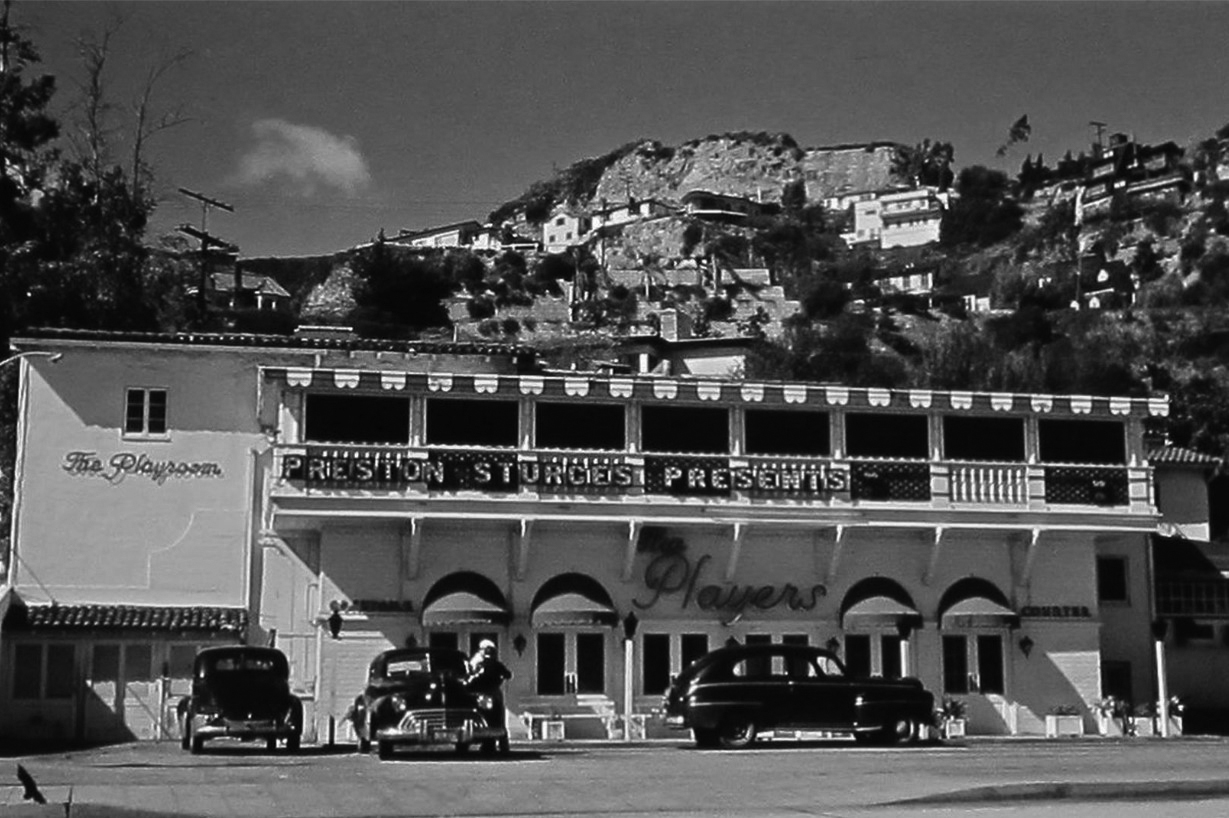 |
|
| (1940s)^#^^ - Closer view of Players Nightclub on the Sunset Strip with homes perched on hillside in the background. Sign on front balcony reads: "Preston Sturges Presents" |
Historical Notes At its peak during WWII, The Players was a three-level extravaganza with a restaurant on each floor. There was a barbershop on the mezzanine level. Sturges also built a dinner theatre/dance floor with a revolving, hydraulic stage. Later still, he added a burger stand for the tourist trade.* |
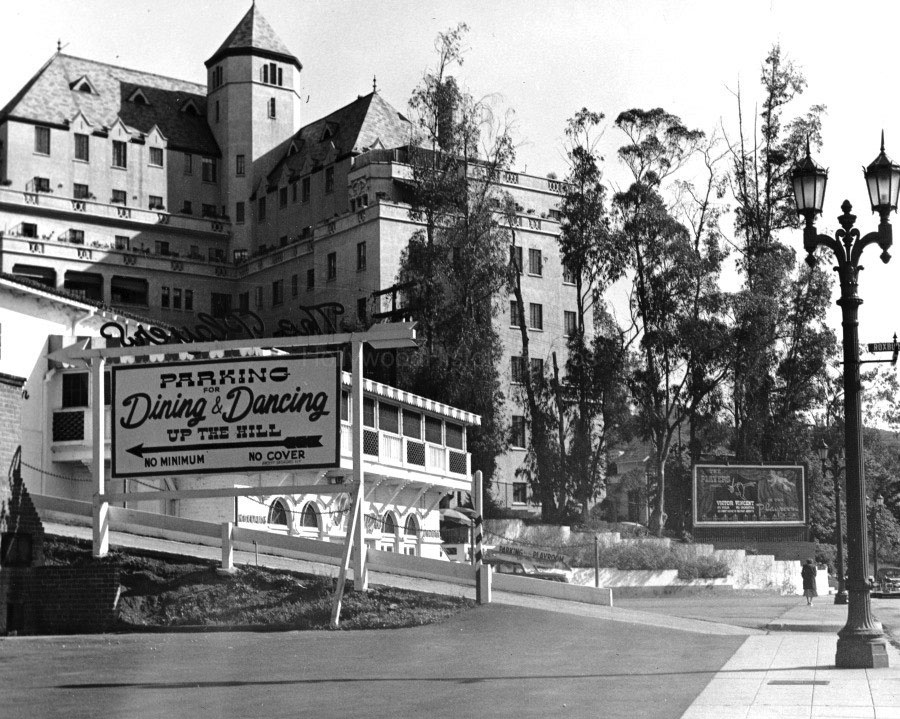 |
|
| (ca. 1940)** – View showing the Chateau Marmont with the Players Nightclub seen in the left foreground. Note the ornate street light on the right. These were called ‘Metropolitan’ streetlights found mostly in Hollywood. |
Historical Notes The Players never broke even and, by 1953, the burger stand was the only part of The Players still open for business.* |
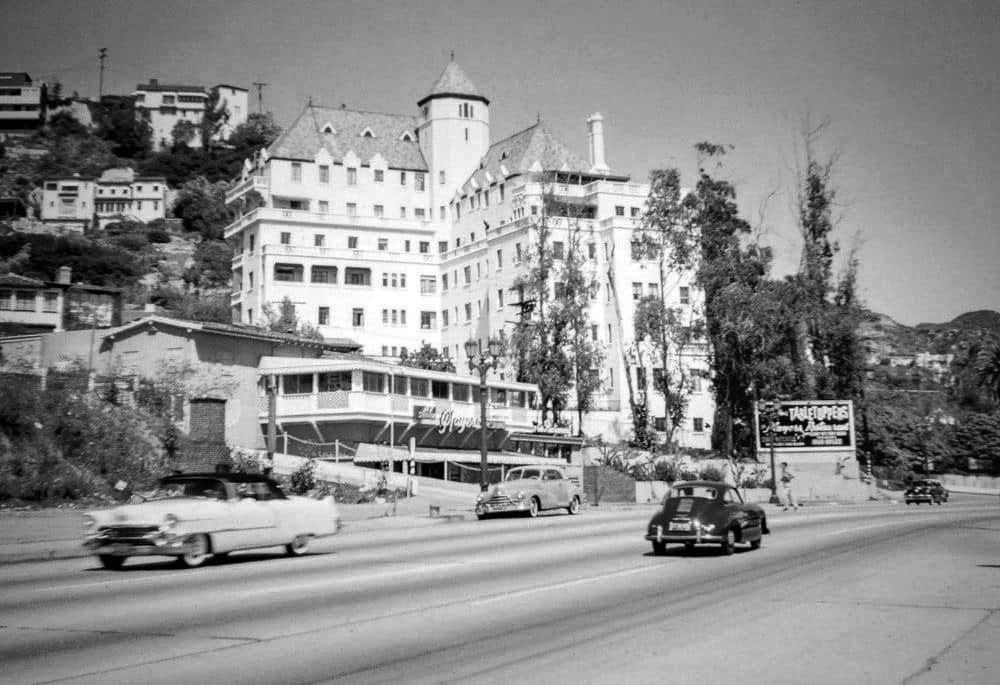 |
|
| (ca. 1957)^ – A Cadillac and Porsche drive by the Players Nightclub at 8225 Sunset Boulevard with the Chateau Marmont in the background. |
Historical Notes Player’s Club didn't make it past the late 1950s. It later became the Imperial Gardens, the Roxbury and Miyagi's. In 2012 Harry Morton, oil-slick heir of Hard Rock Café founder Peter Morgan, chose the site for the second location of his Mexican restaurant chain The Pink Taco. During renovations his work crews discovered the revolving stage, the dance floor and the infamous secret tunnel connecting to the Chateau Marmont.^ |
Then and Now
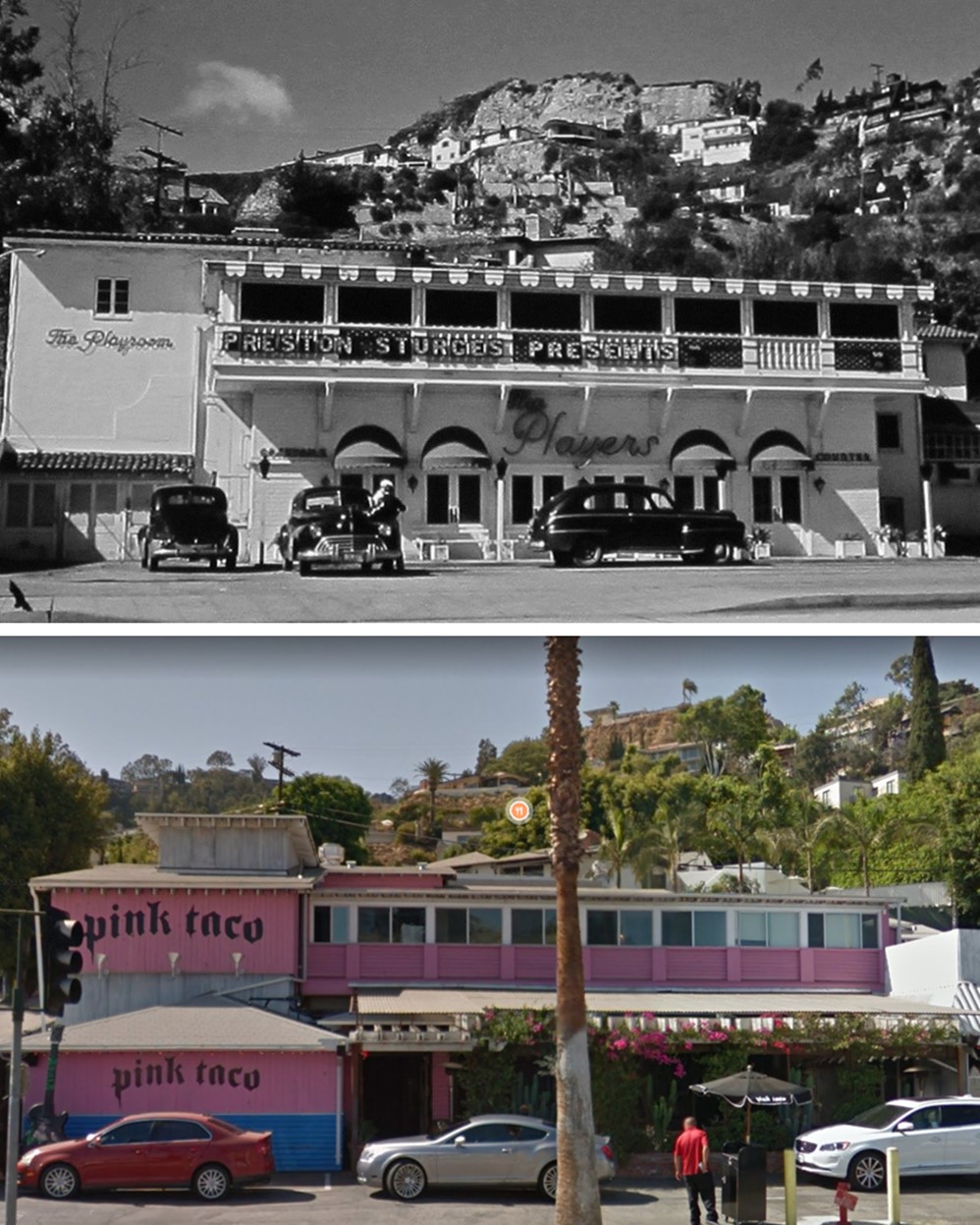 |
|
| (1940s vs. 2016)* – Players Nightclub on the Sunset Strip, now a Pink Taco Restaurant located at 8225 Sunset Boulevard. |
Chateau Marmont Hotel
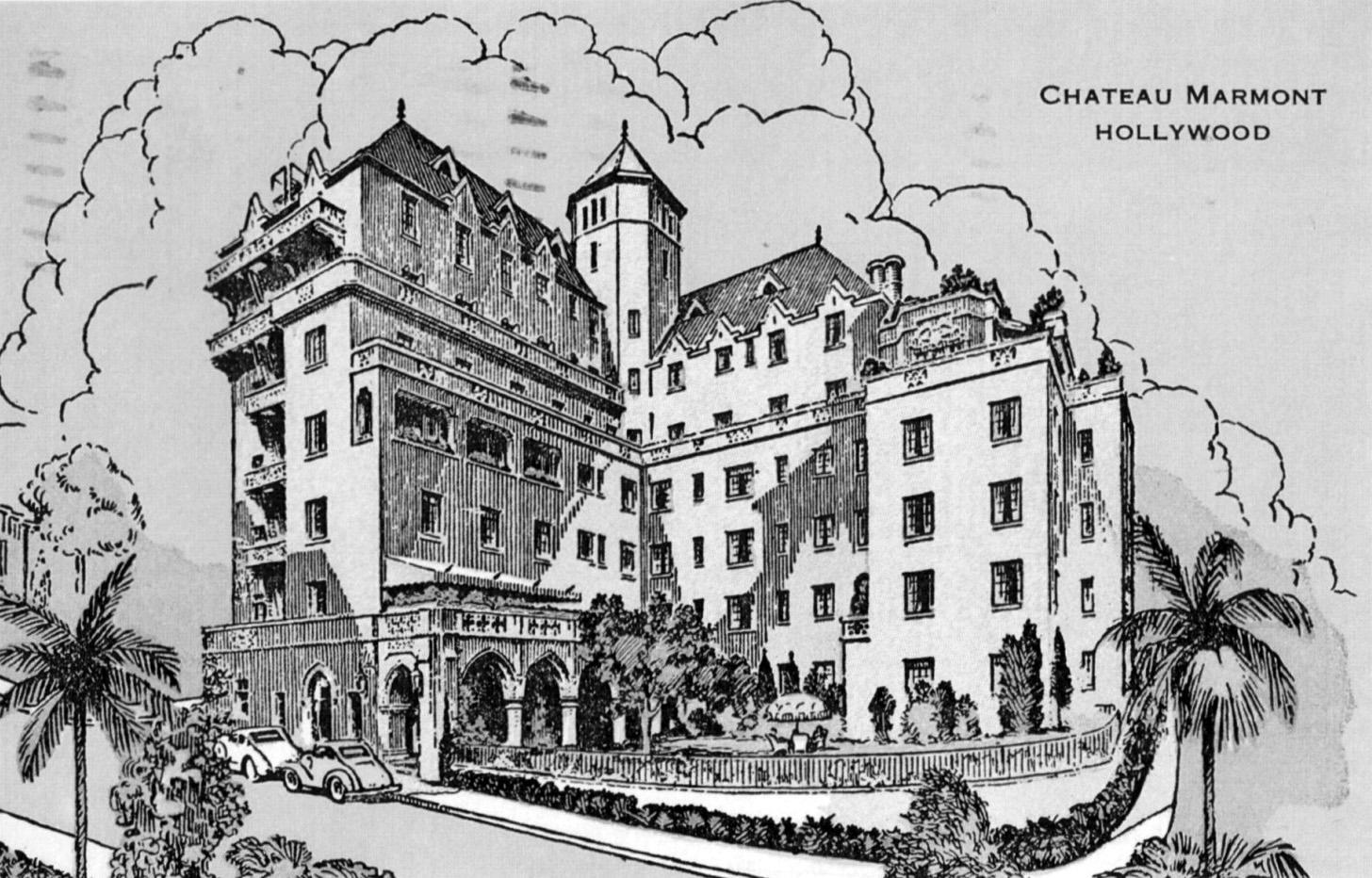 |
|
| (1930s)* – Postcard image of the Chateau Marmont in West Hollywood. |
Historical Notes In 1926 Fred Horowitz, a prominent Los Angeles attorney, chose the site at Marmont Lane and Sunset Boulevard to construct an apartment building. Horowitz had recently traveled to Europe for inspiration and returned to California with photos of a Gothic Chateau along the Loire River. In 1927 Horowitz commissioned his brother-in-law, European-trained architect Arnold A. Weitzman, to design the seven-story, L-shaped building based on his French photos. When deciding upon a name for the building, Chateau Sunset and Chateau Hollywood were rejected in favor of Chateau Marmont, a name conceived by the small street running across the front of the property.* |
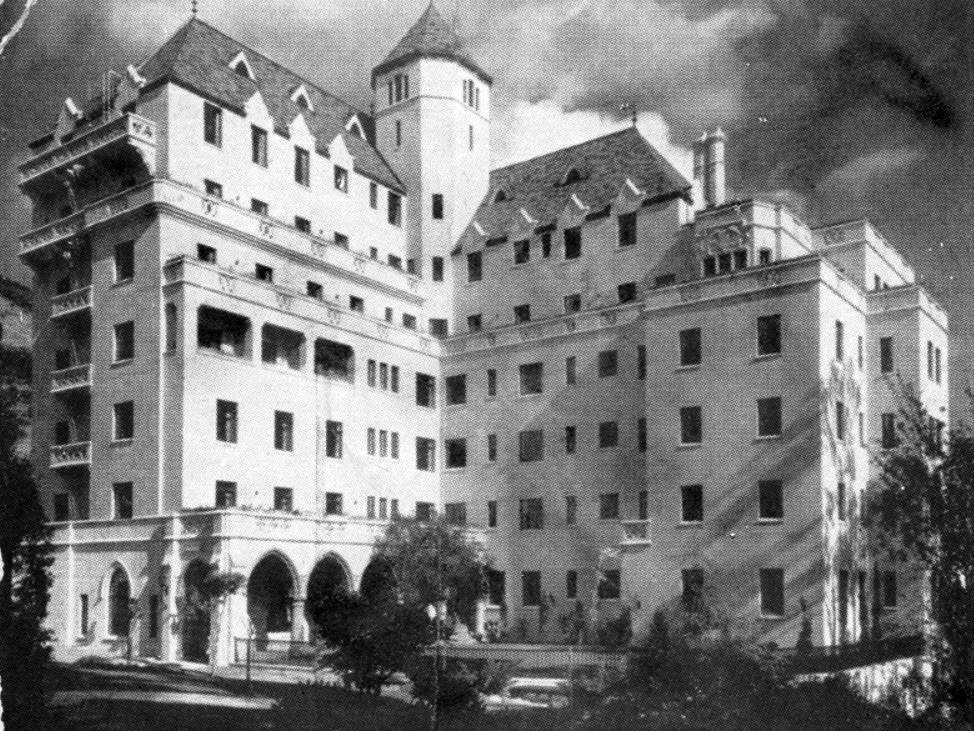 |
|
| (1940s)* – Photo showing the Chateau Marmont Hotel located at 8221 Sunset Boulevard. |
Historical Notes On February 1, 1929, Chateau Marmont opened its doors to the public as the newest residence of Hollywood. Local newspapers described the Chateau as “Los Angeles’s newest, finest and most exclusive apartment house ... superbly situated, close enough to active businesses to be accessible and far enough away to insure quiet and privacy.” Due to the high rents and inability to keep tenants for long-term commitments during the depression, Fred Horowitz chose to sell the apartment building to Albert E. Smith for $750,000 in cash. The following year, Chateau Marmont was converted into a hotel. The apartments became suites with kitchens and living rooms. The property was also refurbished with antiques from depression-era estate sales.* |
 |
|
| (ca. 1940)** – View showing the Chateau Marmont with the Players Nightclub seen in the left foreground. Note the ornate street light on the right. These were called ‘Metropolitan’ streetlights found mostly in Hollywood. |
Historical Notes There existed a secret tunnel connecting the Players Club to the Chateau Marmont. |
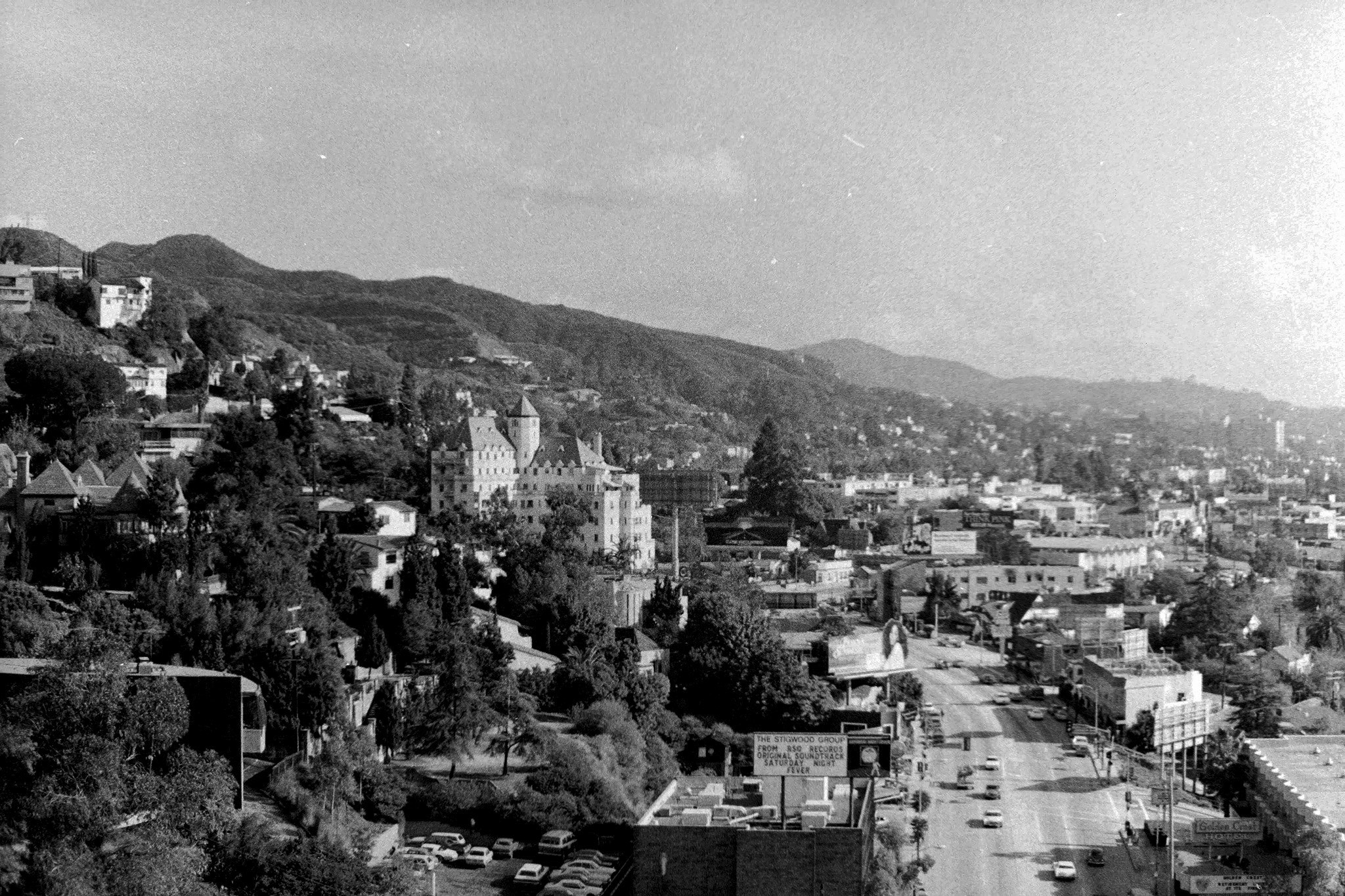 |
|
| (1977)^.^ – View looking east on the Sunset Strip showing the beautiful Chateau Marmont standing out like a castle in the Hollywood Hills. Photo courtesy of Jeff Katz |
Historical Notes Designed and constructed to be earthquake proof, Chateau Marmont survived major earthquakes in 1933, 1953, 1971, 1987 and 1994 without sustaining any major structural damage. Nine Spanish cottages were built next to the hotel in the 1930s and were acquired by the hotel in the 1940s. Craig Ellwood designed two of the four bungalows in 1956, after he completed Case Study Houses.* |
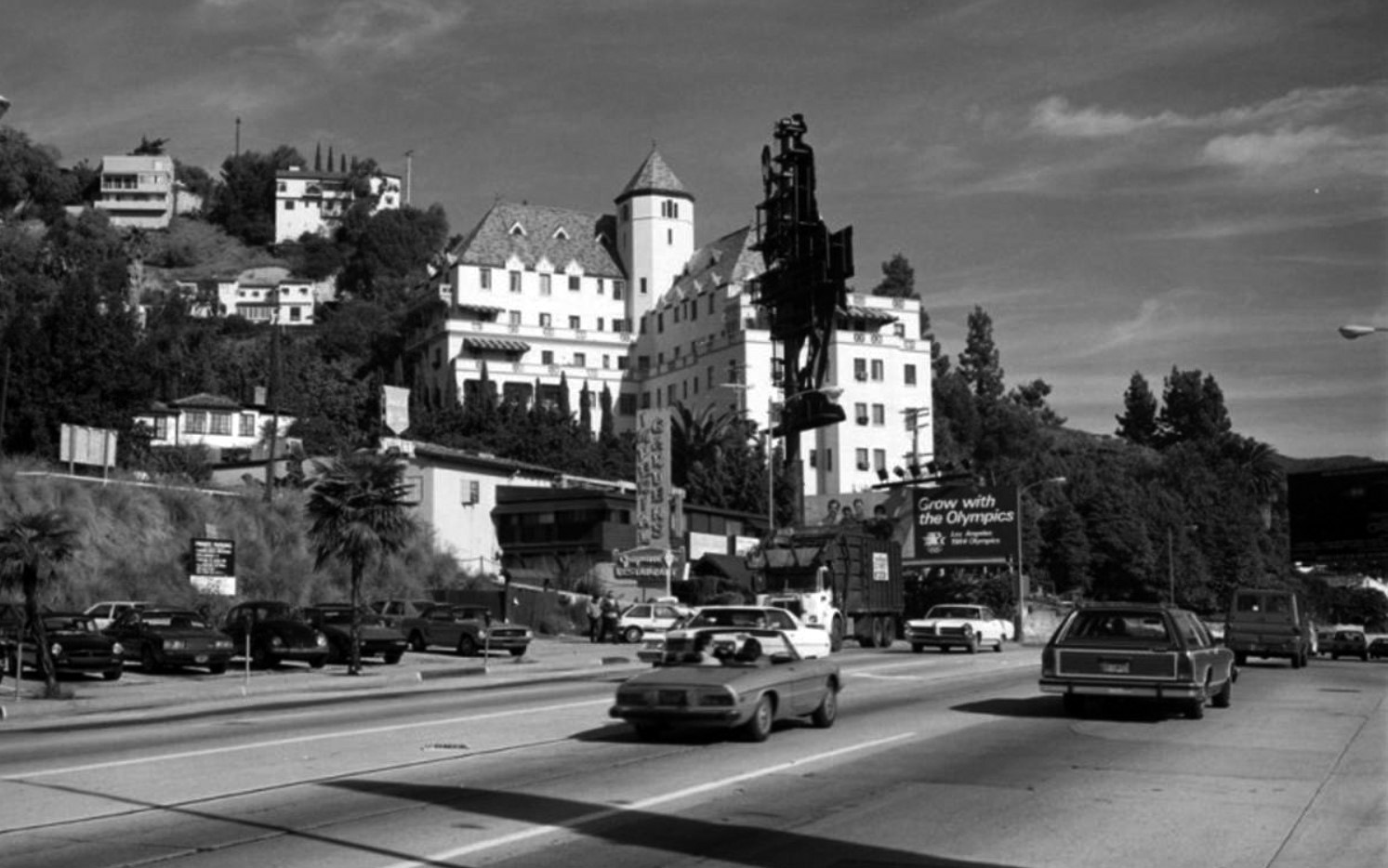 |
|
| (1983)* - The Chateau Marmont Hotel, inspired by the architecture of the Loire Valley in France, and the Imperial Gardens Japanese Restaurant are shown above Sunset Blvd. There is a billboard advertising the 1984 Olympic Games to be held in Los Angeles. The back of the Marlboro Man sign can also be seen. |
Historical Notes With its external appearance of a castle or Gothic fort, combined with its residential past, incredibly thick walls, discreet entry, and highly protective staff who treated guests like members of the family, the Chateau Marmont became the ideal hideout. European guests found the architecture familiar and comforting, sexual outsiders felt accepted, the emotionally shy were shielded, and anyone else with a reason to hide simply blended into the woodwork—from the start there was the feeling of a shared sensibility. Greta Garbo felt comfortable here, as did Howard Hughes.^ |
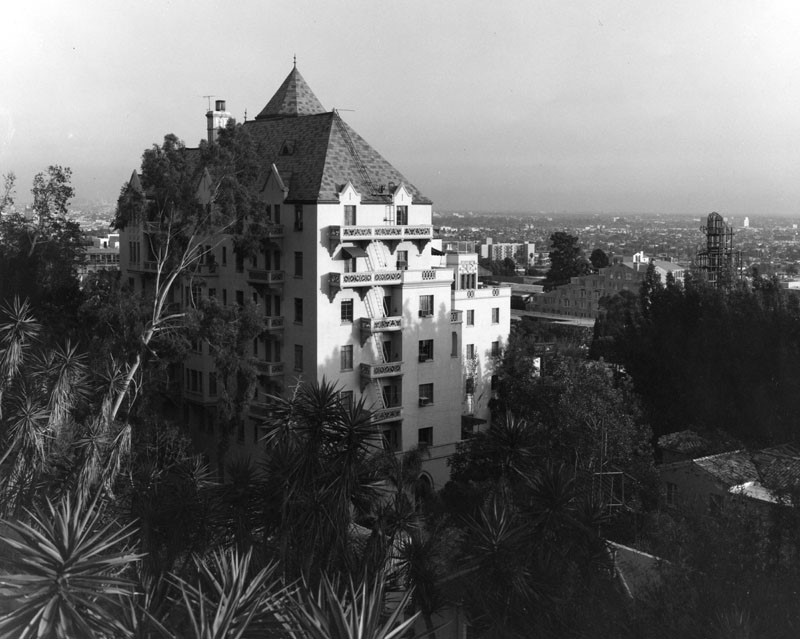 |
|
| (ca. 1995)* – View of the Chateau Marmont Hotel as seen from the Hollywood Hills looking southeast. |
Historical Notes Members of Led Zeppelin rode their motorcycles through the lobby in the 1960s. On March 5, 1982, comedian John Belushi died from a speedball injection in Bungalow No. 3. On January 23, 2004, photographer Helmut Newton, who lived at the hotel, lost control of his Cadillac and crashed into the driveway wall. He was killed. There is a commonly-denied and non-denied story that Benicio Del Toro and Scarlett Johansson hooked up in the elevator the night before the 2004 Oscars.^ |
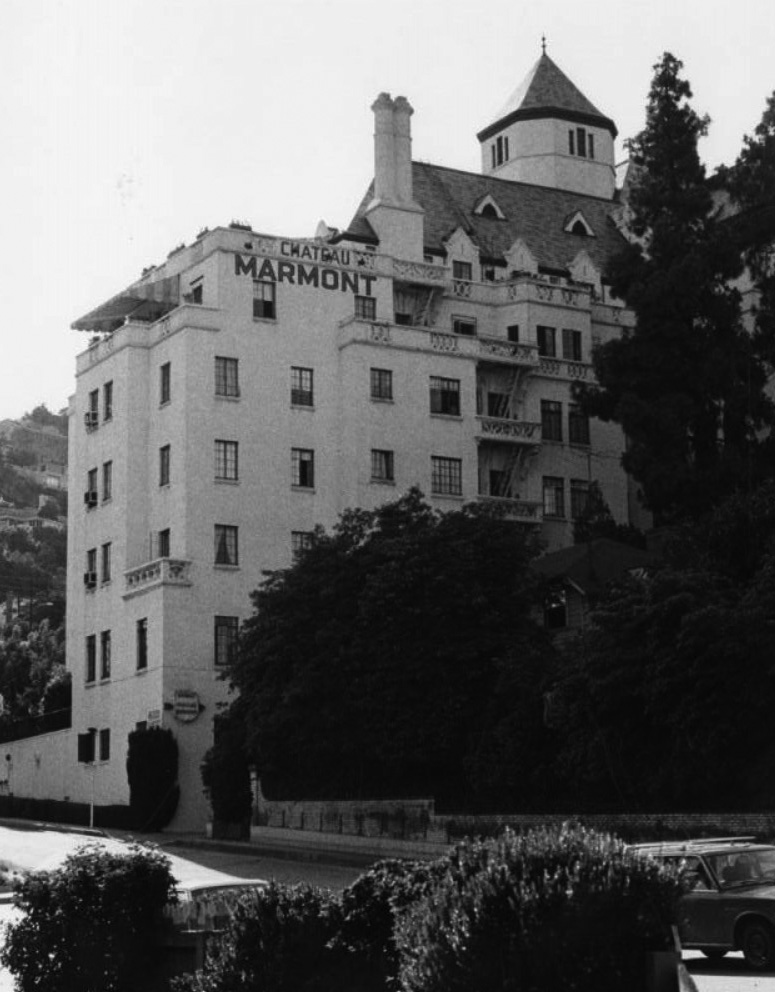 |
|
| (ca. 1984)* - Chateau Marmont, one of the most famous buildings in the Hollywood area. Located on the Sunset Strip in West Hollywood, it has hosted some of the world's greatest entertainment figures and members of many royal families as well. The architecure incorporates French and Spanish-style elements throughout. Photo by Roy Hankey |
Historical Notes Lindsay Lohan shacked up at the Chateau in the midst of her (first) drunk driving scandal. During her public meltdown phase, in September 2007, Britney Spears was temporarily banned from the Chateau for smearing her face with food, disgusting fellow diners. Lohan was finally banned in 2012 (she’d been living in Suite No. 33) after racking up a $46,350.04 tab on stuff like cigarettes, candles, iPhone chargers, and copies of Architectural Digest.^ |
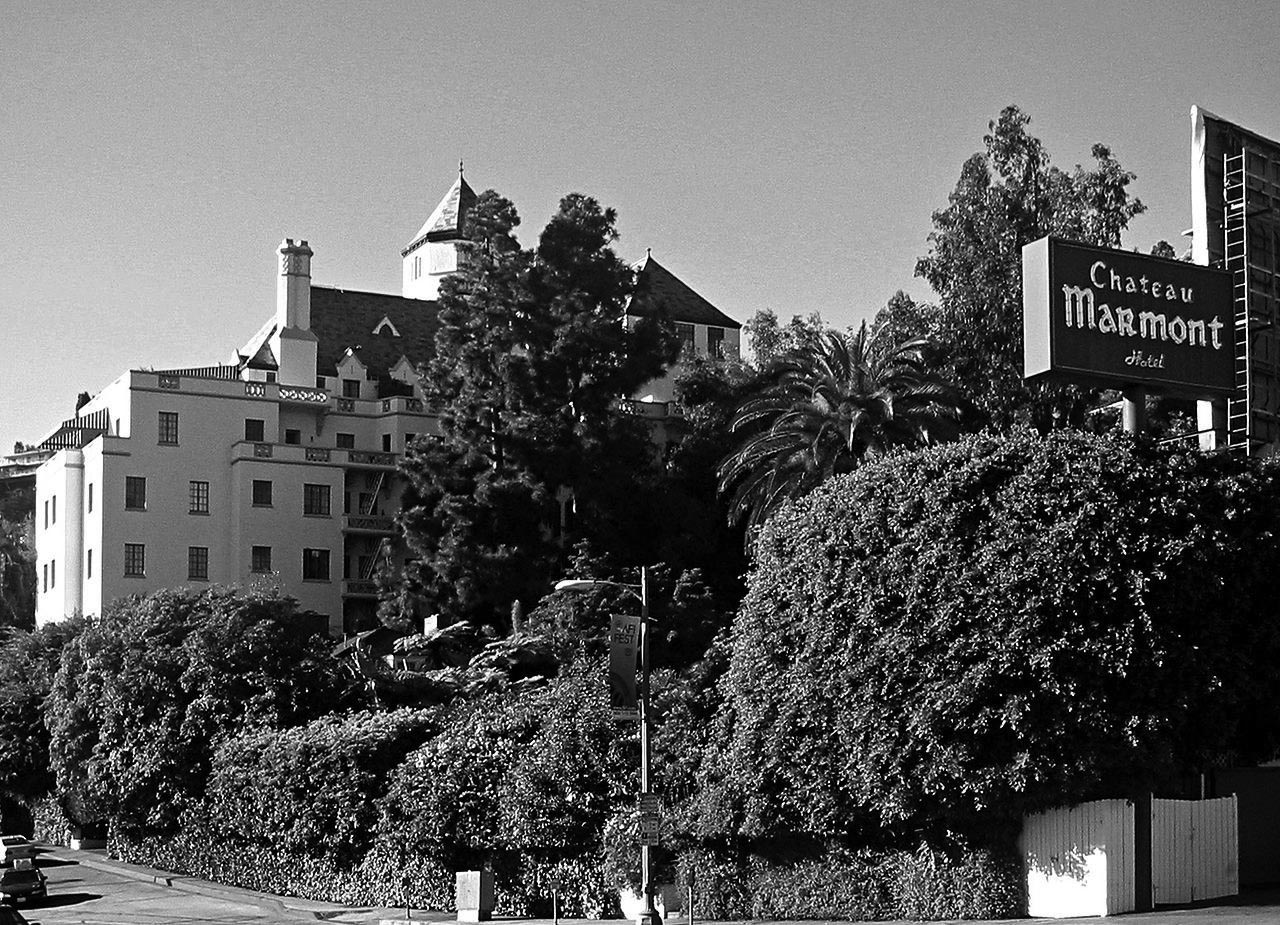 |
|
| (2006)* - View showing the Chateau Marmont Hotel located on the Sunset Strip, 8225 Marmont Lane and 8221 Sunset Boulevard. Photo by Gary Minnaert / Wikipedia |
Historical Notes When celebrities visiting Los Angeles want to be seen, they often go to the Beverly Hills Hotel. When they wish to keep out of the limelight they often stay at the Marmont. |
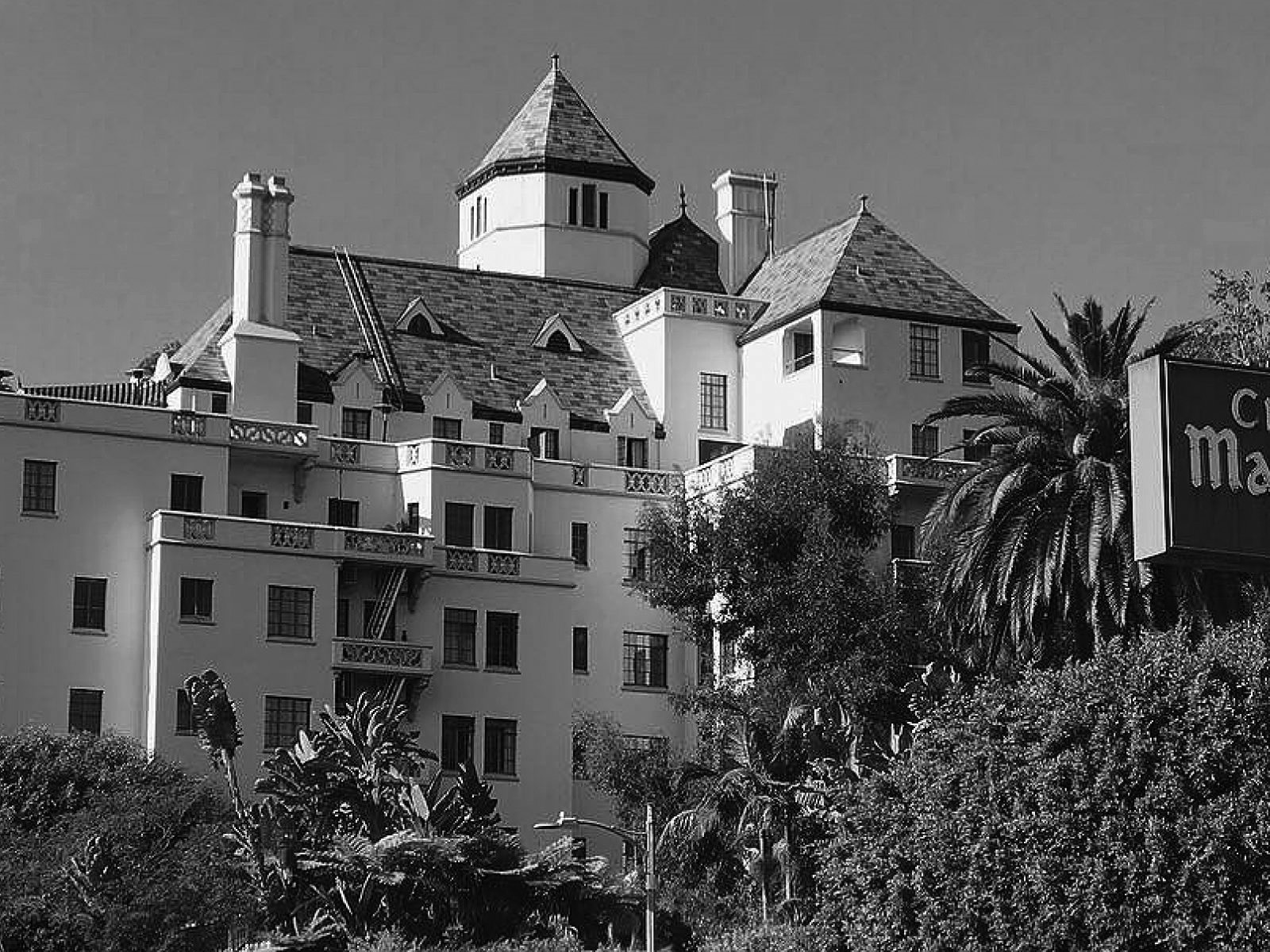 |
|
| (ca. 2019)^ – Close-up view of the Chateau Marmont on the Sunset Strip as it appears today. |
Historical Notes In 1976, Chateau Marmont was dedicated LA Historic-Cultural Monument No. 151 (Click HERE to see complete listing). |
Club Seville
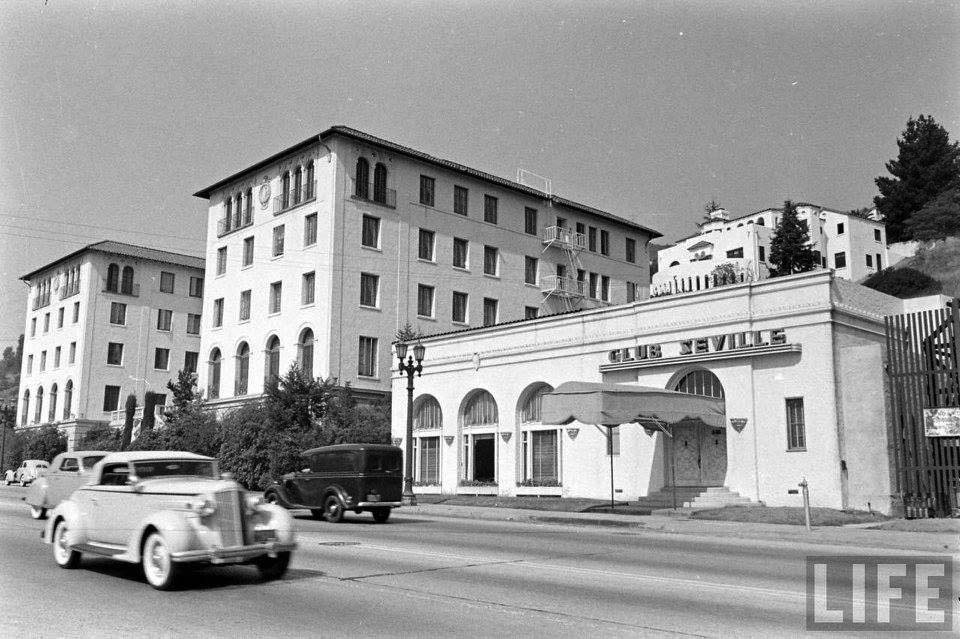 |
|
| (ca. 1938)#**# – Life Magazine photo showing Club Seville (later Ciro's and today The Comedy Store) located at 8433 Sunset Boulevard. To its left is the Hacienda Park Apartments (built in 1927). |
Historical Notes The Club Seville opened New Year’s Eve 1935 and featured a crystal dance floor with subsurface fish, fountains and colored lights in its Crystal Marine Room. In 1940, the building got a face-lift and became known as Ciro’s Nightclub (1940 – 1957). Click HERE for contemporary view. |
Ciro's Nightclub
.jpg) |
|
| (ca. 1940)^#*#^ – Panoramic view showing Ciro’s Nightclub located at the T-intersection of Sunset Boulevard and N. Olive Drive. |
Historical Notes Ciro's (later known as Ciro's Le Disc) was a nightclub in West Hollywood located at 8433 Sunset Boulevard, on the Sunset Strip. It opened in January 1940 by entrepreneur William Wilkerson. Herman Hover took over management of Ciro's in 1942 until it closed its doors in 1957. Co-founder Wilkerson also opened Cafe Trocadero, in 1934, and the restaurant La Rue, both on the Strip, and later originated The Flamingo in Las Vegas, only to have control of the resort wrested from his control by mobster Benjamin "Bugsy" Siegel.*^ |
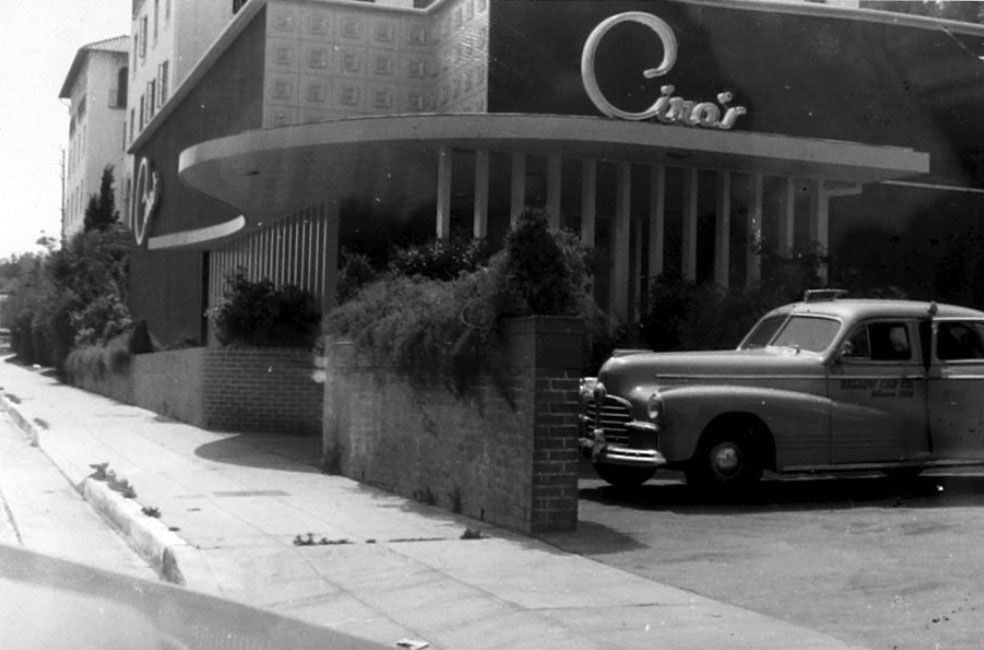 |
|
| (1942)^##* – View showing the entrance to Ciro's Nightclub with a Yellow Cab Co. taxi (’42 Pontiac) in the parking lot. |
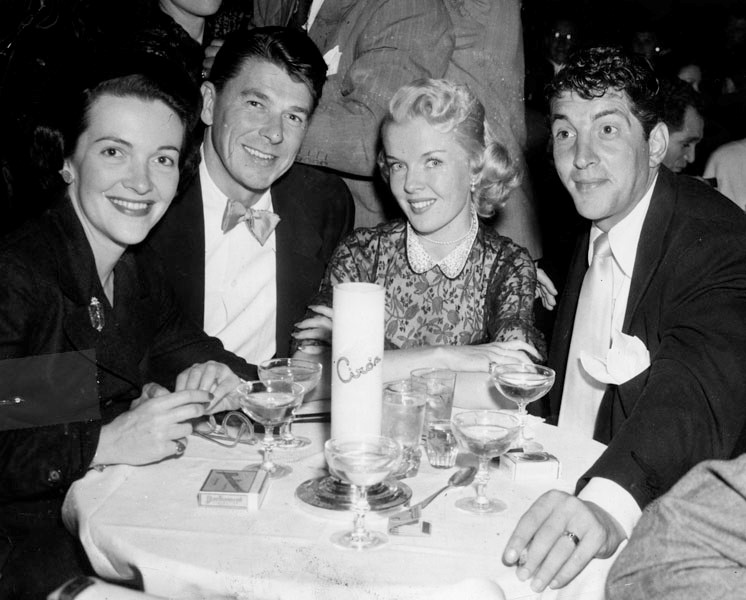 |
|
| (1952)* - Celebrating the upcoming marriage of Nancy Davis (left) to Ronald Reagan, are Jeanne (Biegger) Martin and Dean Martin (right) at Ciro's Nightclub on the Sunset Strip on February 23, 1952. Ain't that a kick in the head! |
Historical Notes Ciro's combined a luxe baroque interior and an unadorned exterior and became a famous hangout for movie people of the 1940s and, 1950s. It was one of "the" places to be seen and guaranteed being written about in the gossip columns of Hedda Hopper, Louella Parsons and Florabel Muir.*^ |
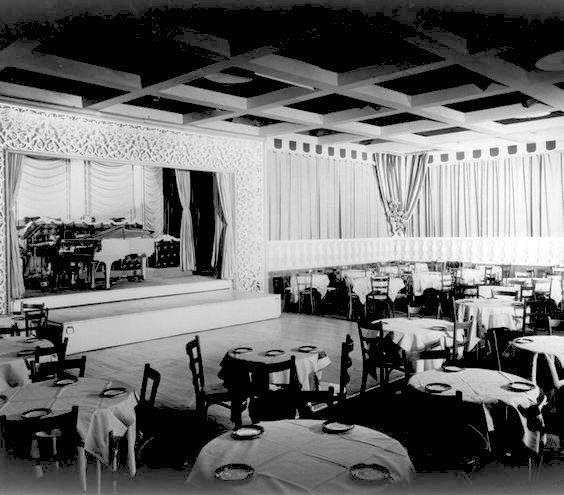 |
|
| (1950s)#**# – Interior view of Ciro’s Nightclub showing tables, dance floor, and stage. High caliber performers appeared here which drew in the top Hollywood celebrities. |
Historical Notes Among the galaxy of celebrities who frequented Ciro's were Marilyn Monroe, Humphrey Bogart and Lauren Bacall, Frank Sinatra, Ava Gardner, Sidney Poitier, Anita Ekberg, Lucille Ball and Desi Arnaz, Joan Crawford, Betty Grable, Marlene Dietrich, Ginger Rogers, Ronald Reagan, Dean Martin, Mickey Rooney, Cary Grant, George Raft, George Burns and Gracie Allen, Judy Garland, June Allyson and Dick Powell, Mamie Van Doren, Jimmy Stewart, Jack Benny, Peter Lawford, and Lana Turner (who often said Ciro's was her favorite nightspot) among many others. During his first visit to Hollywood in the late 1940s, future President John F. Kennedy dined at Ciro's.*^ |
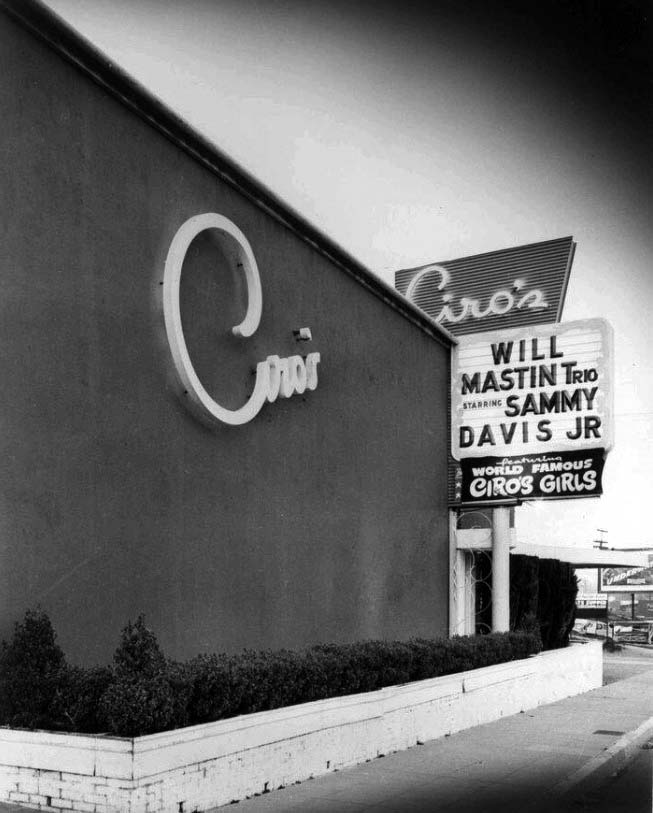 |
|
| (1950s)##^* - View showing the front of Ciro's Nighclub. Marquis reads: "Will Mastin Trio starring Sammy Davis Jr. featuring the World Famous Ciro's Girls." |
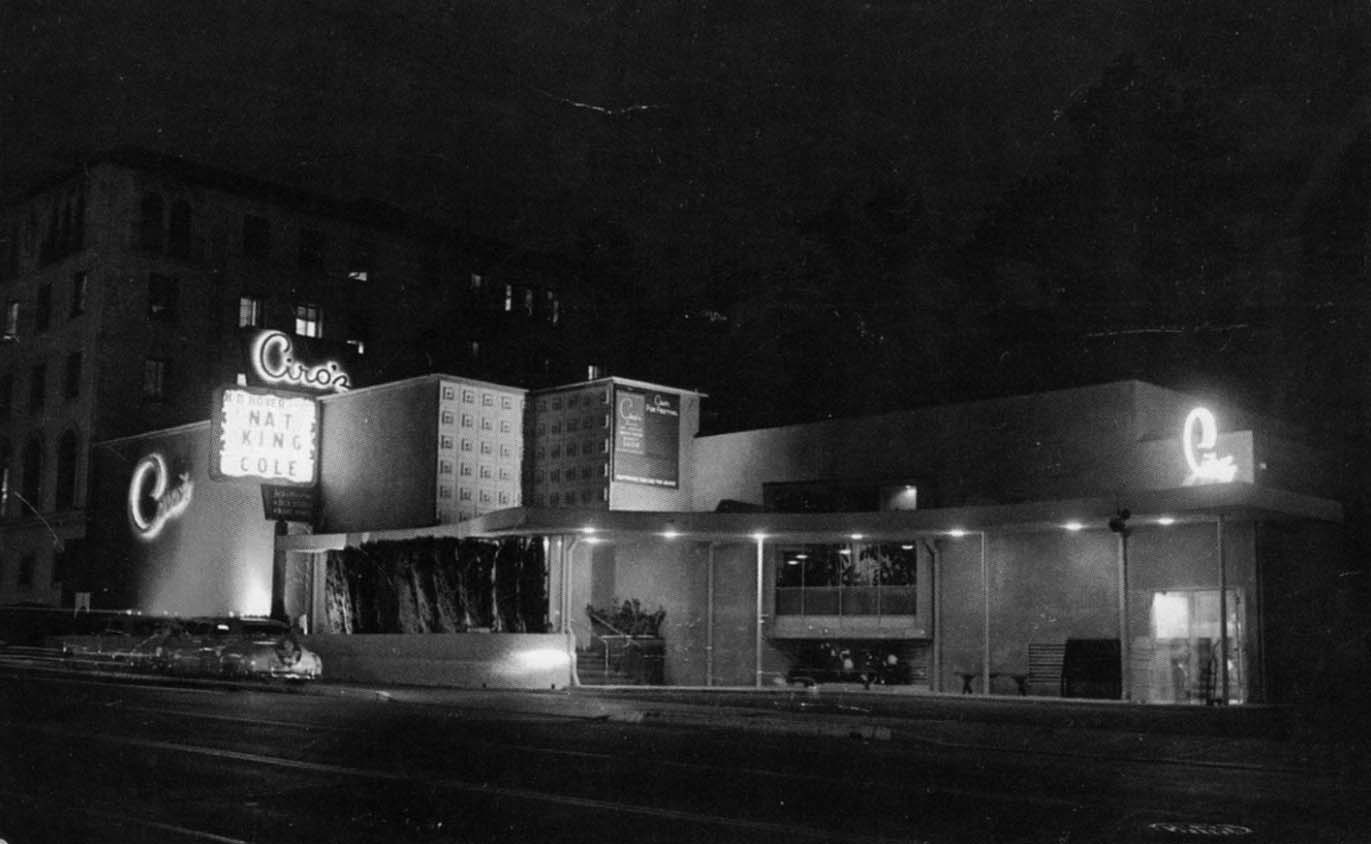 |
|
| (1954)*^#^* - Night view showing Ciro's Nightlcub. Billboard reads: Nat King Cole |
Historical Notes In the 1960s, Ciro's became a Sunset Strip rock and roll club, and was the only major venue on the Strip to make such a transition while keeping its original name. The Byrds got their start there in 1964. Accounts of the period (reproduced in the sleeve notes to The Preflyte Sessions box set) describe a "church-like" atmosphere, with interpretive dancing. The club also served as the host during the recording of the 1965 Dick Dale album "Rock Out With Dick Dale: Live At Ciro's" The site of Ciro's became The Comedy Store in 1972.*^ |
The Comedy Store
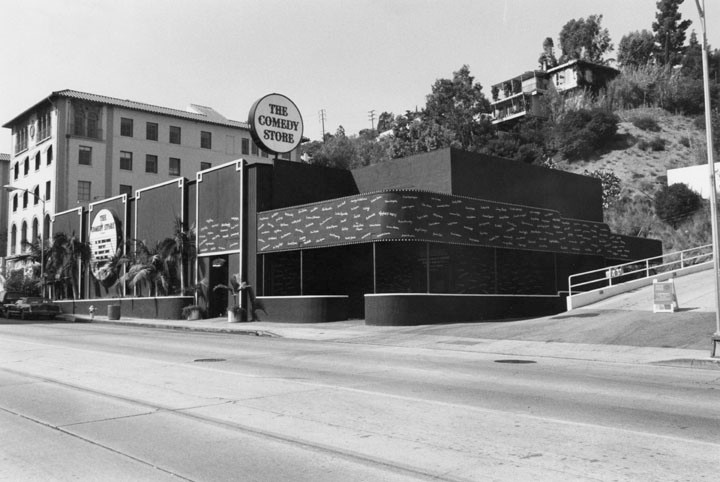 |
|
| (1991)* - Picture taken from across the street showing The Comedy Store on the Sunset Strip. At one time this was Ciro's Nightclub. |
Historical Notes The Comedy Store was opened in April 1972 by comedians Sammy Shore and Rudy DeLuca. The building was formerly the home of Ciro's, a popular Hollywood nightclub owned by William Wilkerson, and later a rock and roll venue, where The Byrds were discovered in 1964. When the venue reopened as The Comedy Store in 1972, it included a 99-seat theatre, where Johnny Carson was one of the first comics to perform. As a result of a divorce settlement, Sammy Shore's ex-wife Mitzi Shore began operating the club in 1973, and she was able to buy the building in 1976. She immediately renovated and expanded the club to include a 450-seat main room.*^ |
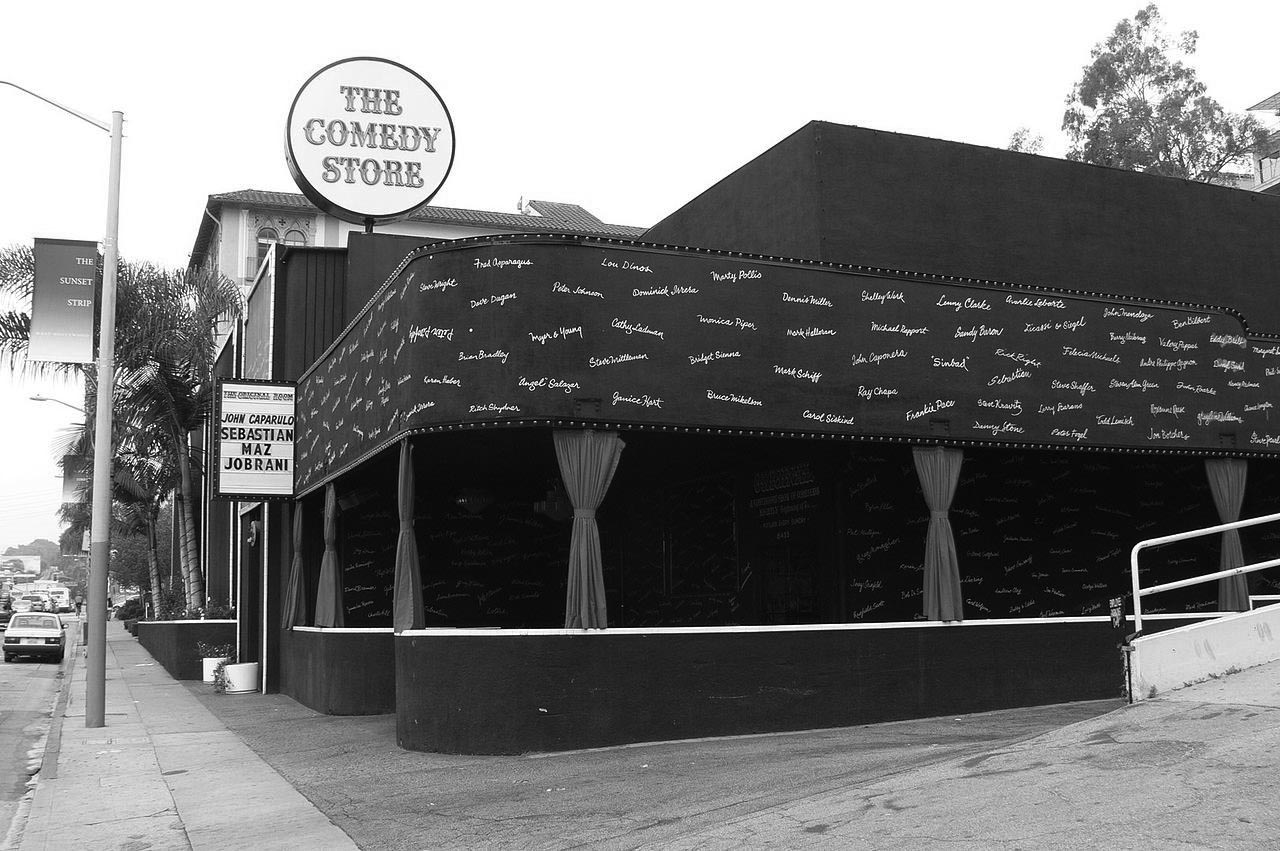 |
|
| (2006)*^ - Close-up view showing The Comedy Store, 8433 W. Sunset Blvd., West Hollywood. Photo by Mike Dillon |
Historical Notes The Comedy Store has featured performances from every important comedian. The names of its headliners are vaunted on its outside walls. This was once the site of Ciro’s, one of Hollywood’s most popular nightclubs during the 1940s and 1950s. The building is supposedly haunted. TV’s “Access Hollywood” once brought in a psychic, billed her as a “spiritual journalist,” and had her talk about angry mobsters still supposedly trapped in the building’s basement. ^^+ |
* * * * * |
The Strip
 |
|
| (n.d.)#**# - A wall decoration in Disney Hollywood Studios Florida showing a map of West Hollywood in the 1930s. Highlighted names along "The Strip" include: Chateau Marmont, Garden of Allah, Sunset Tower, Clovera Club, La Maze, Villa Nova, Little Hungary, The Cock and Bull, Trocadero, Ted Snyder, Phil Selznick, Ray Hallers and Eddie Cantor*. |
Historical Notes *Eddie Cantor, born Edward Israel Iskowitz, was a comedian, dancer, singer, actor, and songwriter. He is also known for being the second president of the Screen Actors Guild, serving from 1933 to 1935. He invented the title "The March of Dimes" for the donation campaigns of the National Foundation for Infantile Paralysis, which was organized to combat polio. It was a play on the The March of Time newsreels popular at the time. He began the first campaign on his radio show in January 1938, asking listeners to mail a dime to President Franklin D. Roosevelt. At that time, Roosevelt was the most notable American victim of polio. Other entertainers joined in the appeal via their own shows, and the White House mail room was deluged with 2,680,000 dimes—a large sum at the time.*^ |
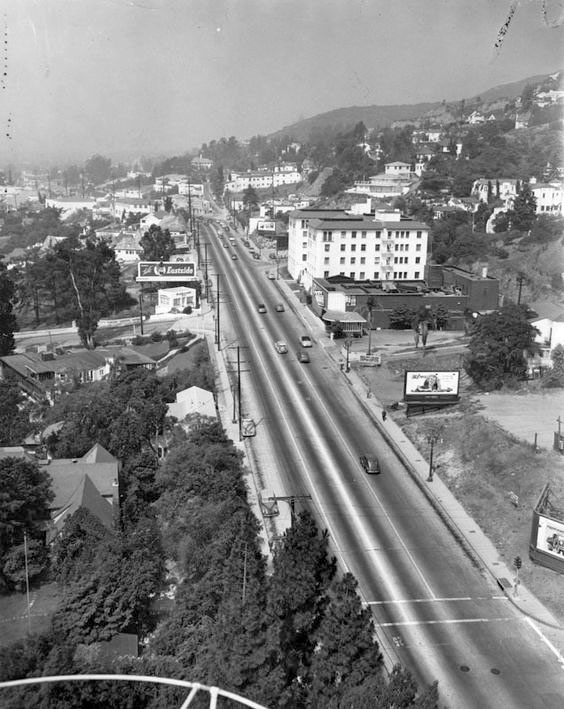 |
|
| (1949)*– View looking down upon the Sunset Strip from the roof of the Sunset Tower. On the right, that's Ciro's Nightclub (now The Comedy Store) and the Coronet Apartments (originally the Hacienda Park Apartments and now the Piaza del Sol office building). Just beyond them, the building that housed the Clover Club can be seen. Note that, across the street from Ciro's, on the southeast corner of Olive and Sunset, is the home that is now the House of Blues. Closer in may be the roof of a house owned by John Barrymore in the 1930s. |
Historical Notes The Hacienda Park Apartments (renamed Coronet Apartments in late 1930s) was built in 1927 and operated initially as a luxury apartment building catering to the entertainment business. In the 1930s, it became the "most famous brothel in California." The building declined in prestige in the 1950s and 1960 and was acquired by rock star Rod Stewart in the 1970s. After Stewart's plans to redevelop the building as a luxury hotel ended in a legal dispute, the building was nearly destroyed in a 1983 fire that was found to be of suspicious origin. Since 1986, it has been known as the Piazza del Sol, and it now houses the offices of several production companies, including Miramax Films. The restaurant Katana, co-owned by Ryan Seacrest and Tori Spelling and described by Newsweek as "so hip it hurts," also operates at the building.*^ A check of the Piazza del Sol’s listing in the National Register reveals a quirk in the record. The Register shows its original name as Hacienda Arms Apartments, not the Hacienda Park Apartments – a name that in 1927 connected the building to the neighborhood around it, Hacienda Park. It’s by no means a fatal error, and the rest of the information appears to be correct, but this small mistake has been magnified over the years – picked up and repeated in dozens of articles and books, including, for example, the headline of the building’s Wikipedia page.* |
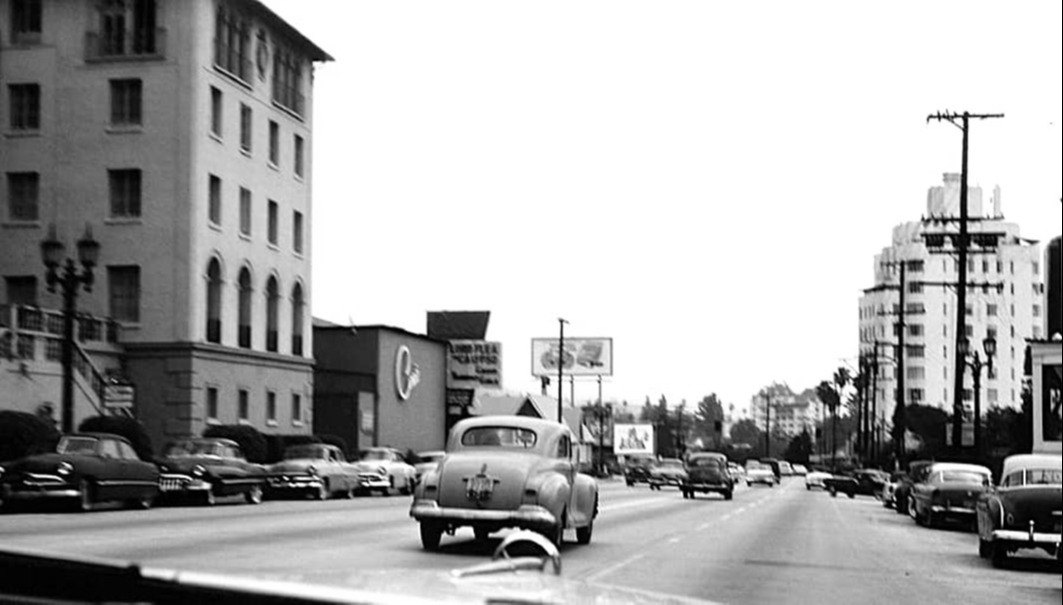 |
|
| (1950)* – Looking east on the 8400 block of Sunset Strip in front of the Coronet Apartments (today Piazza del Sol) and Ciro’s Nightclub (today The Comedy Store). On the right can be seen the 1931-built Art Deco Sunset Tower Apartments. |
Then and Now
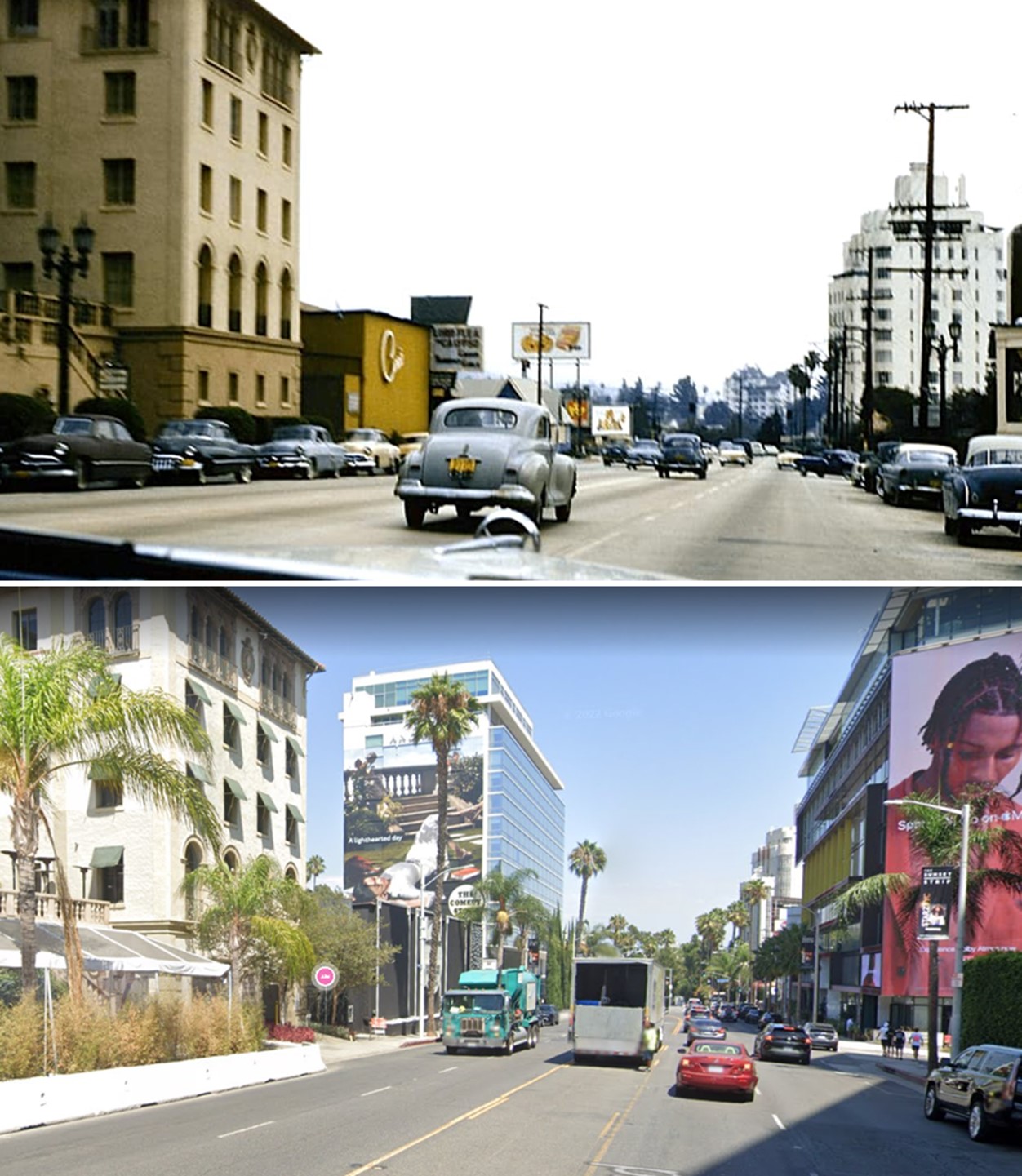 |
|
| (1950 vs 2022)* – Looking east on the 8400 block Sunset Strip in front of the Coronet Apartments (today Piazza del Sol) and Ciro’s Nightclub (today The Comedy Store). In lower photo can be seen the famous 1963-built Continental Hyatt House (east of The Comedy Store). |
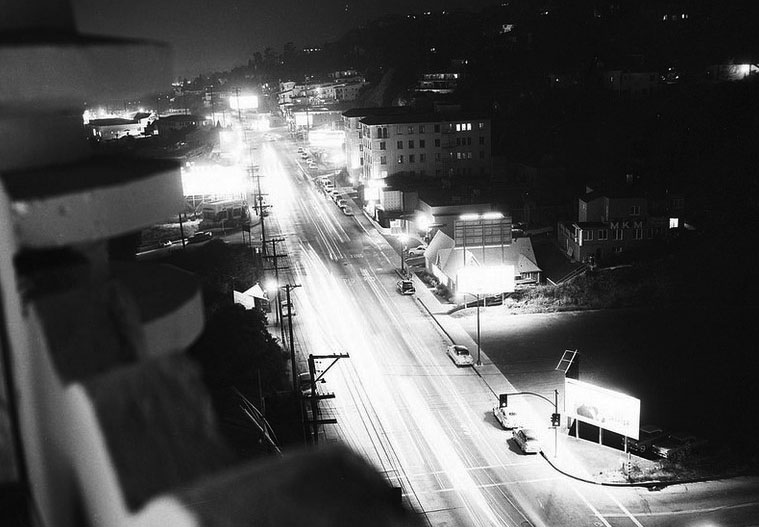 |
|
| (1957)* - Night view looking west along 'The Strip' from the roof of the Sunset Tower. The empty lot at the lower-right sits on the NW corner of Sunset and N. Kings Road. In 1963, the 14-story Gene Autry Hotel would be built here. In the 70s it would evolve into the legendary Hyatt on Sunset where touring rock bands often stayed. In the distance, center-top, stands the Coronet Apartments. |
 |
|
| (1957)^^ – Atmospheric shot looking northeast along 'The Strip' from the roof of the Sunset Tower, with the Chateau Marmont Hotel seen in the distance. |
Cafe Trocadero
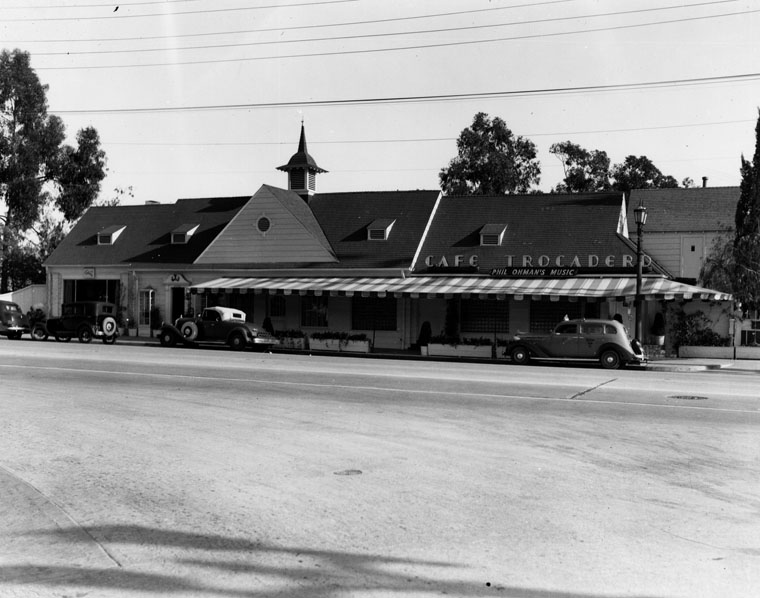 |
|
| (ca. 1936)* - Exterior view of the famous Cafe Trocadero located on the Sunset Strip. A second sign below the nightclub name reads, "Phil Ohman's Music." |
Historical Notes The Cafe Trocadero was the center of jitterbug in the 1930s. A black tie French-inspired supper club, the original Trocadero, now demolished, was considered the jewel of the Strip in the 1930s and became synonymous with stars, starlets, movie producers, and fun.*^ |
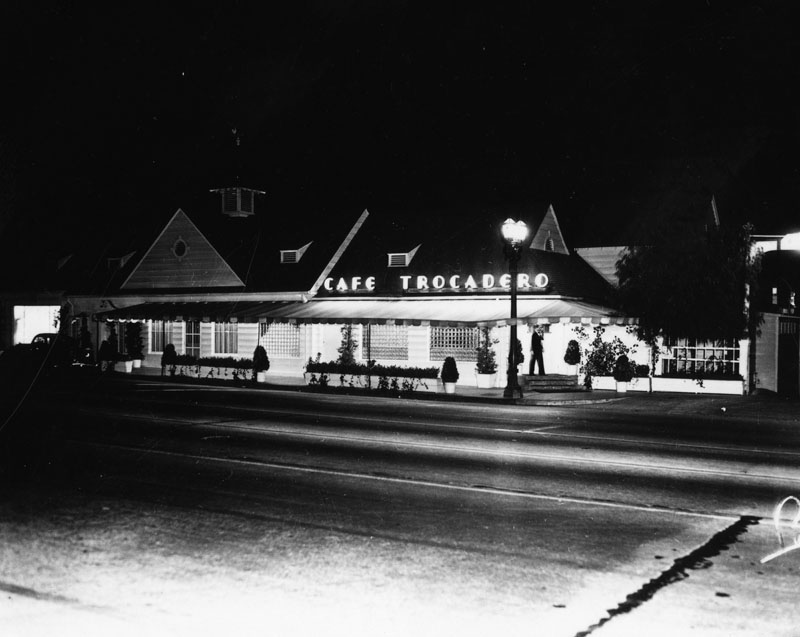 |
|
| (ca. 1937)* - Night view of the Cafe Trocadero, located at 8610 Sunset Boulevard in what is now West Hollywood. |
Historical Notes Originally known as the La Boheme from 1929 to 1933, the Café Trocadero was opened by William R. Wilkerson in 1934. Wilkerson was the successful publisher of The Hollywood Reporter who also owned other nightclubs nearby on the Sunset Strip like Ciro's and LaRue.*^ |
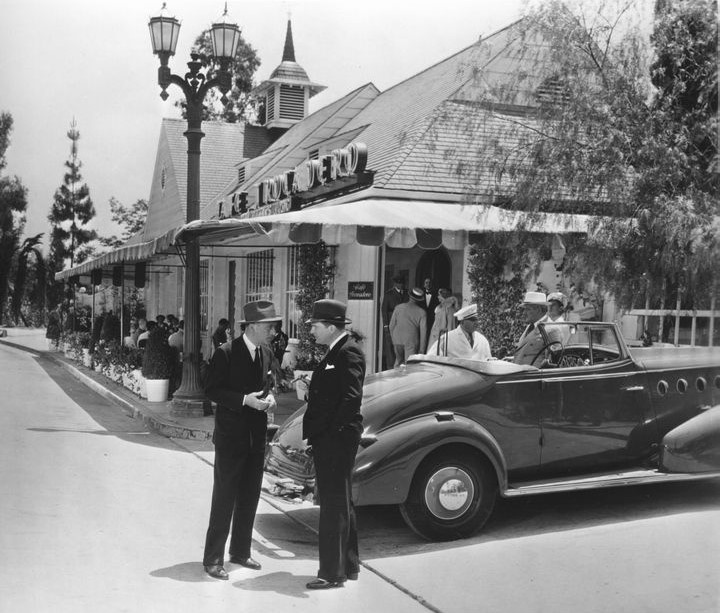 |
|
| (1936)* - Patrons at the Cafe Trocadero before the nightclub was remodeled. Note how the awnings drape around the post of the ornate dual-lamp streetlight. Click HERE to see more in Early Views of LA Streetlights. |
Historical Notes Among the celebrities who frequented the Trocadero were Fred Astaire, Bing Crosby, Cary Grant, Myrna Loy, Jackie Gleason, Henry Fonda, Judy Garland, Lucille Ball, Desi Arnaz, Jean Harlow, and Norma Shearer. The Trocadero was featured in the 1937 movie A Star is Born starring Janet Gaynor and Fredric March.*^ |
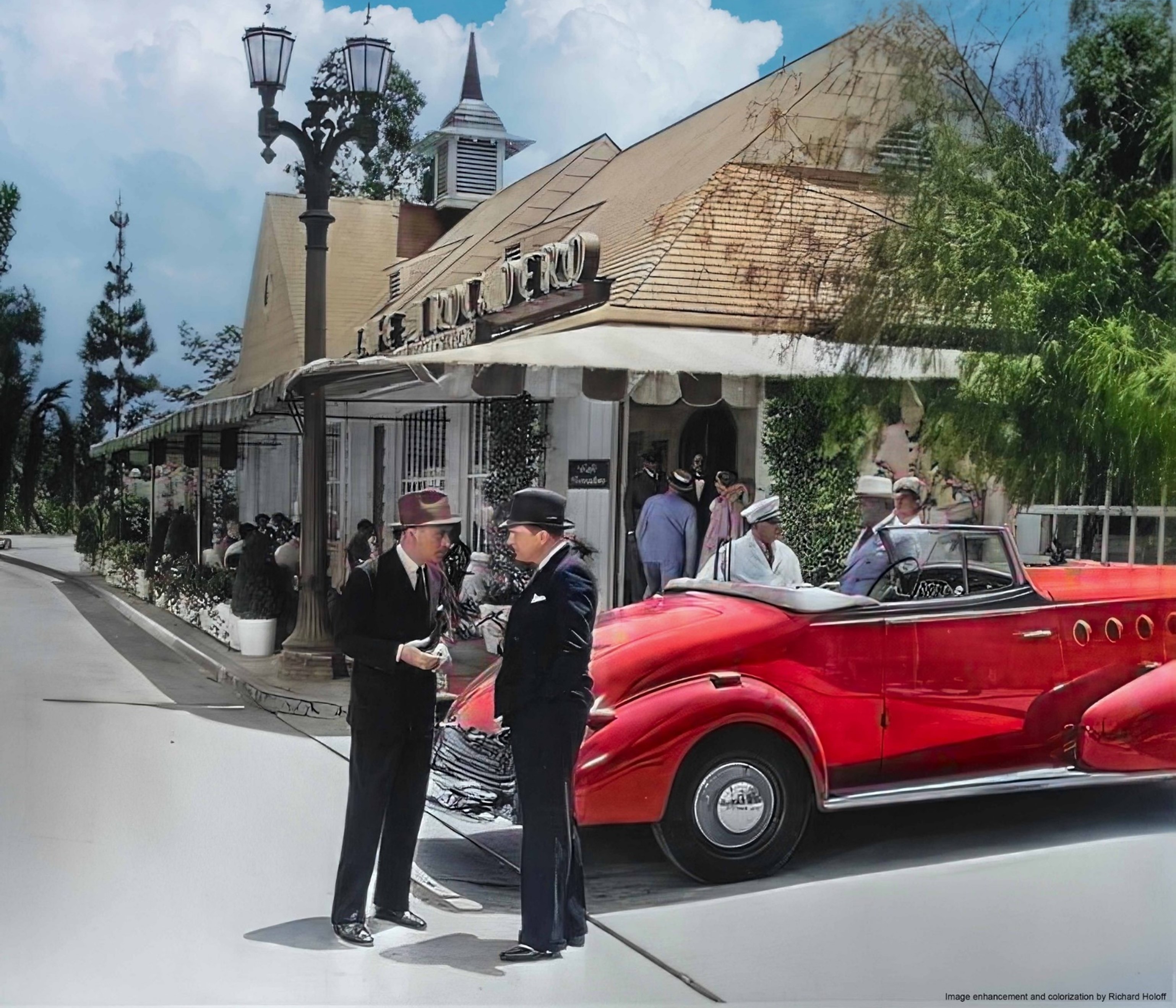 |
|
| (1936)* - Patrons at the Cafe Trocadero before the nightclub was remodeled. Note how the awnings drape around the post of the ornate dual-lamp streetlight. Image enhancement and colorization by Richard Holoff. |
Historical Notes The streetlights seen above are known as 'Metropolitan Streetlights', predominately found in Hollywood. Click HERE to see more in Early Views of LA Streetlights. |
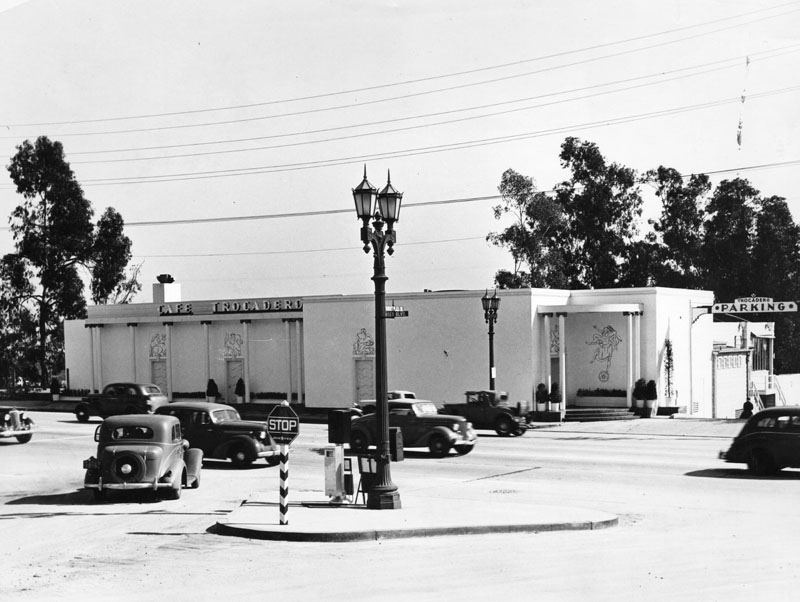 |
|
| (1938)* - Exterior view of the Cafe Trocadero shortly after it underwent extensive remodeling. Note the art designs on the wall and above each of the doors. |
Historical Notes The building was remodeled in 1938 by new owners Bugsy Siegel and Mickey Cohen. |
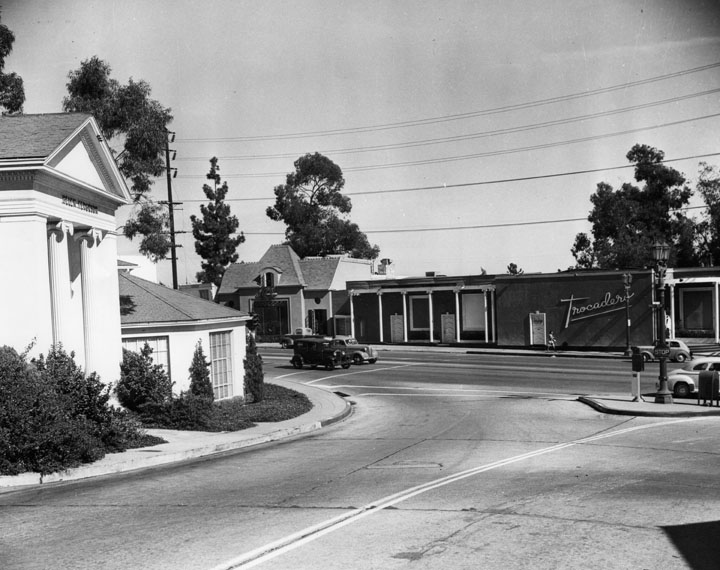 |
|
| (ca. 1945)* - Exterior view of Cafe Trocadera as seen from where Sunset Plaza Drive (foreground) meets Sunset Boulevard. |
Historical Notes After years of serving as one of Hollywood's best evening destinations, the "Troc" closed in 1946.* Today, a "new" Trocadero stands as a nightclub at 8610 Sunset Boulevard on the Sunset Strip. |
Sunset Plaza
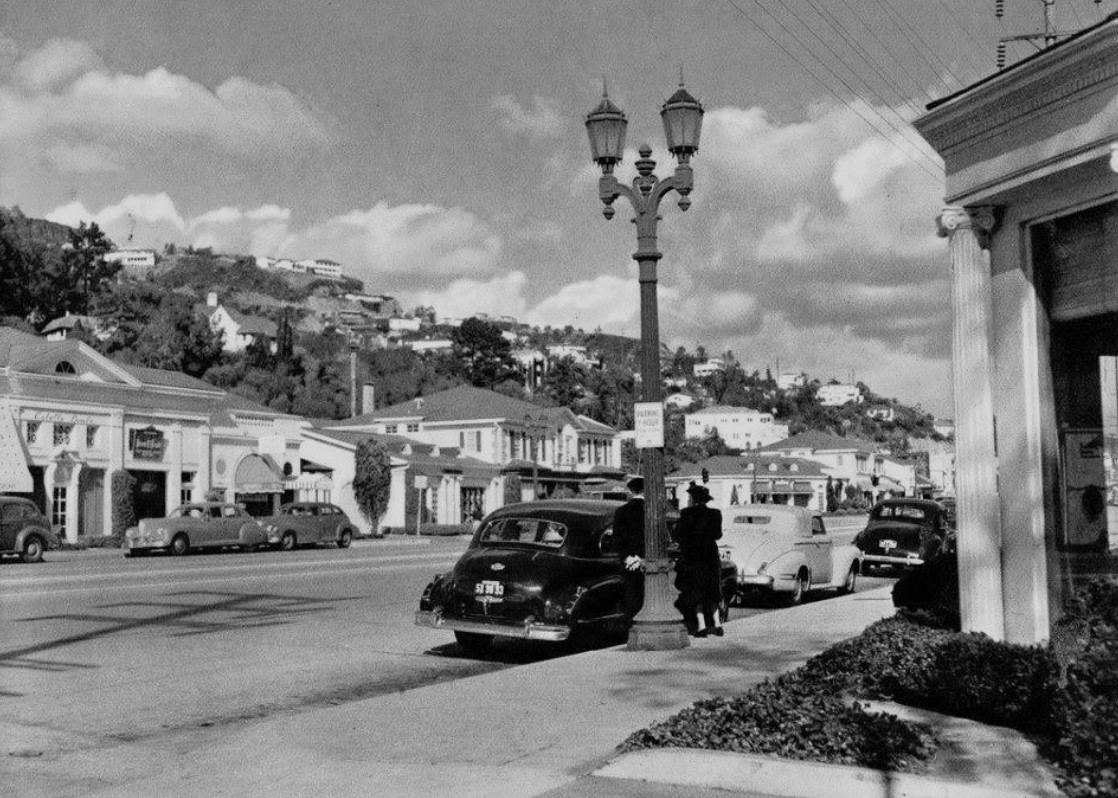 |
|
| (1946)* - View looking east of Sunset Plaza located on the 8600 block of W. Sunset Boulevard, West Hollywood |
Historical Notes Opened in 1924, Sunset Plaza was the first commercial development on the Sunset Strip. Today it is an exclusive shopping complex that draws an A-list clientele to its designer boutiques and chic sidewalk cafes and restaurants. The Sunset Plaza is located on both sides of Sunset Boulevard between La Cienega and San Vicente at Sunset Plaza Drive. |
1940s.jpg) |
|
| (1940s)*– View looking north on Sunset Plaza Drive from Sunset Boulevard. A Christmas tree stands on the island in the middle of Sunset Plaza. A sign below the tree reads, "Sunset Plaza - Merry Christmas". |
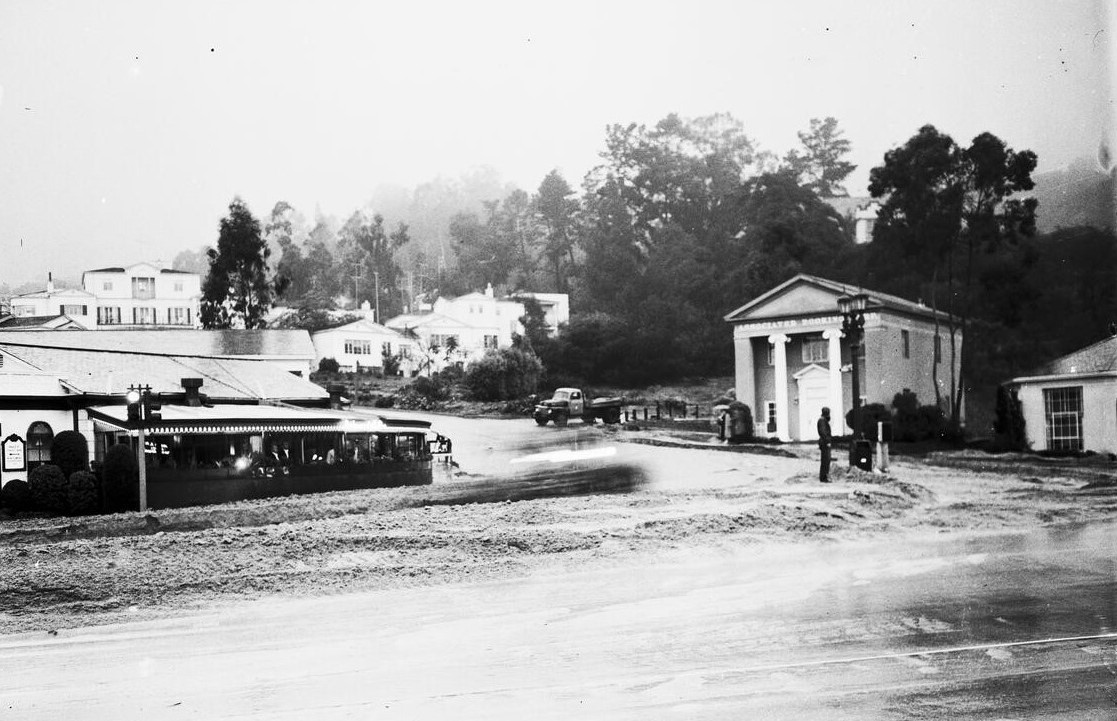 |
|
| (1952)* - Sunset Boulevard at Sunset Plaza Drive after a storm. Photo date: March 15, 1952. |
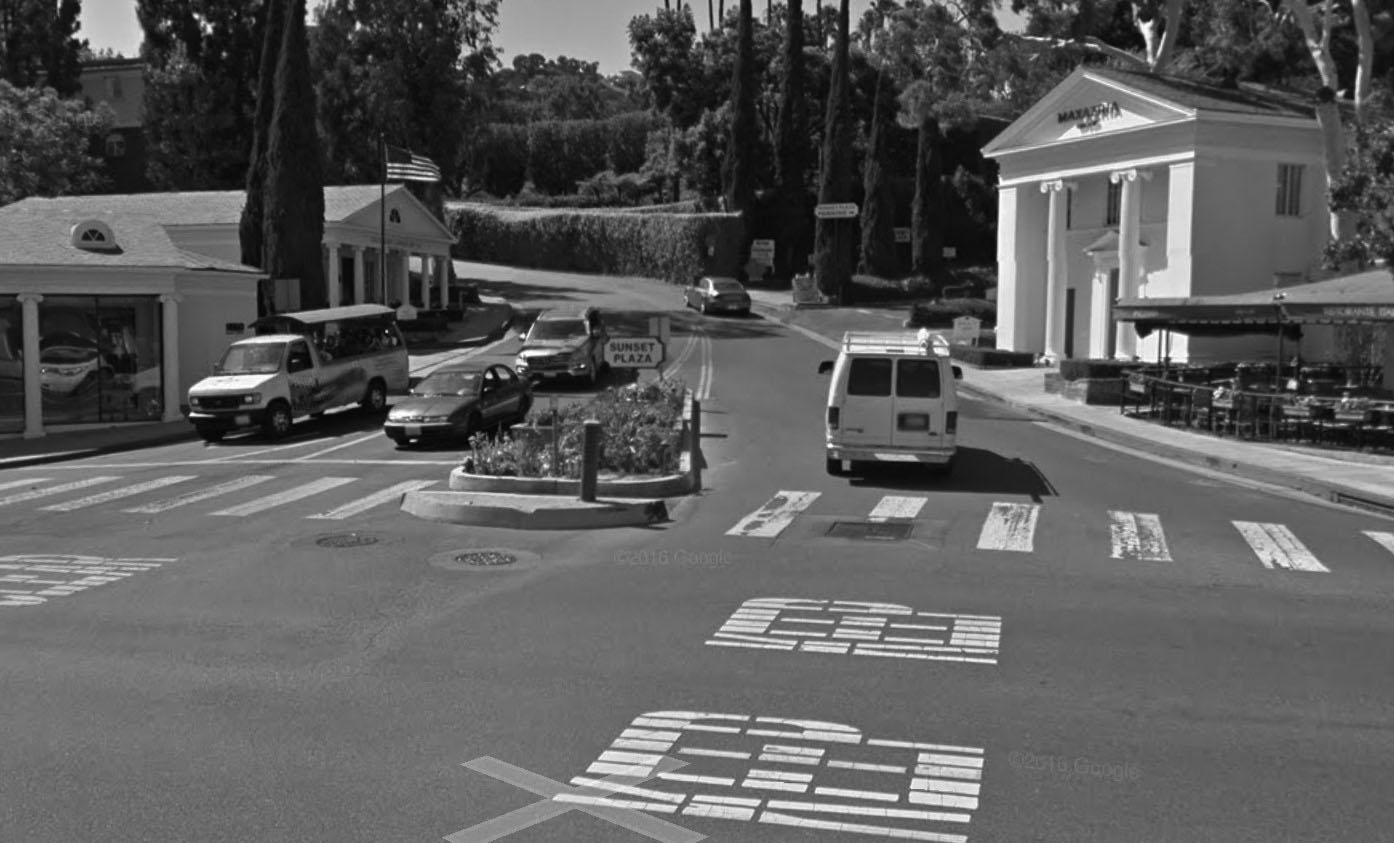 |
|
| (2016)* - View looking north showing the intersection of Sunset Plaza Drive and Sunset Boulevard as it appears today. |
Then and Now
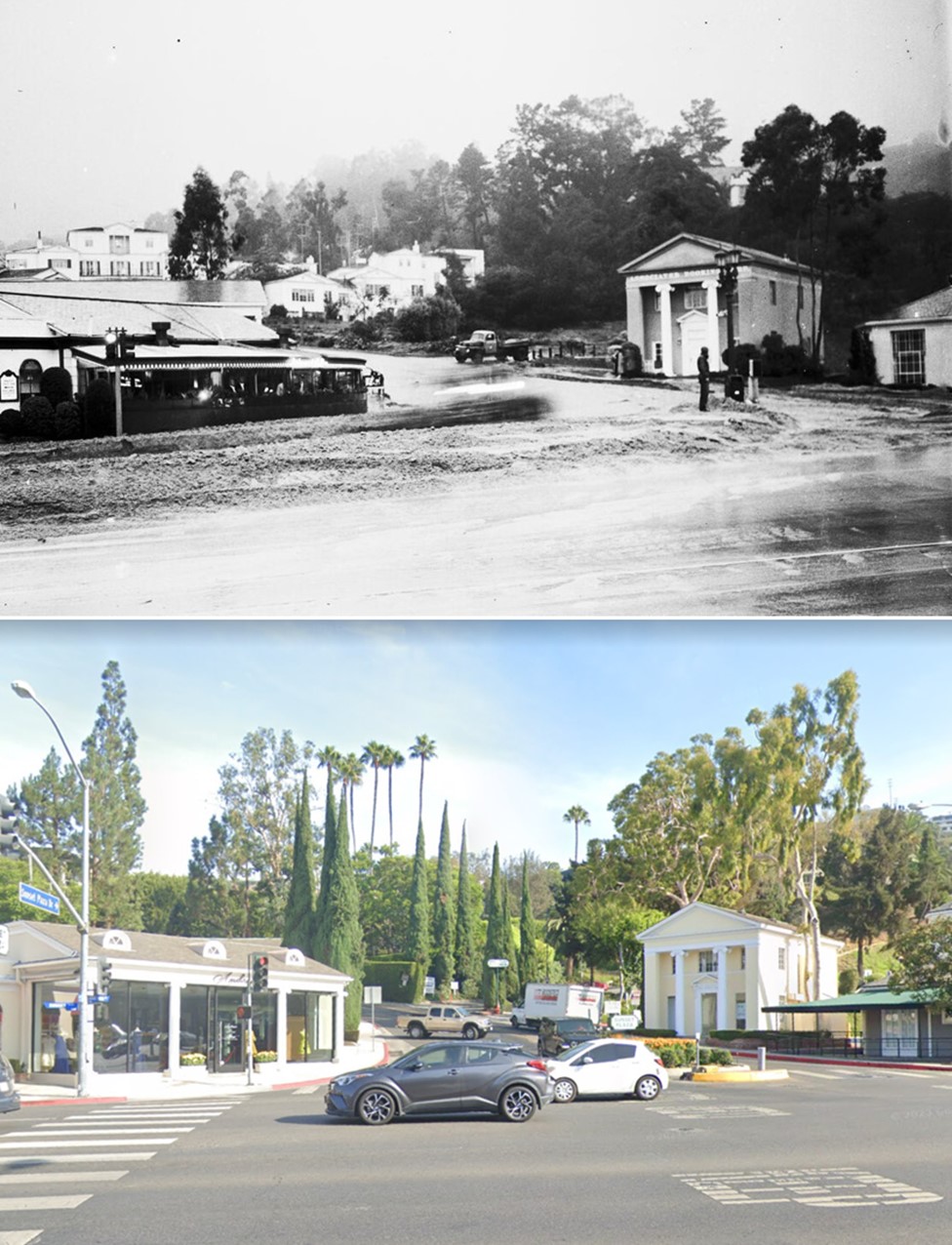 |
|
| (1952 vs 2022)* - Sunset Boulevard at Sunset Plaza Drive. |
Then and Now
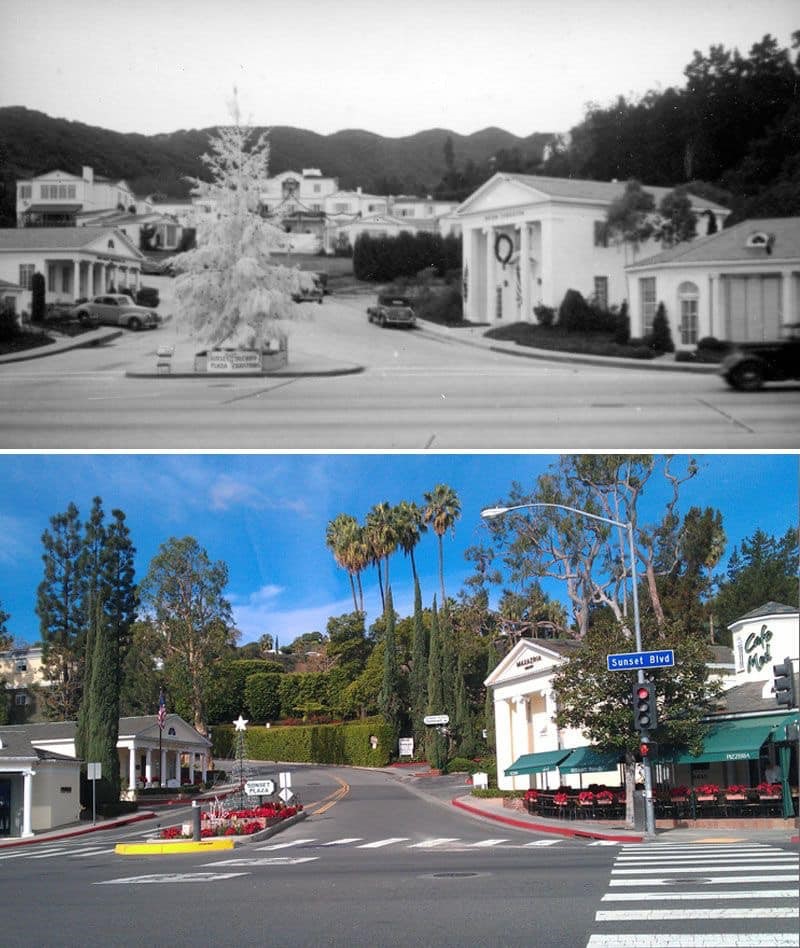 |
|
| Then and Now |
Wil Wright's Ice Cream
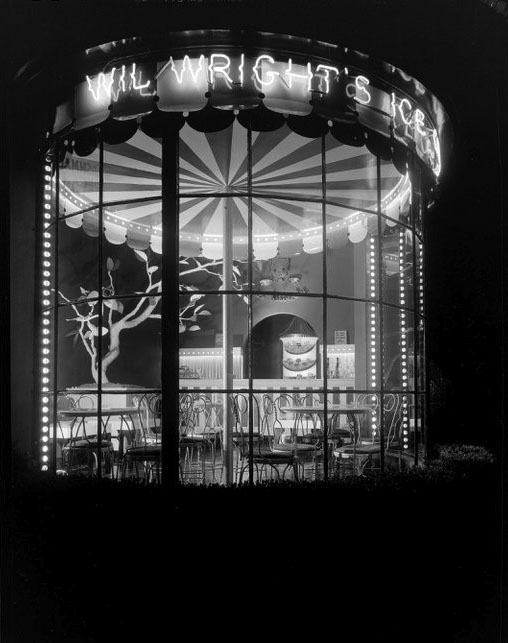 |
|
| (1950)^.^ - Wil Wright's Ice Cream located at 8651 Sunset Boulevard at Sunset Plaza. This is currently a display window for a women's clothing store (Michale Nusskern) |
Historical Notes Wil Wright’s was a chain of ice cream parlors that dotted the Southern California landscape up until the mid-seventies. In addition to the West Hollywood location, they could be found in Beverly Hills (corner of Beverly Drive and Charleville), Westwood Village (corner of Glendon and Lindbrook), Pacific Palisades (San Vicente), Sherman Oaks (corner of Ventura and Van Nuys Blvd). They were the perfect place to take a date after the movie. The delicate pink and red decor and little marble tables and wire-frame chairs made you feel like you were seated inside a Valentine’s Day card. |
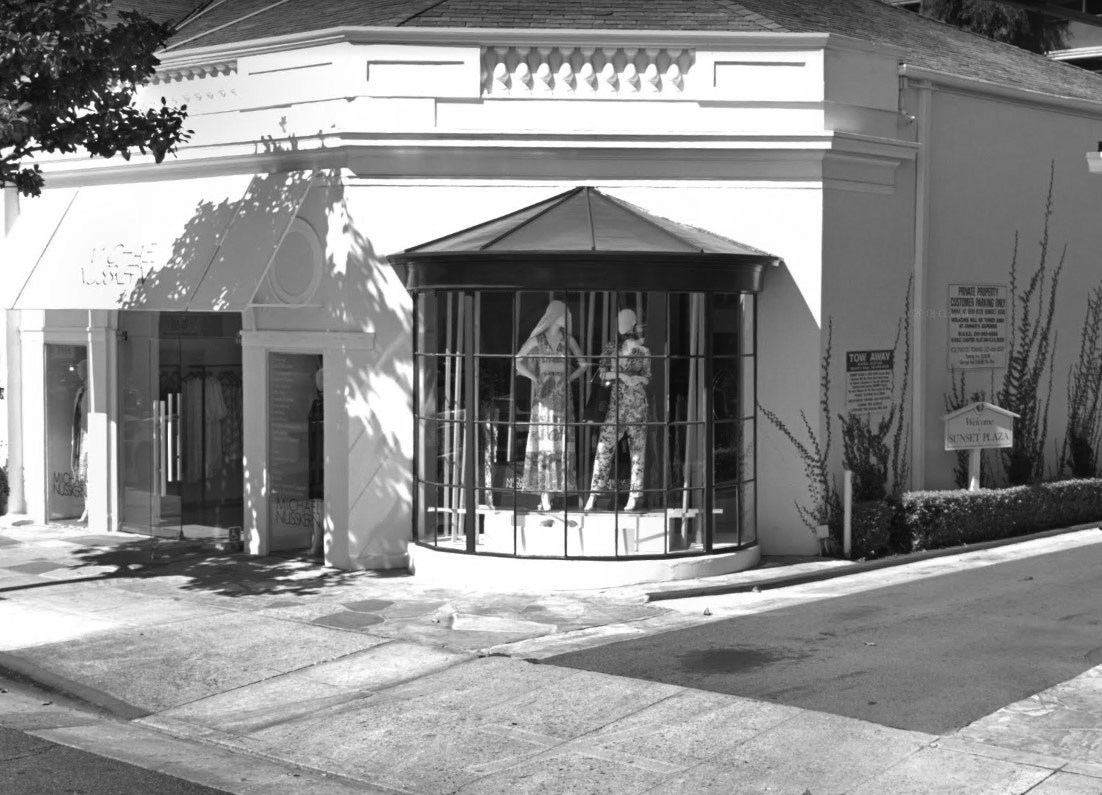 |
|
| (2018)^^- View showing window display of Michale Nusskern clothing store, previous location of Wil Wright's Ice Cream. |
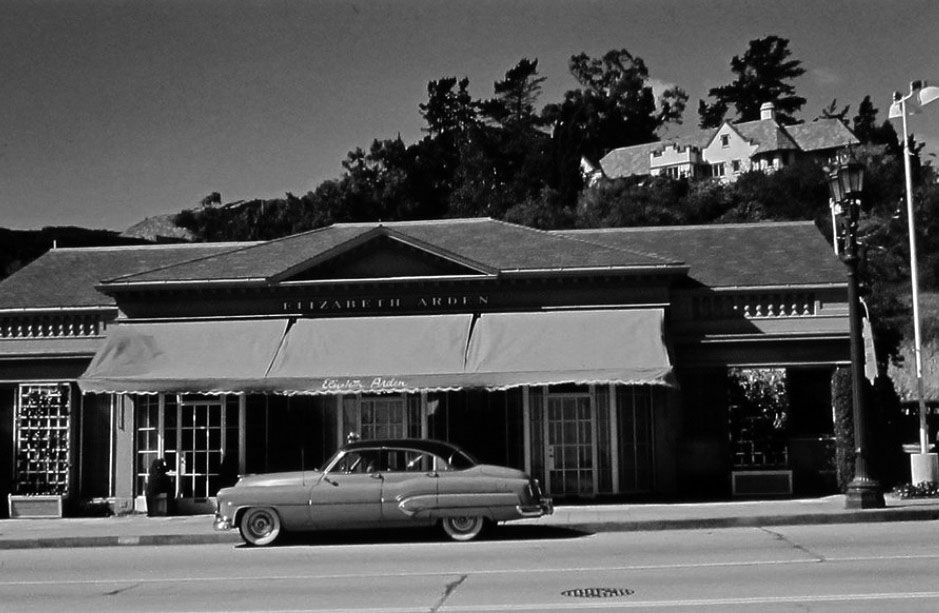 |
|
| (ca. 1955)^##* - View showing a car parked in front of Elizabeth Arden at Sunset Plaza. |
Historical Notes Florence Nightingale Graham (1878 – 1966), who went by the business name Elizabeth Arden, was a Canadian American businesswoman who founded what is now Elizabeth Arden, Inc., and built a cosmetics empire in the United States. By 1929 she owned 150 upscale salons across the United States and Europe. Her 1000 products were found in the luxury market in 22 countries. She was the sole owner, and at the peak of her career, she was one of the wealthiest women in the world.*^ |
Pupi's Bakery and Sidwalk Café
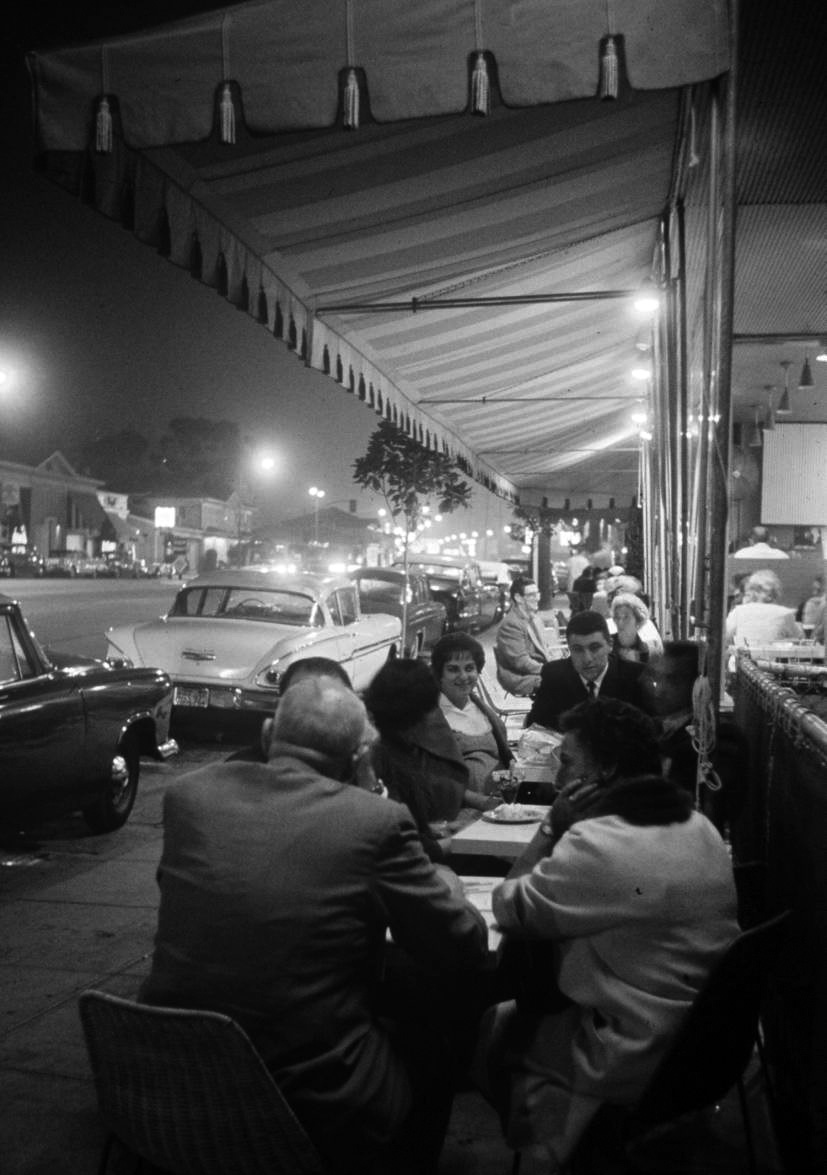 |
|
| (ca. 1958)* – Pupi’s Bakery and Sidwalk Café located on the Sunset Strip near the Sunset Plaza |
Historical Notes Pupi’s, which opened in the mid- to late 1950s, sat on the south side of the Sunset Strip, in the historically upscale portion known as Sunset Plaza. It had a striped awning over sidewalk tables, but the little flagstone patio was the real attraction, along with some Perspex that blocked the wind coming up from the great sweep that separated its patrons from the wider Los Angeles Basin below.^ |
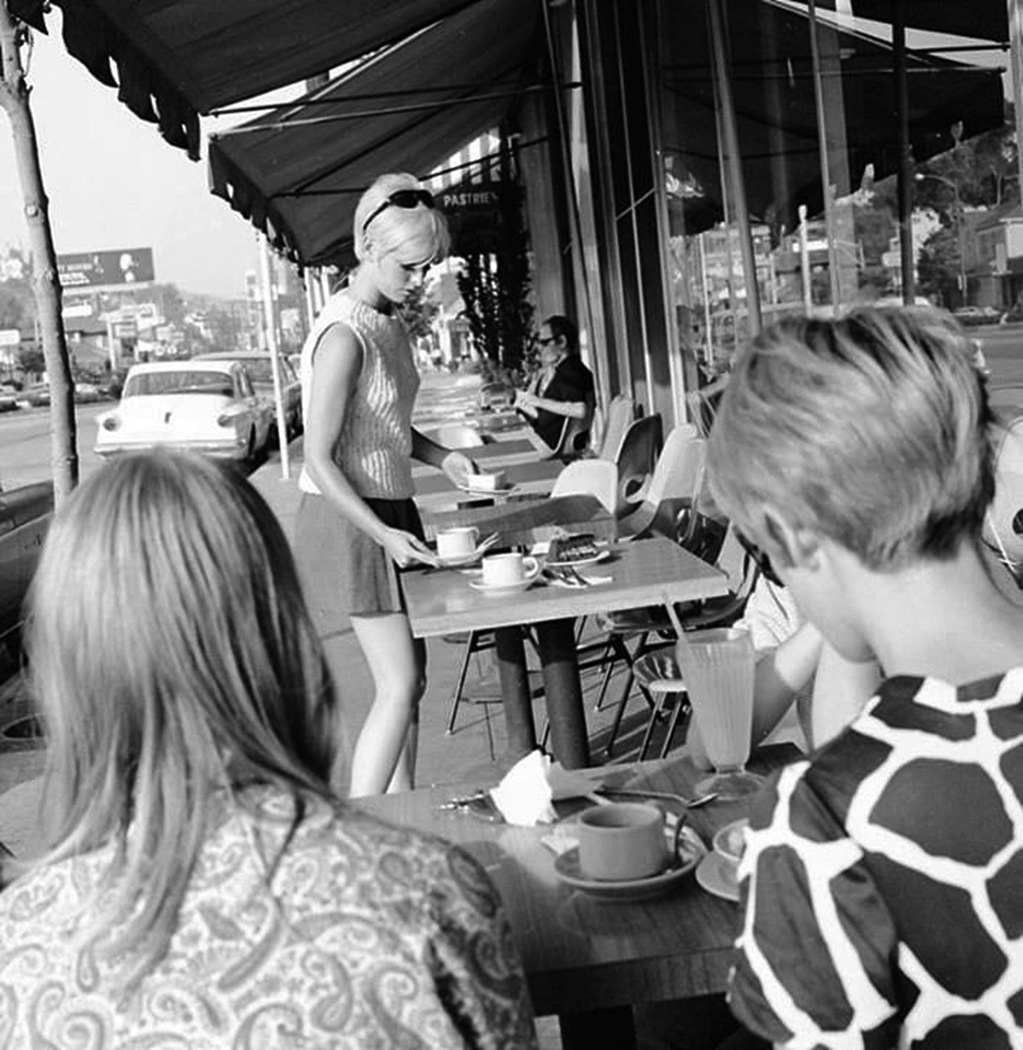 |
|
| (1967)* - Pupi's Bakery and Café located at 8710 Sunset Boulevard...just west of Sunset Plaza. |
Historical Notes Nothing like sitting at the outside tables and wathcing everyone walk by including some famous movie stars. |
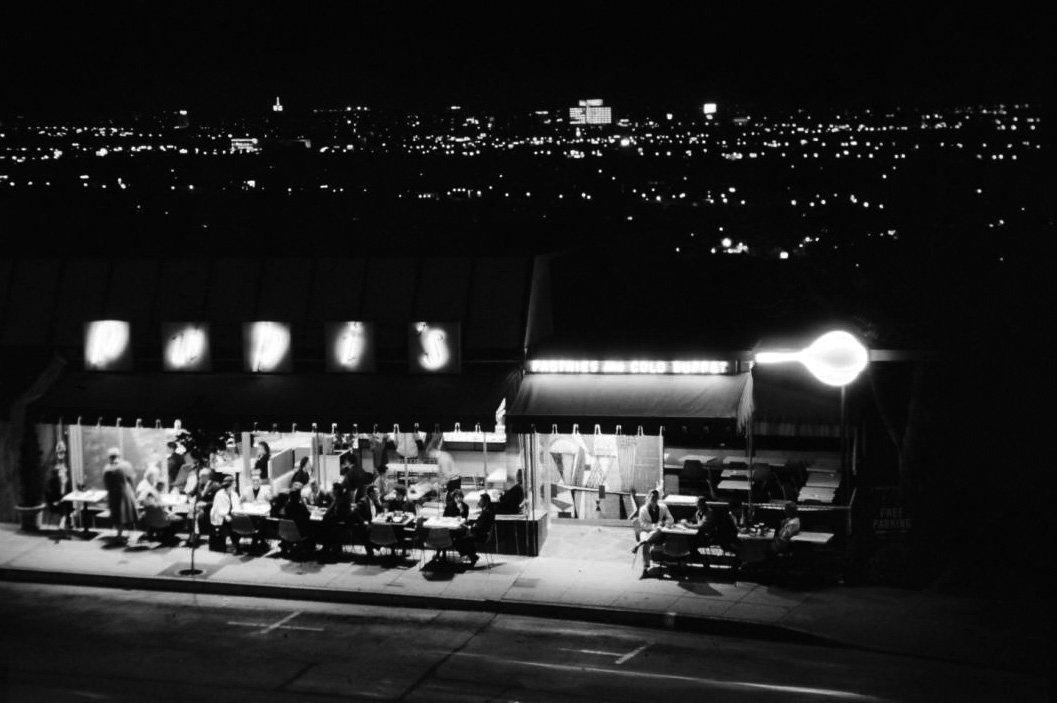 |
|
| (ca.1973)* - Nighttime panoramic view of Pupi's Bakery and Café with the city lights in the background. Life Magazine |
Historical Notes Pupi’s is where Jack Nicholson flew into one of his storied rages one night, quarreling with a waitress and threatening to kick in a pastry cart. That is the incident Carole Eastman said she drew on when she wrote the famous “no substitutions” scene for Bobby Dupea (Jack’s character) in Five Easy Pieces.^ |
Sunset Plaza
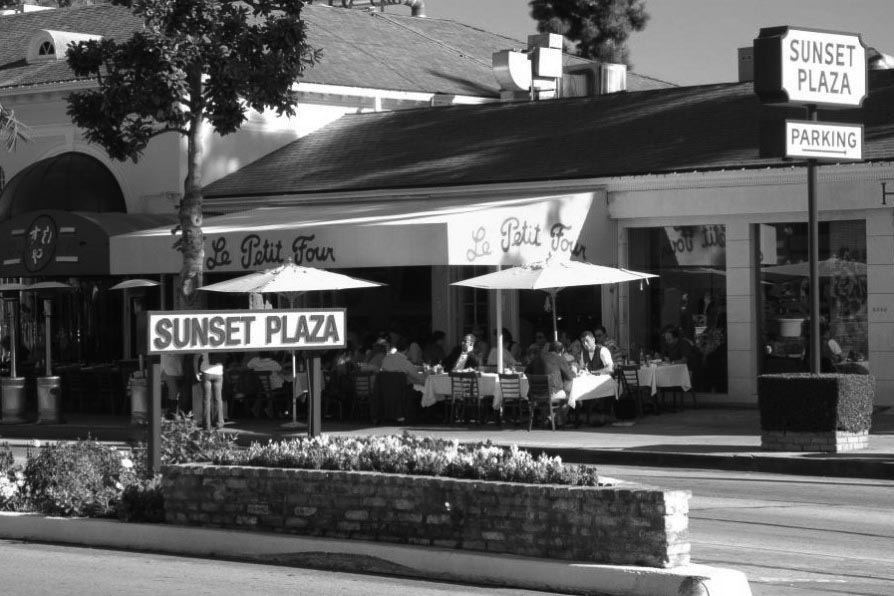 |
|
| (2011)#+++ – View showing people dining at the Le Petit Four Restaurant on the Sunset Strip in the Sunset Plaza of West Hollywood. |
Historical Notes Today, the Sunset Plaza is a two-block cluster of hip outdoor cafes, boutiques, hair salons, and other stores whose prices rival those of Rodeo Drive’s. It is one of the best people watching places in West Hollywood. ^^+ |
.jpg) |
|
| (2016)^++ – View looking east on Sunset Boulevard at Sunset Plaza showing people dining at Le Petit Four seen in the foreground. |
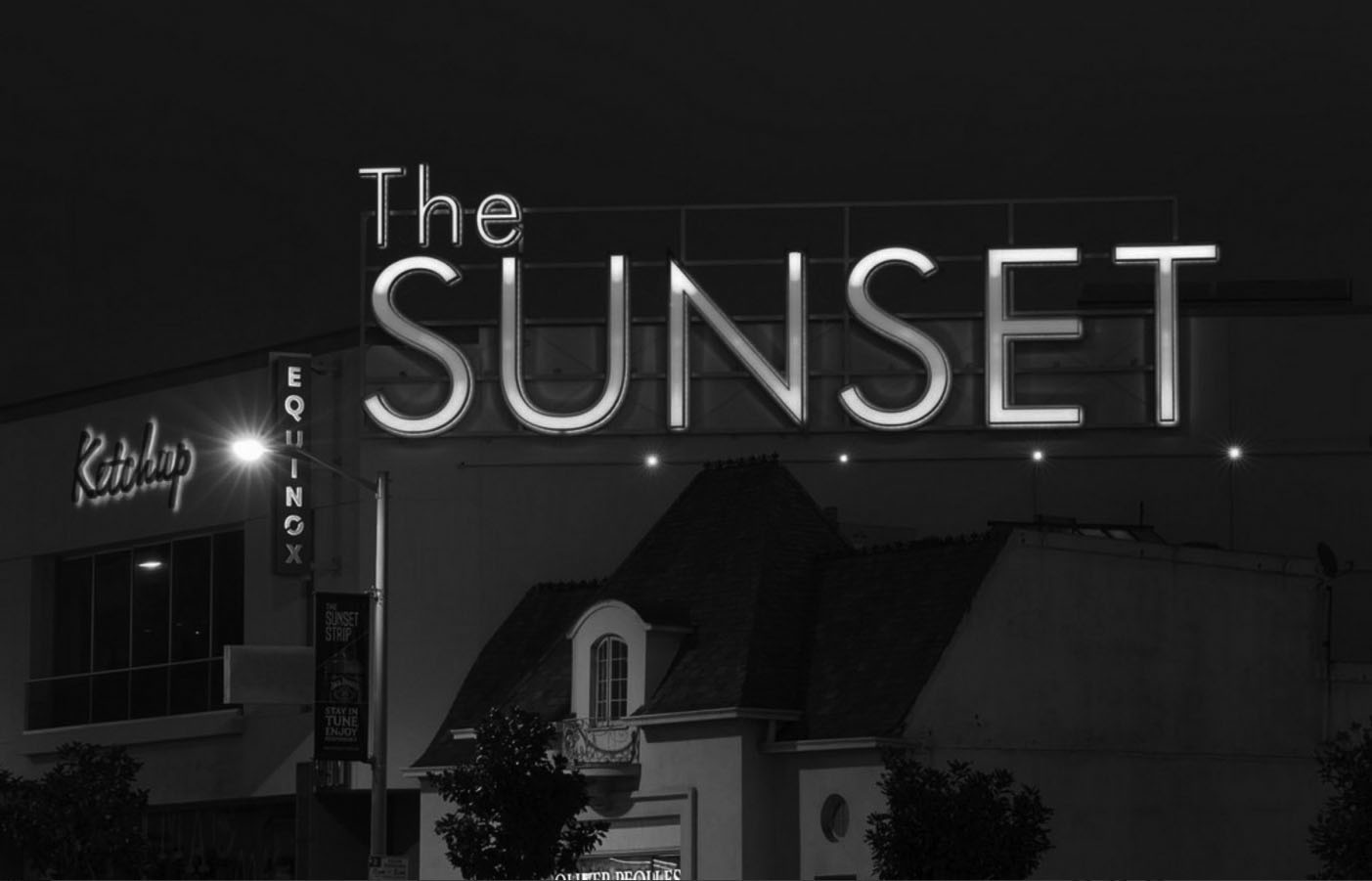 |
|
| (2010)+#+# - A landmark of a sign for the eastbound driver, The Sunset glows like its namesake with a rainbow of plastic-faced, LED lighting. Photo by Joshua Barash |
Villa Nova Restaurant
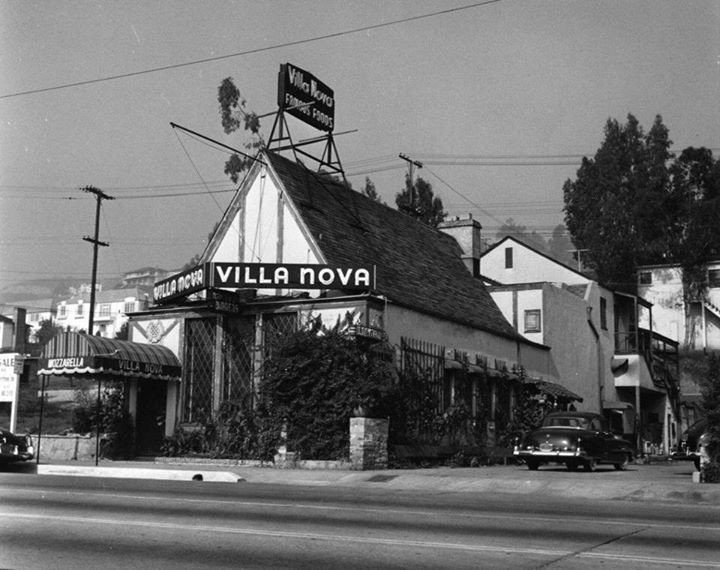 |
|
| (1953)* - View of the Villa Nova Restaurant located at 9015 Sunset Boulevard on the Strip. Photo: Vintage Los Angeles. |
Historical Notes This restaurant was originally called the Mermaid Cafe built in the late 1920's. In 1933 it premiered as The Villa Nova and taken over by film director Vincente Minnelli and silent film actor-director Allen Dale. Marilyn Monroe went on her first blind date with Joe DiMaggio here in 1953 and Vincent proposed to Judy Garland at the Villa Nova in 1945. When Elmer Valentine, Lou Adler and Mario Maglieri took it over in 1972, they originally wanted to call it "Over The Rainbow" in their honor - but the city would not allow the sign to reach a certain height, so they shortened it to, "The Rainbow". |
Rainbow Bar and Grill
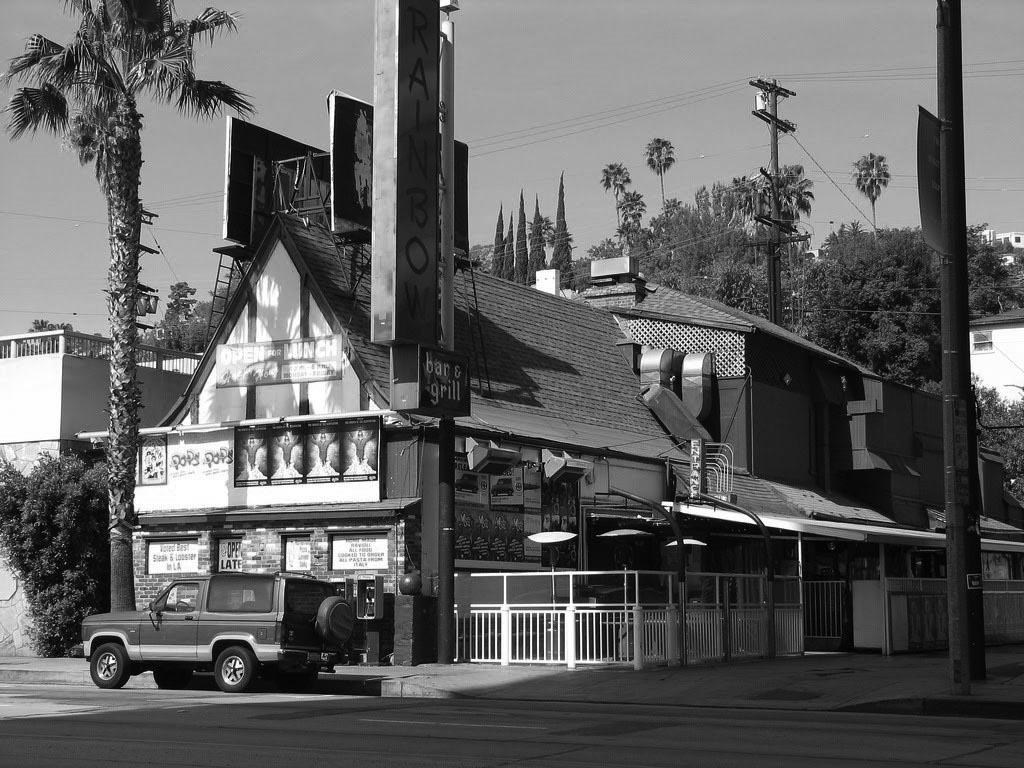 |
|
| (2011)^^## – View showing the Rainbow Bar and Grill (previously the Villa Nova) located on the Sunset Strip in West Hollywood. |
Historical Notes The Rainbow Bar and Grill was founded in early 1972 by Elmer Valentine, Lou Adler, Mario Maglieri and others, opening on April 16, 1972, with a party for Elton John. At the time, the word "rainbow" signified peace and freedom. It quickly became known as a hangout for celebrities of all types. John Belushi ate his last meal (lentil soup) at table No. 16.^ |
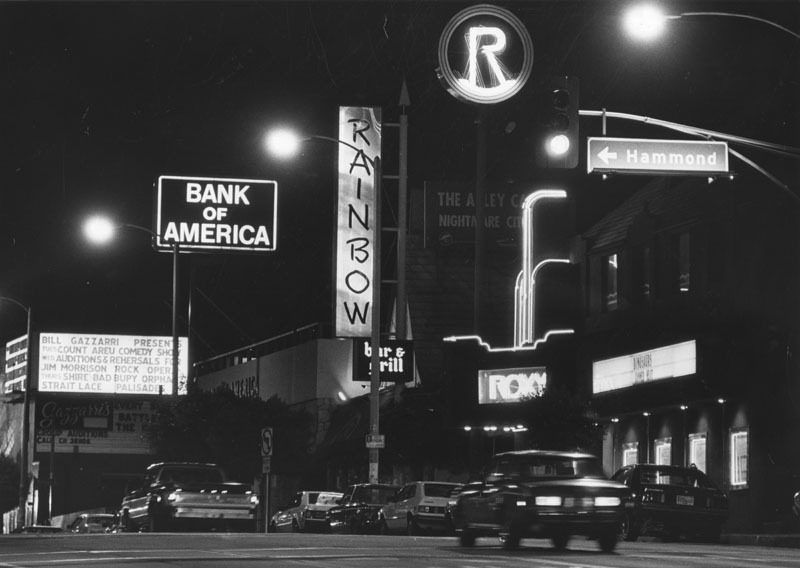 |
|
| (ca. 1980)* – View looking west on Sunset Boulevard showing the Rainbow Bar and Grill (previously the Villa Nova) at center of photo. Bank of America and Gazzarri's Nightclub are on the left with The Roxy at lower-right. |
Historical Notes The Rainbow became known as a hangout for rock musicians and their groupies. Notable regulars at the Rainbow in this period include Keith Moon, Alice Cooper, Micky Dolenz, Harry Nilsson, John Lennon, Ringo Starr, and Neil Diamond. Elvis Presley was known to have occasionally visited the Rainbow. The group of musicians calling themselves the Hollywood Vampires made the Rainbow their home away from home in the mid-1970s. In the last two decades of his life, Motörhead frontman Lemmy was a daily fixture at the Rainbow whenever the band was not on tour, and often played a video poker machine at the end of the bar table.^ |
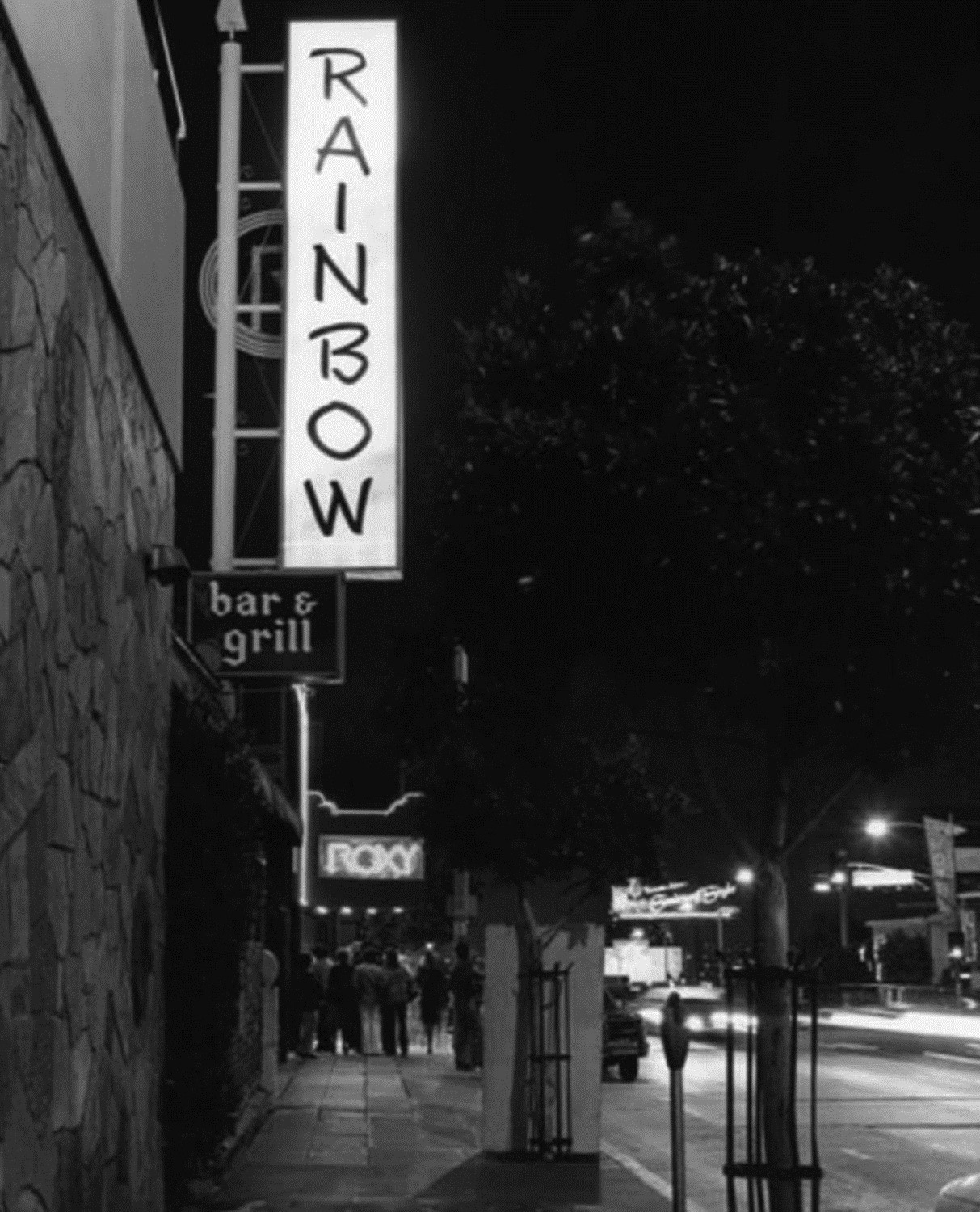 |
|
| (1980)* - The Rainbow Bar & Grill with The Roxy next door. West Hollywood |
Historical Notes Los Angeles songwriter Warren Zevon referenced the scene at the Rainbow in the last verse of his 1976 song "Poor Poor Pitiful Me". The musical group Rainbow was named after this club.^ |
Roxy Theatre
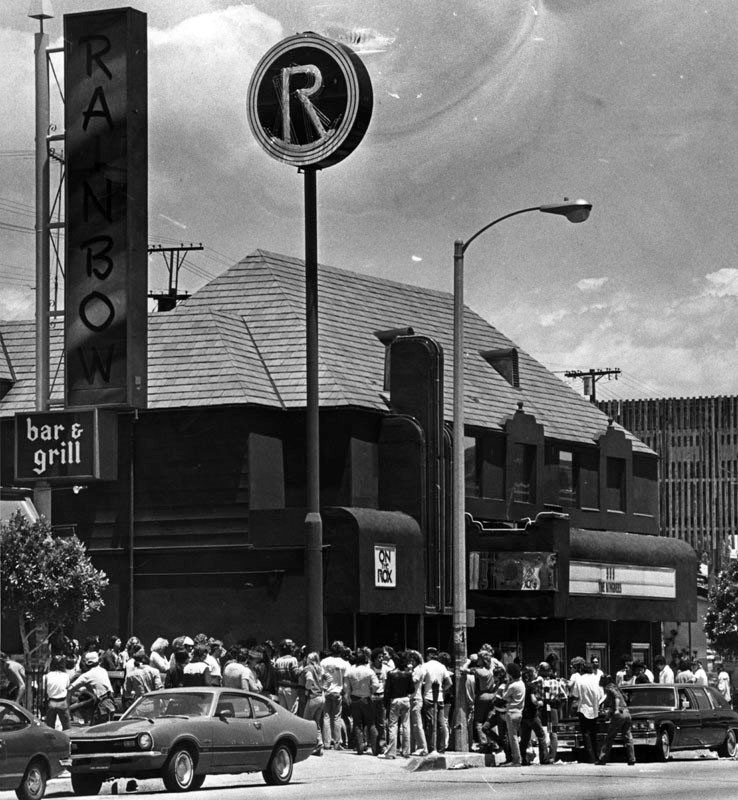 |
|
| (1980)* - A long line of customers wait on the sidewalk outside the Roxy to get in a see a live rock show. The sign for the neighboring restaurant, Rainbow Bar & Grill, is visible on the left. |
Historical Notes The Roxy was opened on September 23, 1973, by Elmer Valentine and Lou Adler, along with original partners David Geffen, Elliot Roberts and Peter Asher. They took over the building previously occupied by a strip club owned by Chuck Landis called the Largo. (Adler was also responsible for bringing the stage play The Rocky Horror Show to the United States, and it opened its first American run at The Roxy Theatre in 1974, before it was made into the movie The Rocky Horror Picture Show the next year. *^ |
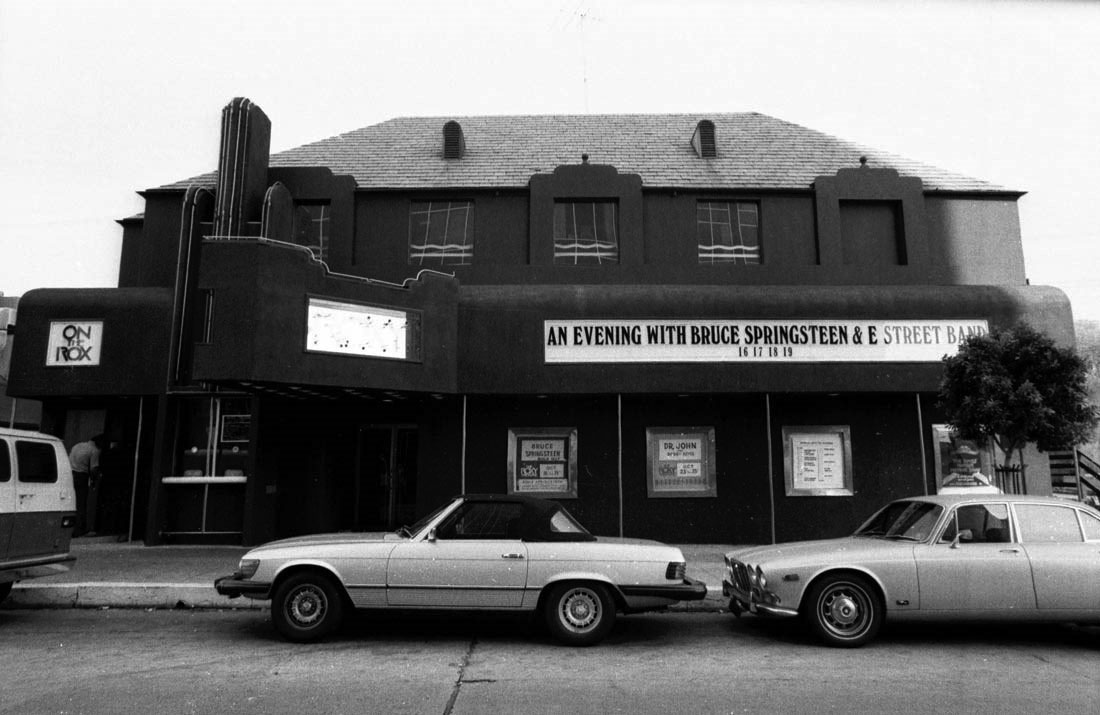 |
|
| (1975)^+++ – Front view of the Roxy Theatre at 9009 W. Sunset Boulevard. Billboard reads: “An Evening with Bruce Springsteen & E Street Band” |
Historical Notes Neil Young and his band The Santa Monica Flyers played the Roxy for the first week it was open. Only three months later, the original Genesis lineup with Peter Gabriel played several consecutive days at the Roxy, a run that some band members and many fans consider to be amongst their finest performances (due partially to the intimate atmosphere and good acoustics of the venue, as well as the legendary reputation of "Hollywood" amongst performers around the world). Paul Reubens, then a struggling comedian, introduced his Pee-wee Herman character in a raunchy revue here in 1981 that included other aspiring comics including Phil Hartman and Elayne Boosler. *^ |
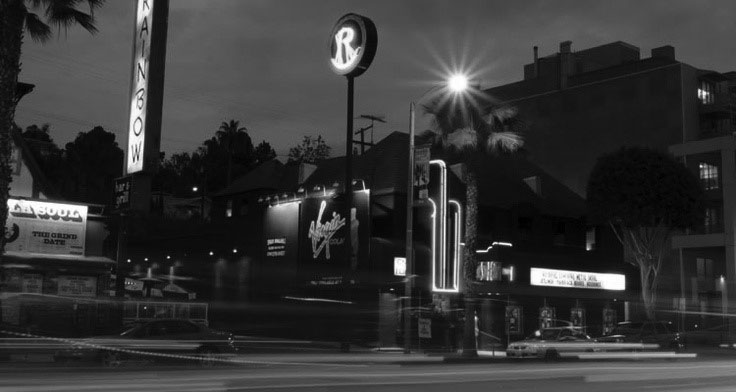 |
|
| (n.d.)#* – Nighttime view of the Roxy Theatre with the Rainbow Bar and Grill on the left. |
Historical Notes The small On the Rox bar above the club has hosted a wide variety of debauchery in its history. The bar was a regular hangout for John Lennon, Harry Nilsson, Alice Cooper and Keith Moon during Lennon's "lost weekend" in 1973-74 and hosted parties arranged by Heidi Fleiss in the 1980s. *^ |
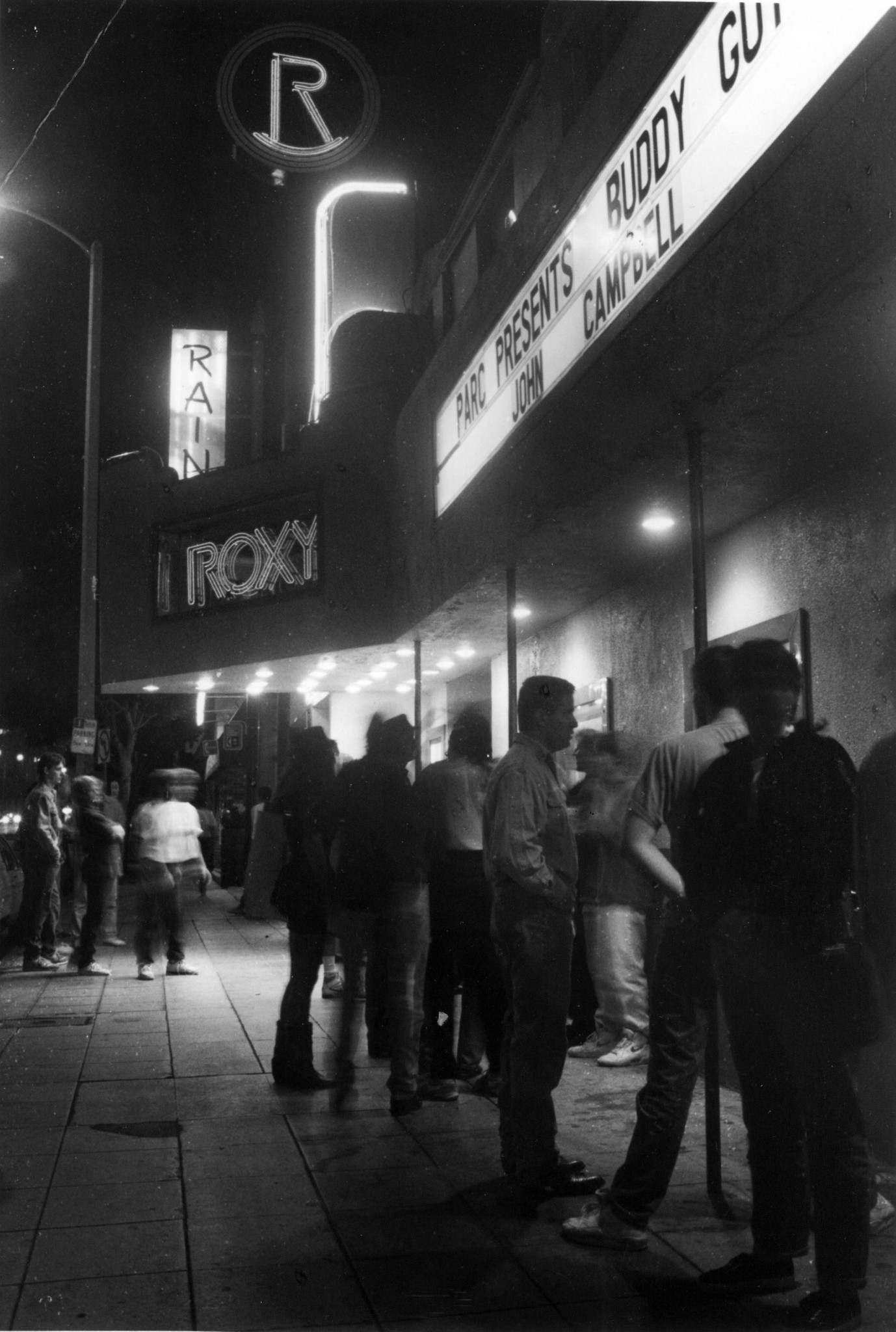 |
|
| (1991)^^# - People gather outside the Roxy Theater on the Sunset Strip, 9009 Sunset Boulevard. (Mike Meadows / Los Angeles Times) |
Historical Notes The Roxy Theatre/Nightclub with a capacity of 500 is owned by Lou Adler and Nic Adler. *^ |
* * * * * |
Sunset Blvd, Doheny Rd, and Corey Ave
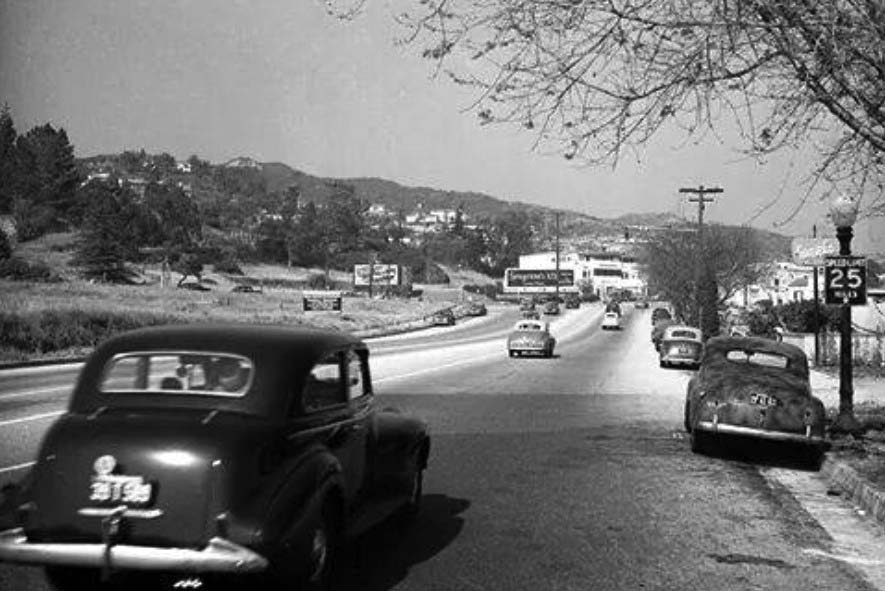 |
|
| (1938)##^* - View looking northeast on Sunset toward Doheny Road and Cory Avenue. Doheny Road branches off to the left at the black billboard. The white building at center is still standing. Luckman Plaza now occupies the block to the right. |
Historical Notes Doheny Road and Doheny Drive, named after the early 20th Century oil tycoon – Edward L. Doheny, is a north–south thoroughfare mostly through Beverly Hills and West Hollywood. It starts a few blocks south of Pico Boulevard in the city of Los Angeles, and travels northwards, crossing Wilshire Boulevard, Santa Monica Boulevard, and other east/west streets, and ends after crossing Sunset Boulevard. |
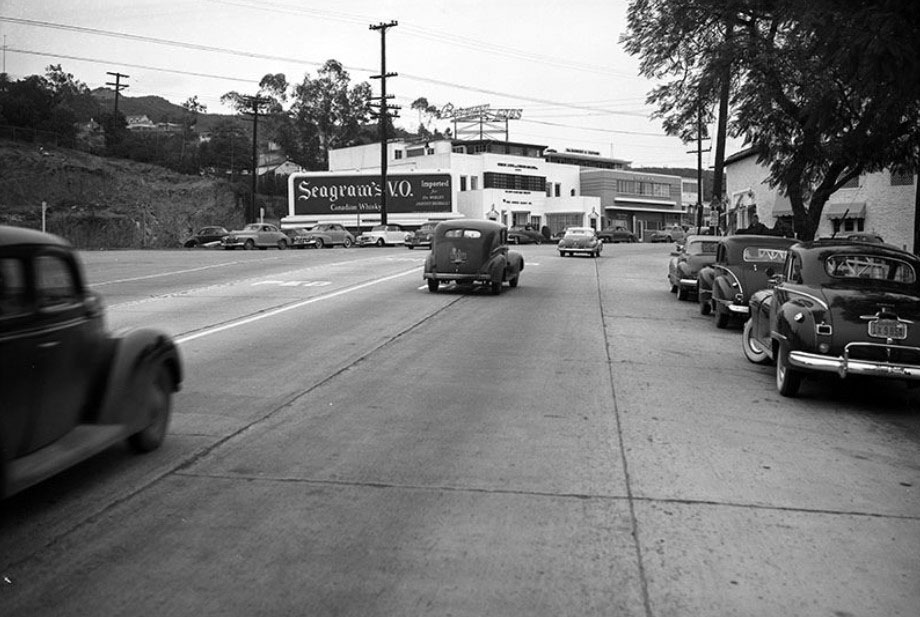 |
|
| (1940s)^##* – View looking northeast on Sunset Boulevard at Cory Avenue (runs to the right) and Doheny Road (runs to the left). The Berman Furs Building can be seen in the distance, where Sunset turns west. Click HERE for contemporary view. |
Berman Furs Building
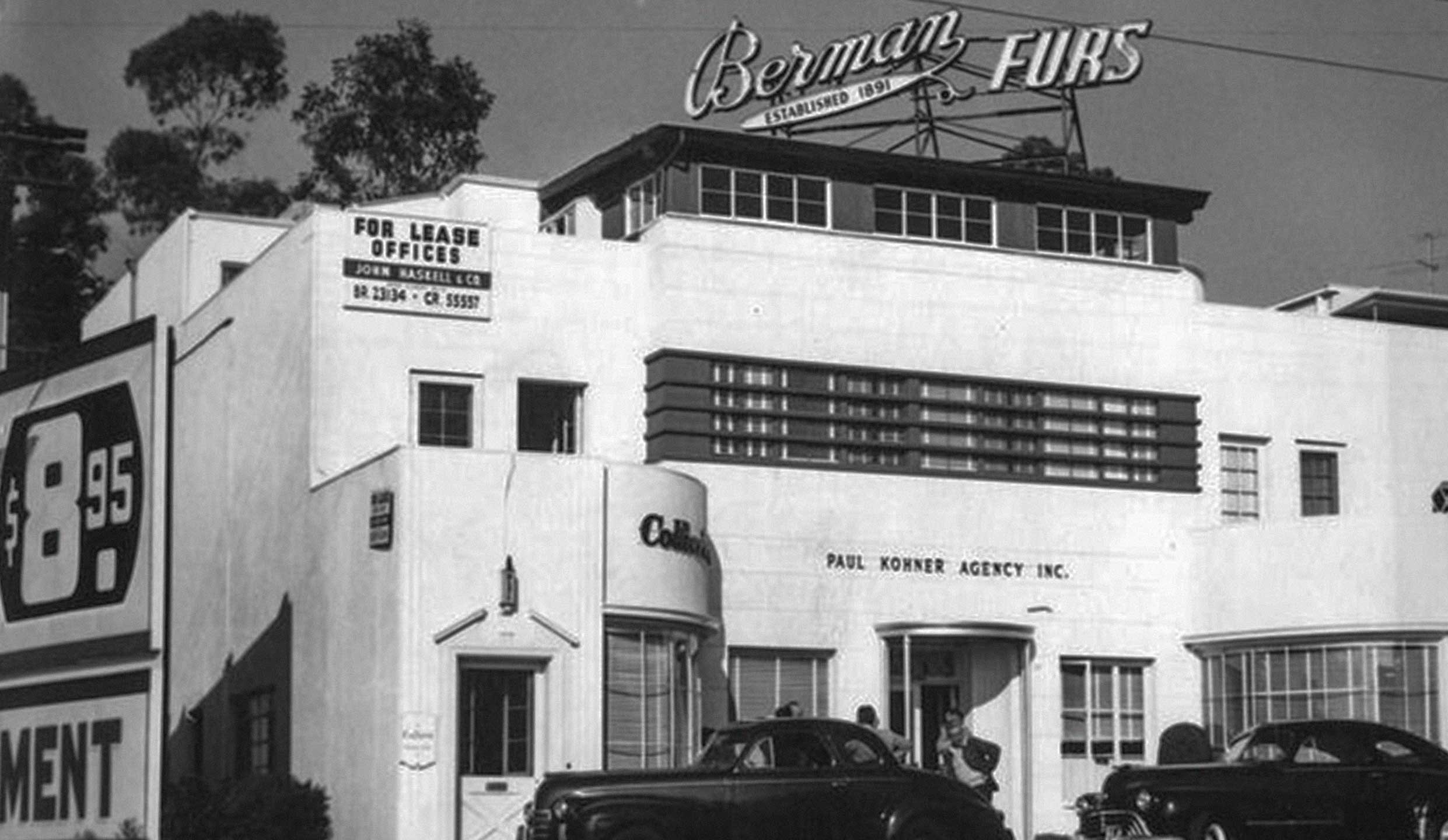 |
|
| (1936)* – View showing the Paul Williams designed Berman Furs Building located at 9169 Sunset Blvd |
Historical Notes This streamline-moderne/classical building was designed by architect Paul Williams for the Berman Fur Company in 1936. Filmaker Hal Roach briefly had a jewelry business on the ground floor. It later housed the offices of agent Paul Kohner. |
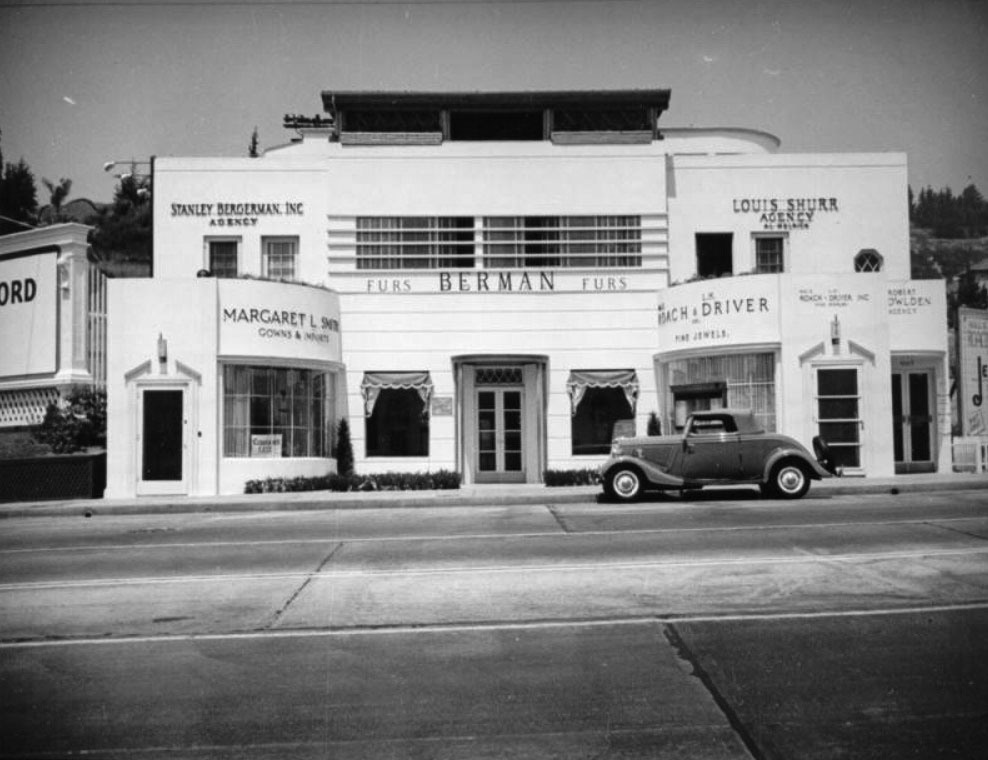 |
|
| (ca. 1937)* - View showing the Berman Furs Building as seen from across Sunset Blvd. The building still exists today. Click HERE for contemporary view. |
* * * * * |
Sunset and Doheny Road
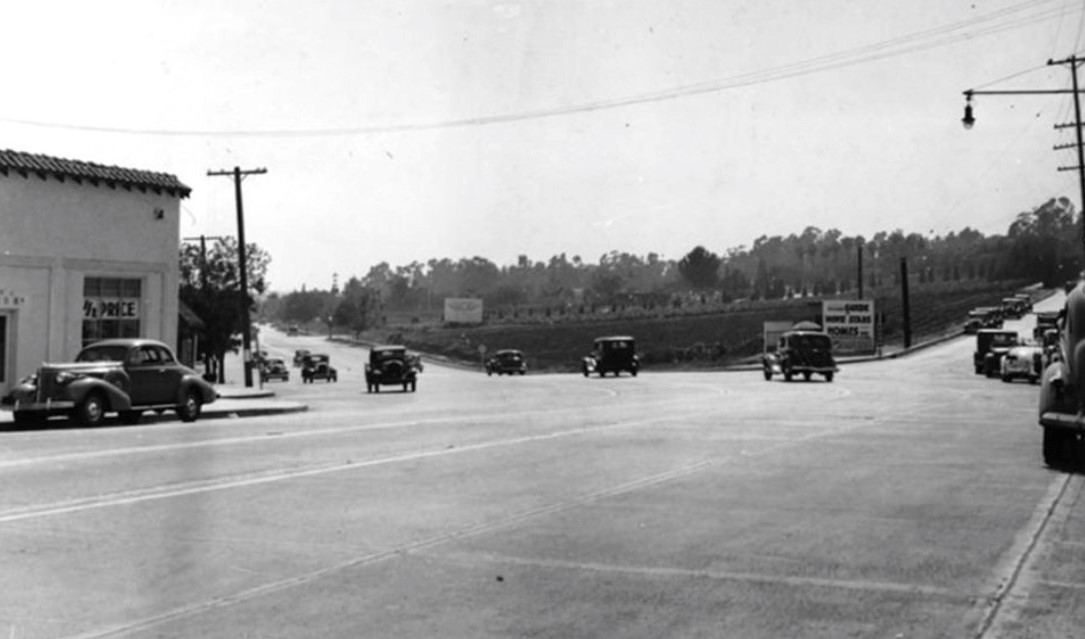 |
|
| (ca. 1938)* – View looking west on Sunset Boulevard with Doheny Road running to the right and Cory Avenue running south (out of view). |
Then and Now
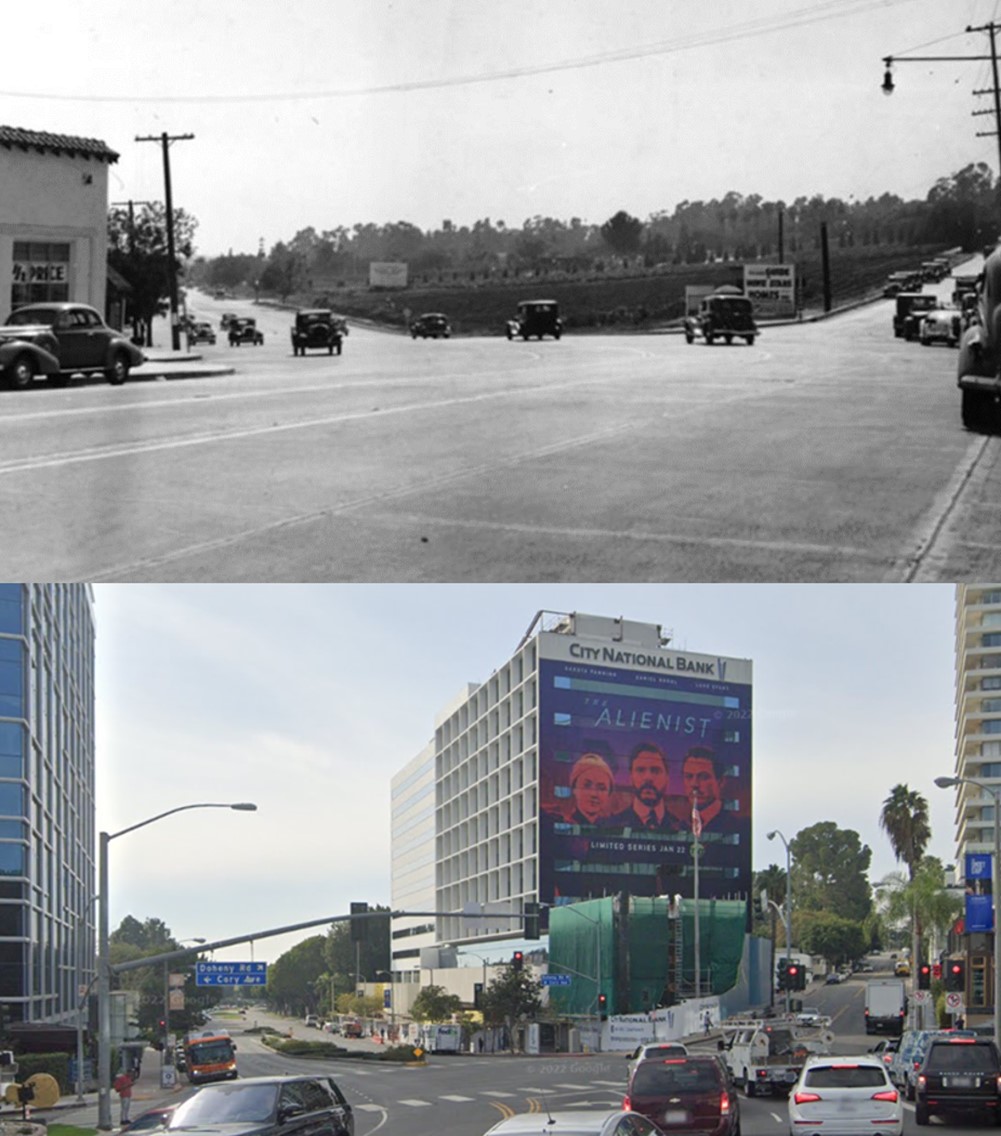 |
|
| (1938 vs. 2018)* – View looking west on Sunset Boulevard with Doheny Road running to the right and Cory Avenue running south (out of view). |
* * * * * |
Bit of Sweden Smorgasbord
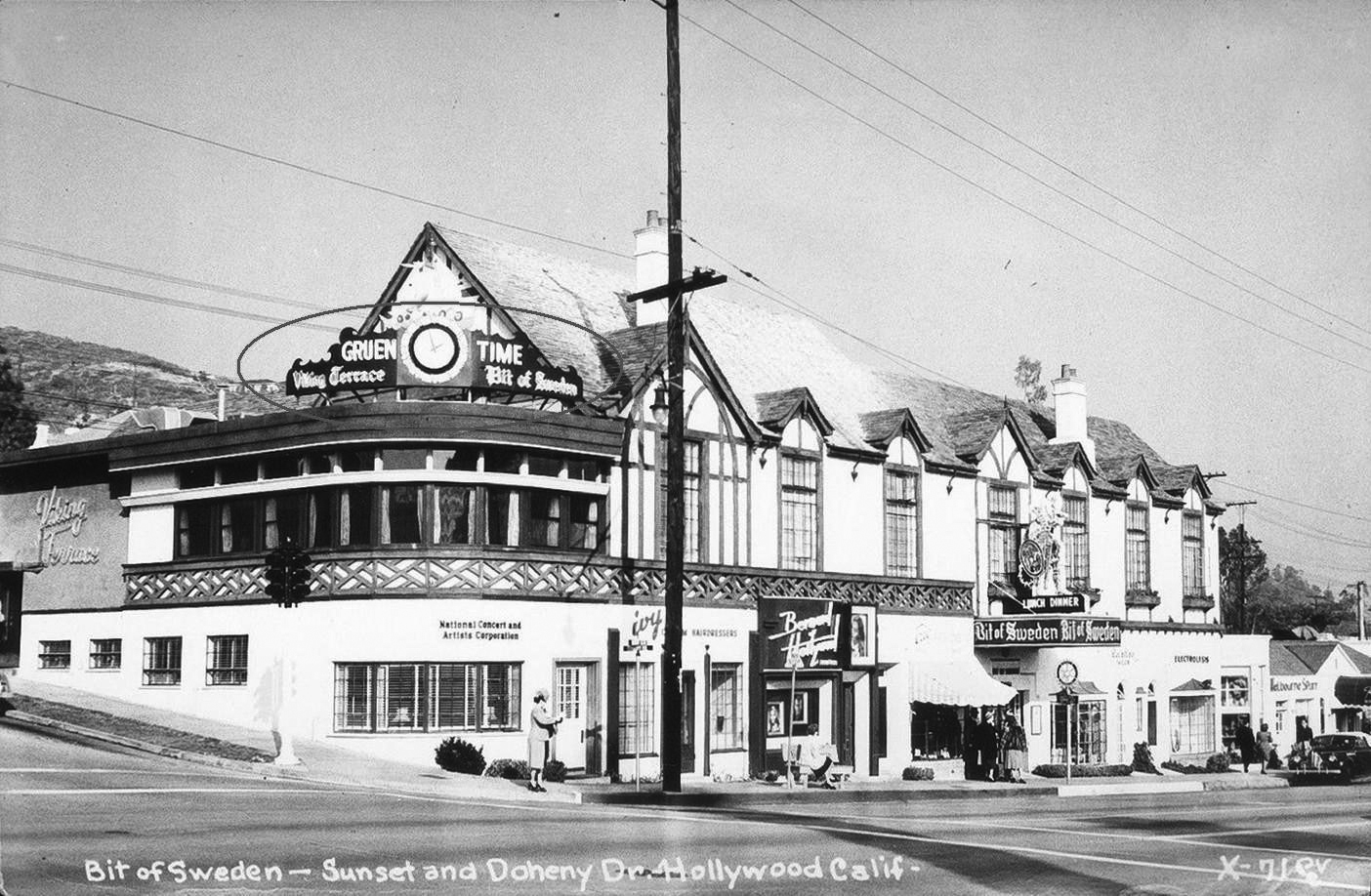 |
|
| (ca. 1936)* – Postcard view showing the Bit of Sweden Smorgasbord Restaurant located on the N/E corner of Sunset Boulevard and Doheny Drive. |
Historical Notes The word “smorgasbord” is something we take for granted these days, but back in 1936 when a Swedish restaurant called ‘Bit of Sweden’ opened at the corner of Sunset Boulevard and Doheny Drive, it introduced the concept of the smorgasbord to curious Angelinos. |
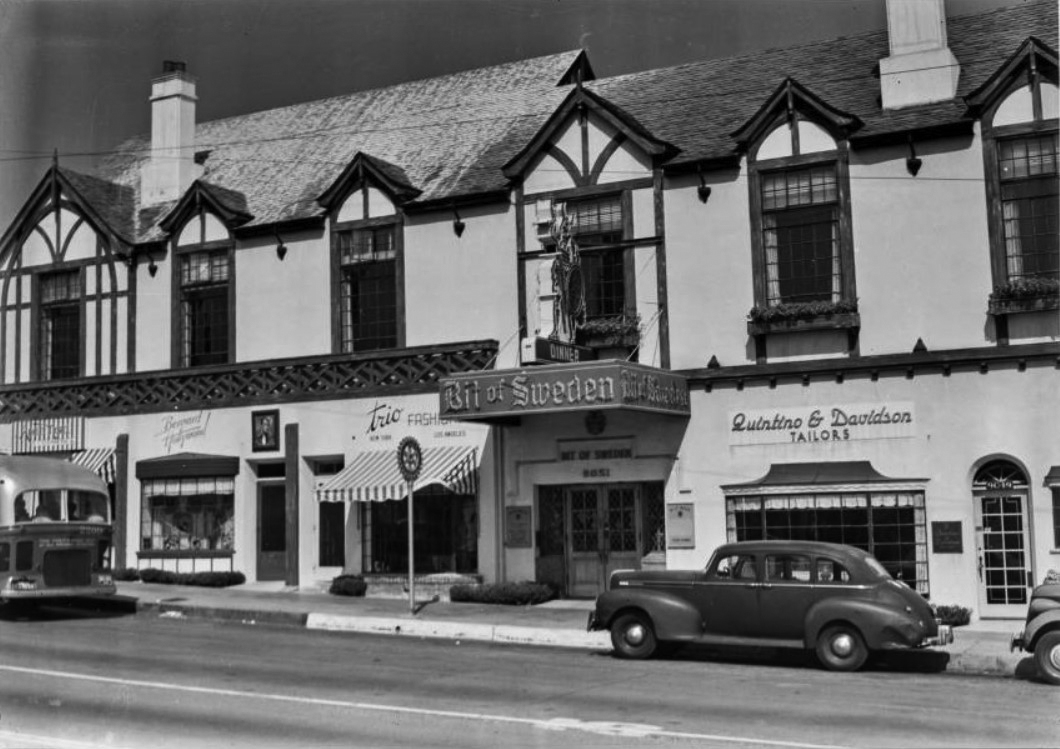 |
|
| (1940s)^** - View of the Bit of Sweden Restaurant located at 9051 Sunset Boulevard in West Hollywood with Quintino & Davidson Tailors, Trio Fashions, Bernard of Hollywood, and other shops next door. |
Now and Then
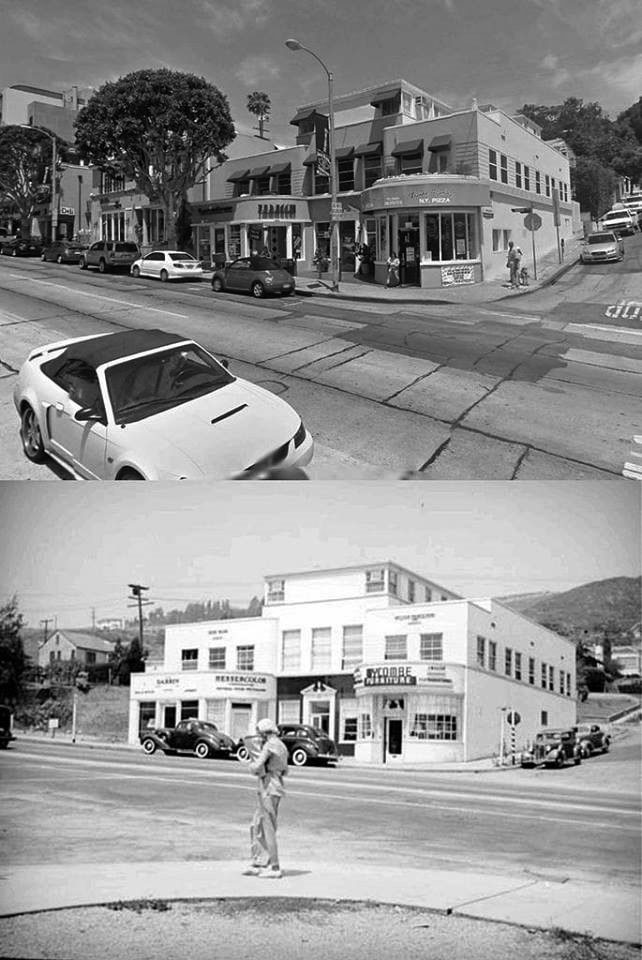 |
|
| (1936) vs. (2018)^.^ - View showing the northwest corner of Hilldale Avenue and Sunset Boulevard. Click HERE to see more contemporary views. |
Simon's Drive-in (later Dolores Drive-in)
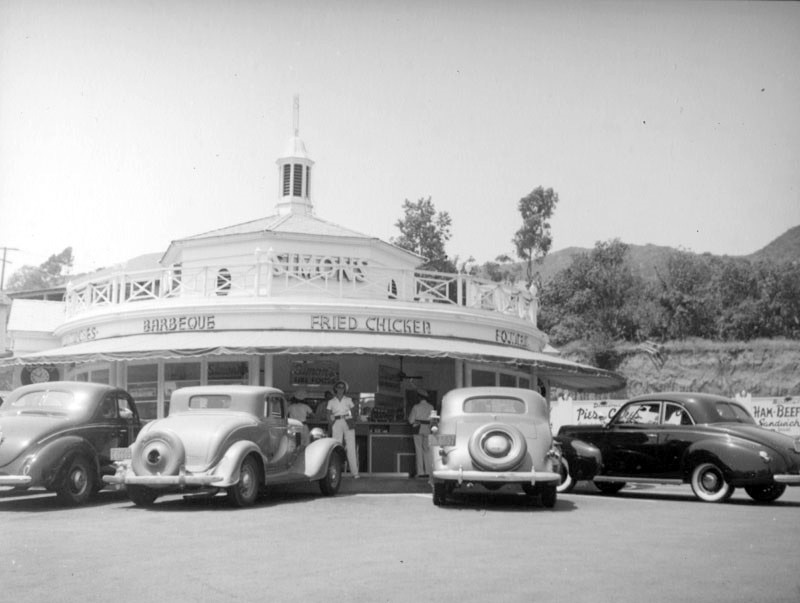 |
|
| (ca. 1938)* - Cars circle this colonial style Simon's, located at 8801 Sunset Boulevard at the corner of Horn Avenue in West Hollywood. The drive-in features fried chicken, barbecue. |
Historical Notes This was a Simon’s Drive-in from 1935 until 1945 when Dolores Drive-in took over. It became Jack’s on the Strip Drive-in sometime in the 1950s. The building stood until the mid-1960s when it was demolished to make way for a succession of music stores, Muntz Stereo and then Tower Records (1971). Click HERE to see more Early Views of LA Drive-in Restaurants. |
Dolores Drive-in (previously Simon's Drive-in)
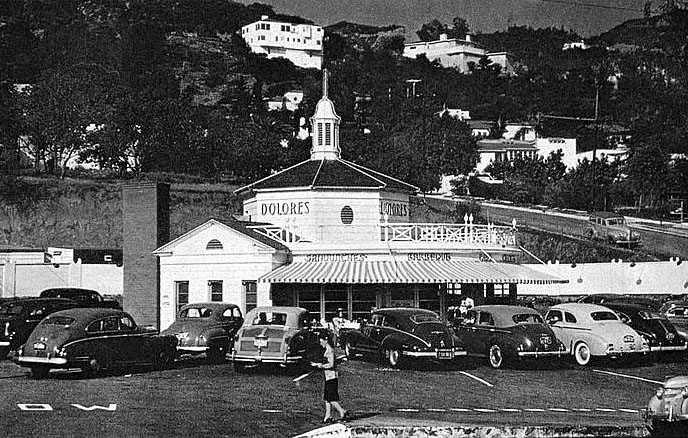 |
|
| (ca. 1945)**## – View showing Dolores Drive-in Restaurant located at 8801 Sunset Boulevard, previously a Simon's Drive-in (1935 - 1945). |
Historical Notes The Strip’s lone drive-in restaurant at the time, it was originally occupied by a branch of the Simon’s chain. The understated colonial-style building was markedly different that the orbit-shaped, neon-ringed Art Deco Simon’s further east at 6760 Sunset Blvd. near Hollywood High School. It opened as Dolores Drive-in here about 1945, its first Los Angeles location. |
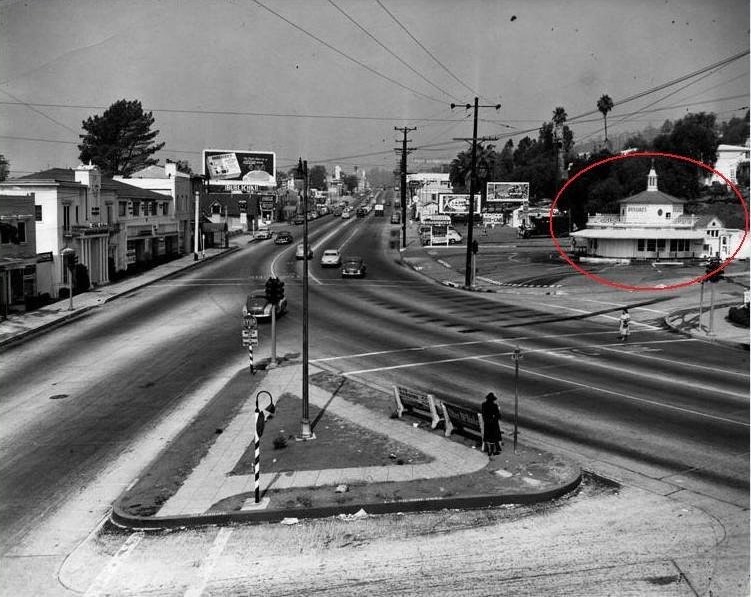 |
|
| (1940)* – Looking west on Sunset Boulevard where it forks with Holloway Drive. Dolores Drive-in is seen on the right, N/W corner of Sunset and Horn Ave. |
Historical Notes Dolores would only last until the 1950s when it became Jack’s on the Strip Drive-in. The building stood until the mid-1960s when it was demolished to make way for a succession of music stores, Muntz Stereo and then Tower Records (1971). Click HERE to see more Early Views of LA Drive-in Restaurants. |
Muntz Stereo
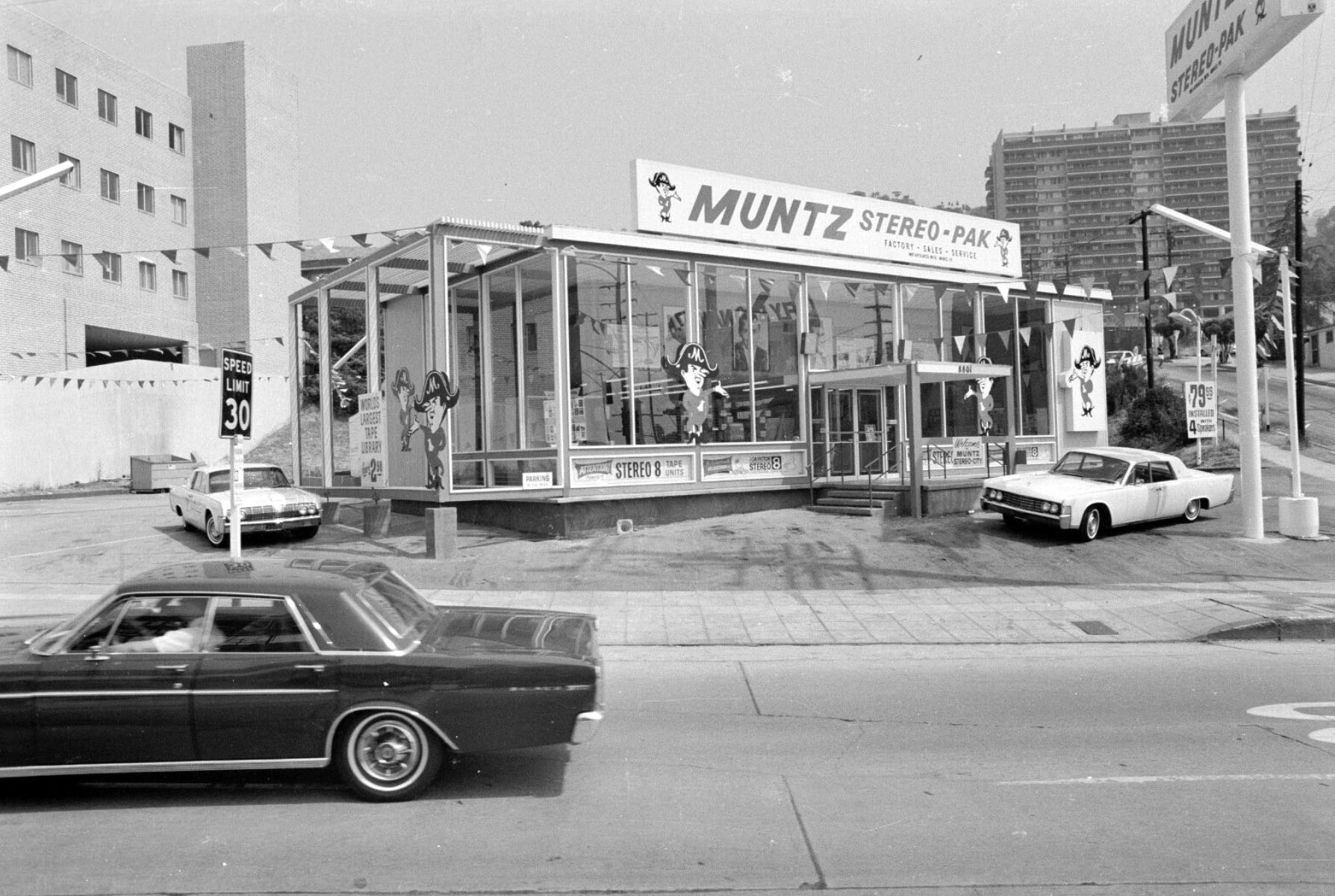 |
|
| (1966)* – Muntz Stereo located at 8801 Sunset Boulevard, previously the site of Dolores Restaurant. From Ed Rushca’s 12 Sunsets. |
Historical Notes The original Dolores Diner is behind the building. Muntz used that space for his car stereo installations. This building was originally built as a model used to sell the condos in the Shoreham building in 1961. Budget Rent-A-Car took it over, and then Muntz added that framing extenstion on the west side of the building. The above building was a music store and showroom for "Madman" Muntz's Stereo Paks, the first successful car stereo system "and a popular hangout for teenagers in the '60s." (In addition to inventing 4-tracks, Muntz popularized the nickname "TV" for television. Tower Records moved into the building in 1971. |
Café La Maze
.jpg) |
|
| (1937)^***^ – View of the Café La Maze, located at 9039 Sunset Boulevard. The popular restaurant had a lounge area called The Key Club. |
Historical Notes In 1935, Marcel Lamaze, founded the original Café La Maze on Sunset Boulevard. Marcel was a legendary and influential Restaurateur & Maître D in the Los Angeles area during the Golden Age of Hollywood. The Hollywood location was a Movie Star Hangout, where Marcel was well connected with the movie star crowd. Marcel was known to be a good friend of Jimmy Durante and loved to Play Poker with the Marx Brothers.^**^ |
.jpg) |
|
| (ca. 1937)##^* – View looking southeast toward the south side of Sunset Boulevard from the front entry to the Café La Maze. Across the street can be seen the Crosby Building at right, home to the Finlandia Baths. |
Historical Notes In the 1940s the Café La Maze would become Sherry's Restaurant. |
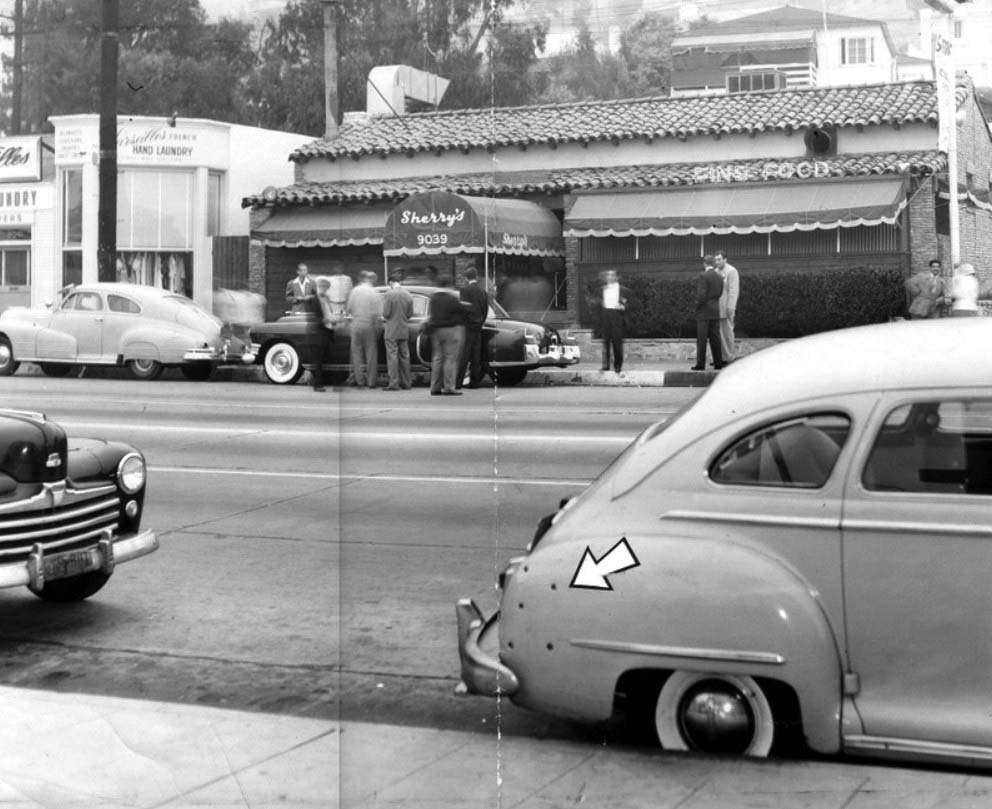 |
|
| (1949)^^ - View showing Sherry's Restaurant (previously Café La Maze) located at 9039 Sunset. A group of men surround a car in front of the restaurant that was the scene of a shooting. An arrow points to bullet holes in the rear fender of a car parked across the street. |
Historical Notes During the 1940s Sherry’s was popular with L.A.’s mafia element. On July 20, 1949 gangster Mickey Cohen and 3 others were ambushed at 3:45 a.m. in front of the restaurant on the Sunset Strip. Mickey's car drove up to the curb and gunmen (hiding across the street under an advertising sign – out of view) opened fire with shotguns. The gunmen then sped away in a gray auto, tossing out the guns a block away. Mickey was the least seriously wounded.*# Sherry’s later became the famous rock club Gazzari’s on the Strip. |
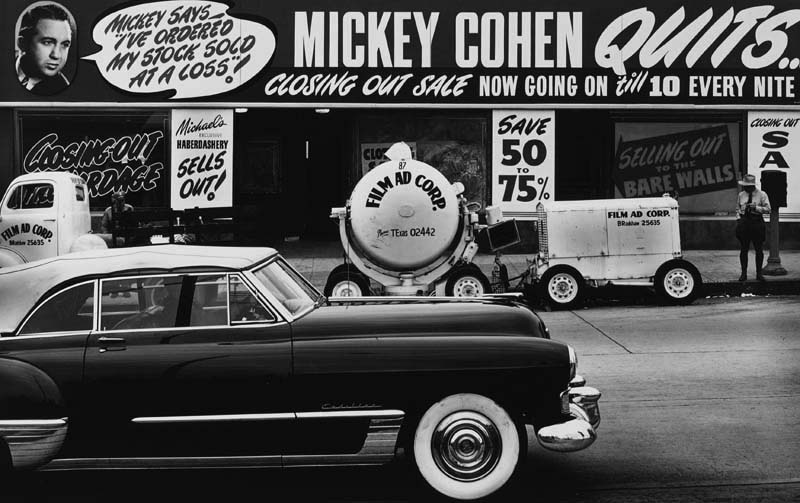 |
|
| (1950)* – View showing a 1949 Cadillac Series 62 Convertible Coupe heading west on Sunset Boulevard. There is a closing out sale at Mickey Cohen men’s clothing store on the south side of Sunset. |
Historical Notes Mickey Cohen was a well-known mobster with close ties to the Mafia (circa 1940s.) As a front, Cohen operated a men’s clothing store at 8804 Sunset Blvd (on the Strip). His office was in the back of the store where he took care of…ahem…“business.” Cohen always insisted he was simply a small businessman selling men’s clothes. Apparently even Cohen gave up pretending when he closed his store in January 1950. |
Gazzarri's
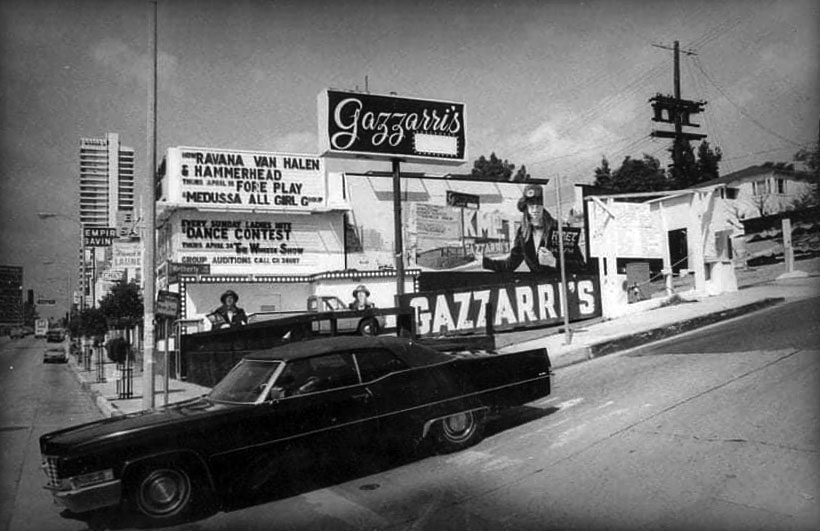 |
|
| (1974)* – A Cadillac convertible drives by Gazzarri’s Nightclub, located on the NW corner of Sunset and Wetherly Drive, where Van Halen is one of the featured groups. Photo courtesy of BraveWords |
Historical Notes Gazzarri's nightclub on the Sunset Strip was most notable as the location where The Doors and Van Halen were featured house bands for long stretches before being discovered. It was also the LA club featured in Huey Lewis and the News MTV video for their hit "The Heart of Rock and Roll." |
.jpg) |
|
| (1970s)^ - View of Gazzarri’s on the Strip (previously Sherry's Restaurant and the Café La Maze). Marquis reads: Dance Contest – Real Don Steele Show |
Historical Notes Gazzarri's reached its peak of popularity in the late 1960s, featuring Jim Morrison's young new group, along with other LA talent such as The Bobby Fuller Four, Buffalo Springfield, and The Walker Brothers. It then achieved major LA relevance again in the late 70's, featuring the David Lee Roth-led Van Halen nightly for months on end, and then into the 1980s thru the early 90's as one of the top LA glam metal nightclubs. It was owned and operated by the "Godfather of Rock and Roll", Bill Gazzarri. Gazzarri himself was known for dressing up as a Chicago-style gangster and frequenting the club on performance nights. Located near the corner of Doheny and Sunset Boulevard in West Hollywood, and just several dozen yards from both the Rainbow Bar and Grill and The Roxy Theatre, Gazzarri's became famous as a launching pad for future rock and roll stars.* |
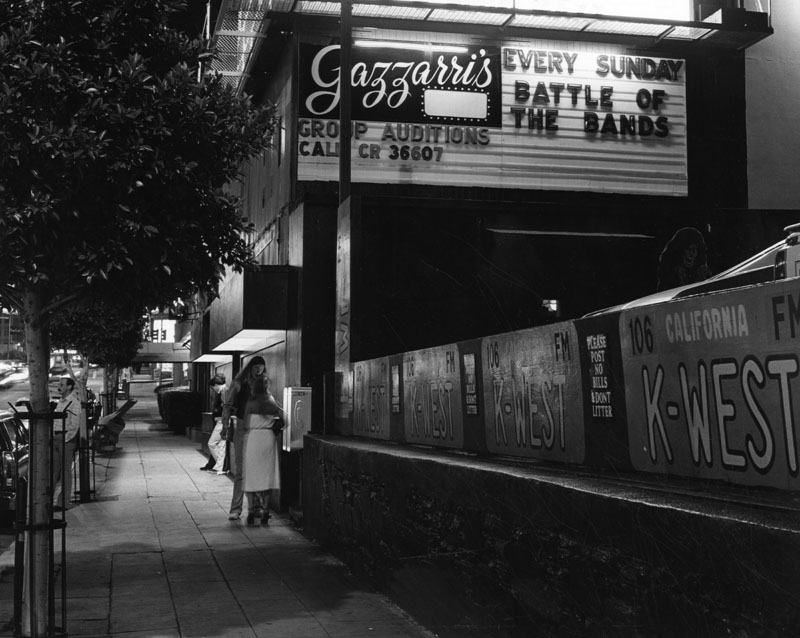 |
|
| (1980)* - Exterior view of Gazzarri's nightclub on the Sunset Strip, with a sign which reads, "Every Sunday battle of the bands." |
Historical Notes Bill Gazzarri died in 1991 and the club closed down in 1993. In 1994, the building suffered irreparable damage from the Northridge earthquake. It was torn down in 1995 and a new club called Billboard Live was built on the former Gazzarri's site. It opened in 1996. Billboard Live became The Key Club in 1998 (which was the lounge name of the original Café La Maze).* |
* * * * * |
Mammy Louise's Bayou
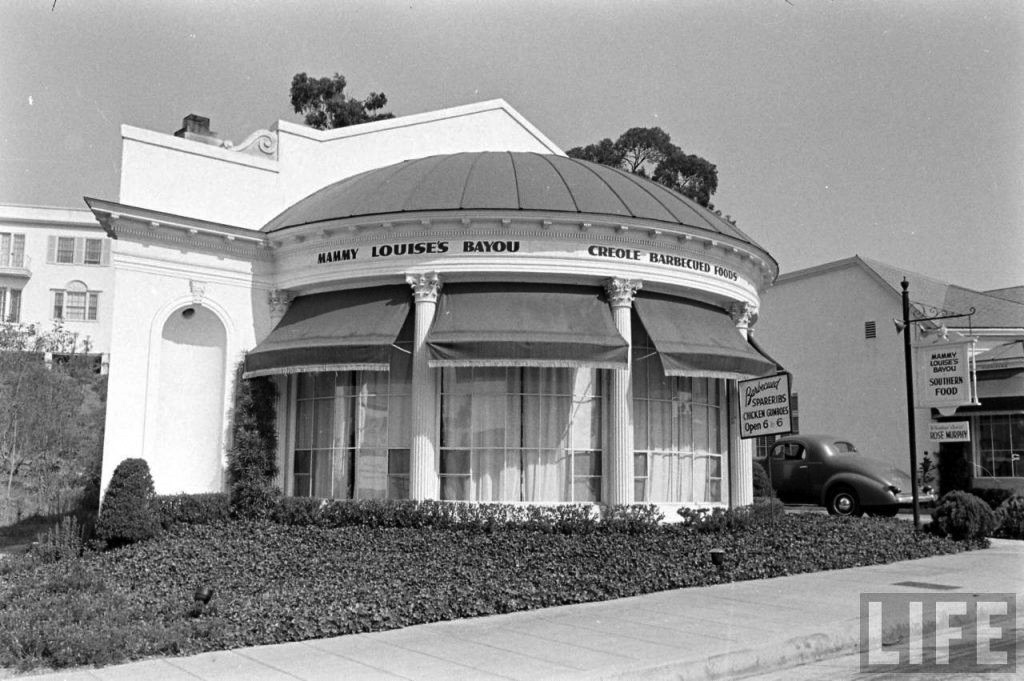 |
|
| (ca. 1935)**## – Life Magazine photo showing Mammy Louise’s Bayou, a restaurant located at 8711 Sunset Boulevard. |
Historical Notes The restaurant was run by a black woman named Louise Brooks but owned by Phil Selznick, who was David O. Selznick’s uncle. He also took over the It Café on Vine Street from Clara Bow, and Club Versailles at 8590 Sunset, which was rumored to be a front for Bugsy Siegel and later became Mocambo. Something dodgy was going on because Mammy Louise’s Bayou was raided in the fall of 1938 and subsequently went under. Its next incarnation was an upscale lesbian bar called Cafe Internationale. Today the building, after a major renovation, has been converted into a furniture store. Click HERE for contemporary view. |
* * * * * |
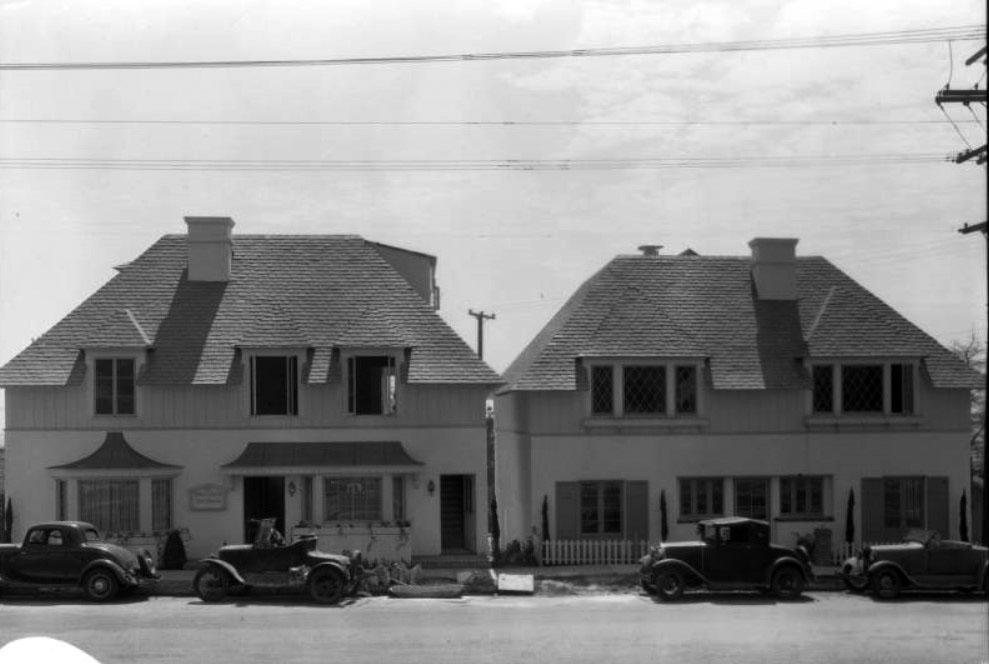 |
|
| (ca. 1935)^^ - View of the offices of Hoffman-Schlager, Inc. and David C. Werner, Inc. at 8776 Sunset Boulevard with early-model automobiles parked in front. |
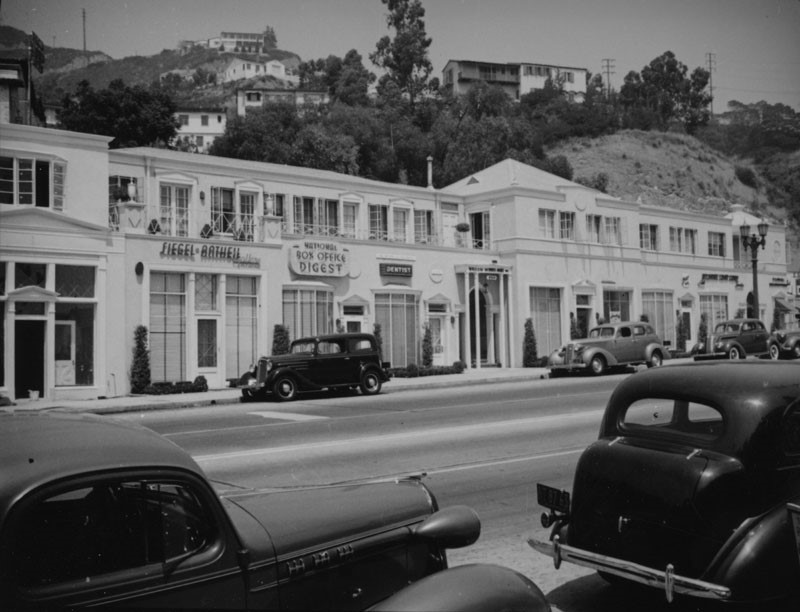 |
|
| (ca. 1938)* - Photo taken from across the street showing a large 2-story commercial building located along Sunset Blvd. in the city of West Hollywood. Some identifiable businesses calling this colonial-looking building home are: "Siegel & Bathiel Gallery", "National Box Office Digest", and a dental office, among others. |
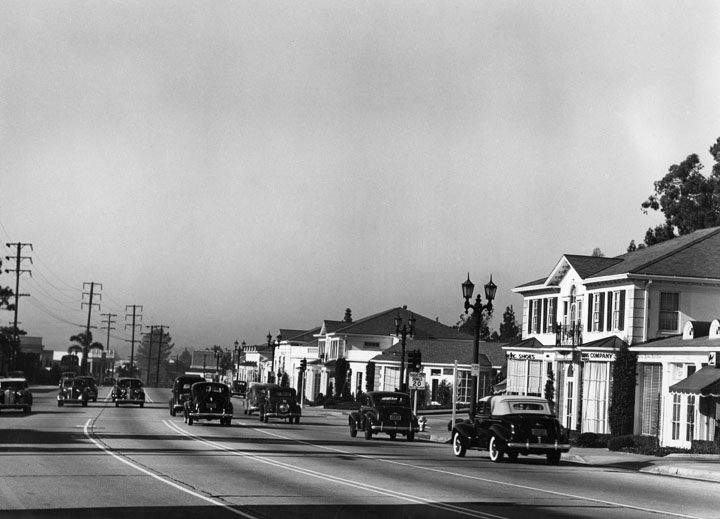 |
|
| (1939)* - Sunset Strip looking north-west, west of La Cienega. |
Then and Now
 |
|
| (ca. 1939)* - View looking toward the SE corner of Sunset Blvd and Carol Drive. Cars are parked in front of a row of shops on the 9100 block of Sunset; a sign for a florist is seen on the far left. Doheny is on the far left out of view. |
Historical Notes In the 80s and 90s these buildings (as well as the office buildings on the east side up to Doheny) all comprised the headquarters of Geffen Records. |
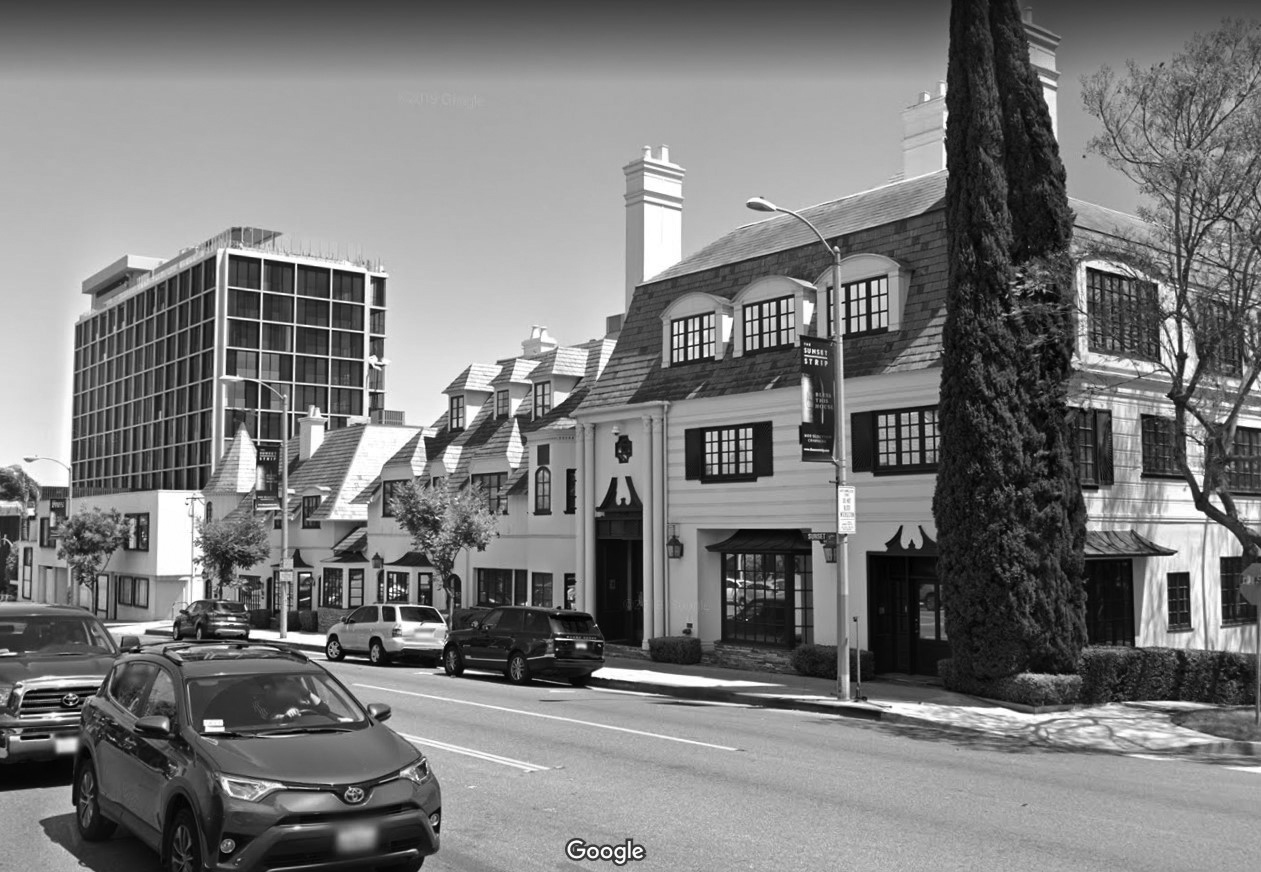 |
|
| (2019)** - View showing the 9100 block of Sunset Boulevard as it appears today. |
Then and Now
 |
|
| (1936)#**# – View of the 9100 block of the Sunset Strip showing a couple of charming tudor-style office buildings which still stand today. View is looking southwest. |
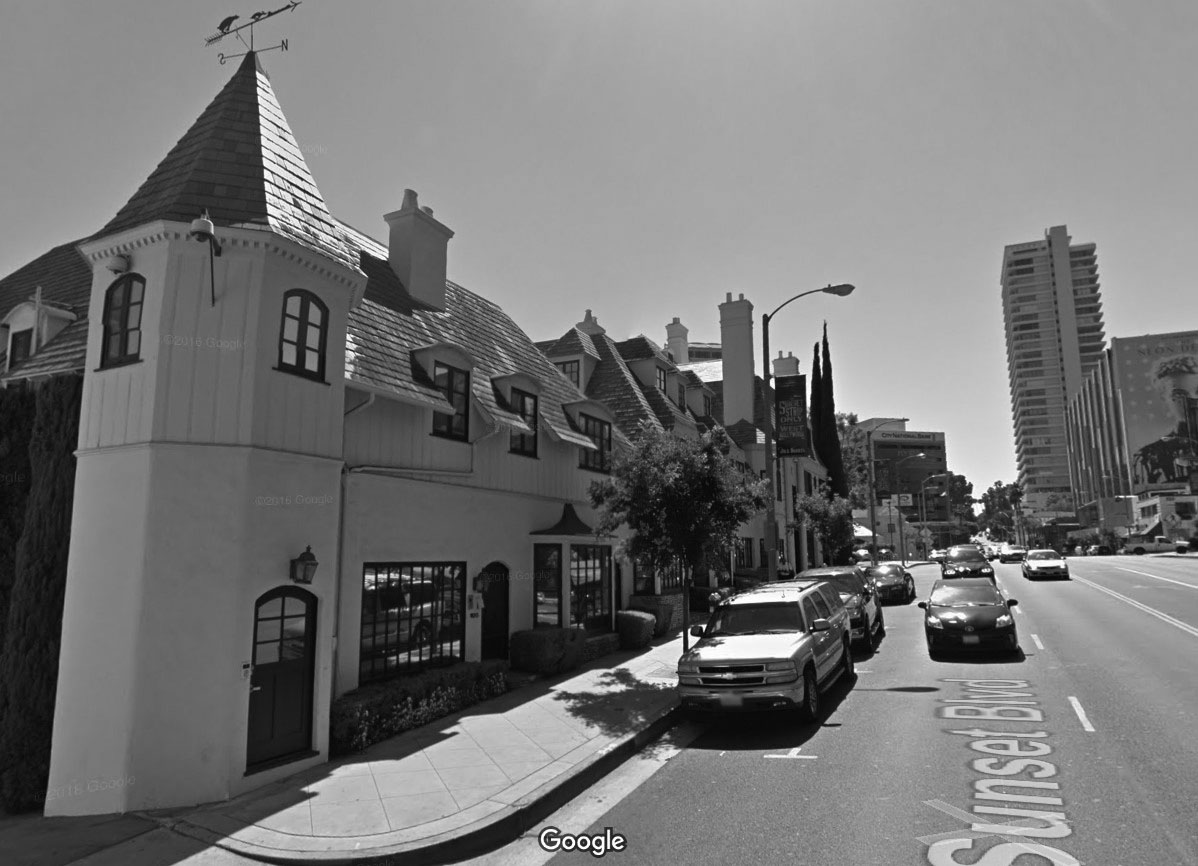 |
|
| (2016)*### – Google Street View looking west on Sunset Boulevard showing the 9100 block of the Sunset Strip. |
Finlandia Baths
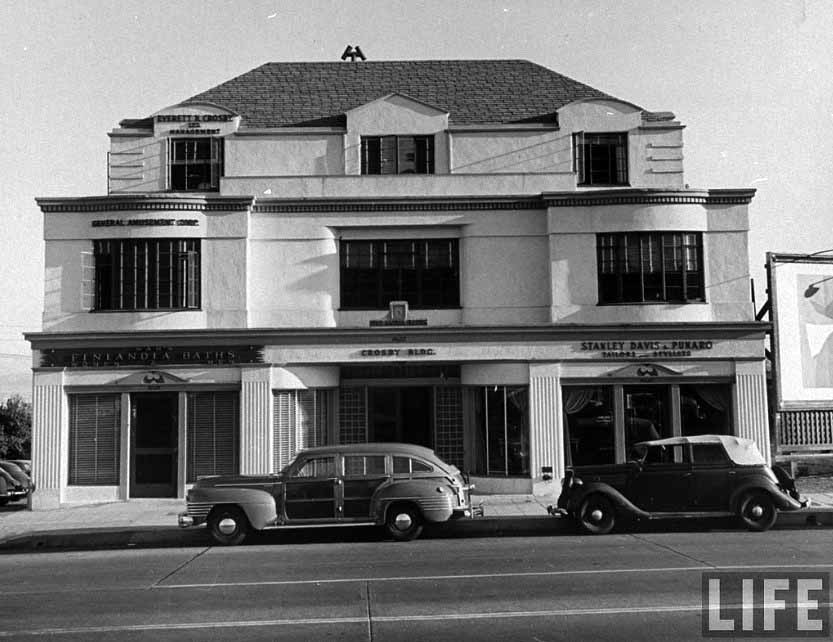 |
|
| (1946)^##* - Exterior view of the Crosby Building, located at 9028 Sunset Boulevard. The entrance to the famous (or infamous) Finlandia Baths can be seen on the left. |
Historical Notes The Finlandia Baths were downstairs in the basement of the Crosby Building where a virtual who's who of closeted gay and straight male stars went for a bake or to rub the kinks out or have them rubbed out, as the case may be. Regulars apparently included Kirk Douglas, Cornel Wilde, Humphrey Bogart, Tony Curtis, Hugh O'Brien, Rock Hudson and the Crosby brothers and many others. The building is still there albeit somewhat folded, spindled and mutilated but the bones are still good and still visible. Finlandia Baths have predictably morphed into a tattoo parlor. |
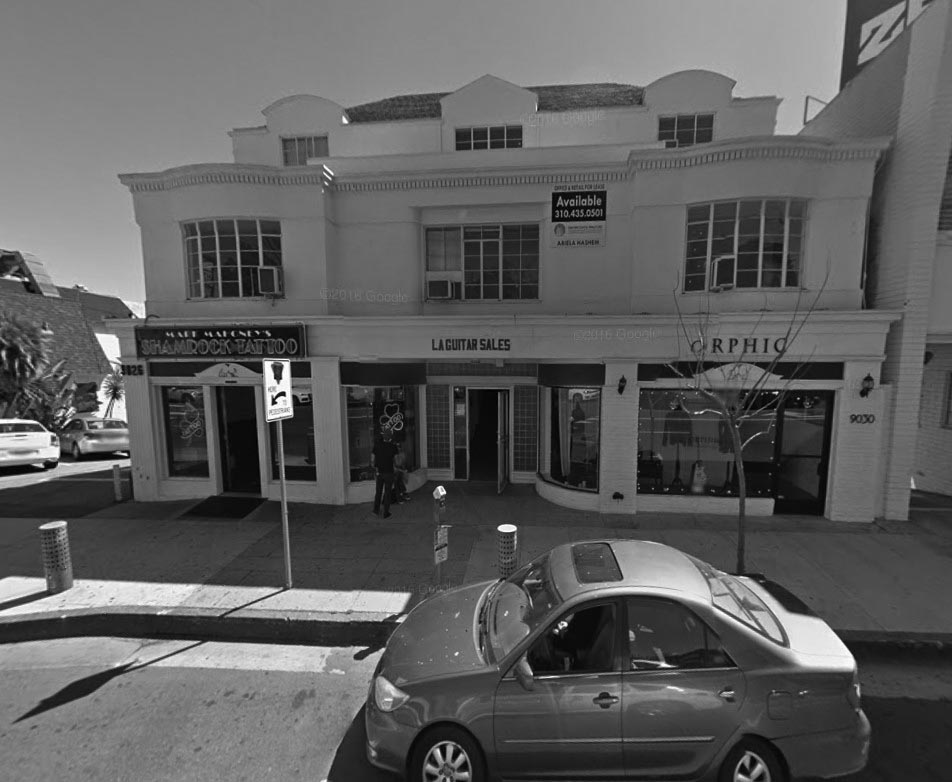 |
|
| (2015)* – Google Street View showing the Crosby Building as it appears today. Tenants include: Shamrock Tattoo, LA Guitar Sales, and Orphic. |
* * * * * |
Please Support Our CauseWater and Power Associates, Inc. is a non-profit, public service organization dedicated to preserving historical records and photos. Your generosity allows us to continue to disseminate knowledge of the rich and diverse multicultural history of the greater Los Angeles area; to serve as a resource of historical information; and to assist in the preservation of the city's historic records.
|
More Historical Early Views
Newest Additions
Early LA Buildings and City Views
History of Water and Electricity in Los Angeles
* * * * * |
References and Credits
* LA Public Library Image Archive
^* California Historic Landmark Listing (Los Angeles)
^ California Historical Society Digital Archive
** Retronaut - Hollywoodland Sign
#^WhitleyHeights.org: Aerial of Cahuenga; Whitley Heights Aerial
#+LA Weekly: Laurel Canyon Country Store
***The Story of Hollywood by Gregory Paul Williams
^^^California State Library Image Archive
^**Huntington Digital Library Archive
**^Table Magazine: LA Observatory
^++Sunset Plaza
+++The WeHo Ho: An Insider's Guide to West Hollywood; La Cienega Lanes
**#Beguiling Hollywood: The Hollywood Hotel
^^#LA Times: Hollywood Citizens News Building; Marlboro Man Signboard; Mark C. Bloome
+^#Facebook.com: Hidden Los Angeles
*#*Elvis Blog
#^^Hollywood Walk of Fame Historic Buildings
#++GoCalifornia.about.com: Sunset Strip
#^*Pinterest.com: Old Hollywood; Los Angeles
#^# DWP - LA Public Library Image Archive
##*The Daily Mirror: Garden Court Apartments
##+Facebook.com: Greenblatt's Deli
*^*MTA Transportation and Research Library Archives
*^^Nuestra Señora la Reina de los Ángeles - losangelespast.com
^^*Cinema Treasures: Vogue Theater; Pantages Theater; Iris Theatre; Marcal - World Theatre
*^*^YMCA Hollywood - paulwilliamspoject.org
*^^*Vintage Los Angeles: Facebook.com: Lucy/Holden; Villa Nova; Sunset Tower Apartments; Earl Carroll Revolving Stage; Schwabs Sunset; Player's Club
^*^^Pomona Public Library Poscard Collection
^^^^Water and Power Associates
^*^#Facebook.com - Bizzare Los Angeles
^^^#KCET: How the Town of Sherman Became West Hollywood; The Player's on the Sunset Strip; L.A.'s First Freeways
^^++Life Magazine
++^^RockCellar Magazine: Sunset Strip
^+++Brucebase: The Roxy Theatre
+++#Go-Go Notebook.com: Flipper's Roller Derby Palace
***^Pinterest.com: Bertrand Lacheze; Vintage Los Angeles: Sunset Strip; Trocadero Nightclub
^**^Griffith Observatory: laparks.org
**##MartinTurnbull.com: The Players; Hollywood-Western Building; Earl Carroll Theater; Sherry's Restaurant; Hollywood and Highland
^^##Alison Martino's Vintage Los Angeles: Wallichs Music City; The Villa Nova
#+#+Facebook.com
#+++TheSunsetStrip.com: Sunset Plaza
^##*Flickr.com: Michael Ryerson; Bill Badzo
^#^^Facebook.com - Vintage LA: 1968 Sunset Strip; Yellow Submarine; 1984 Sunset Strip
^^#*Flickr.com: Elizabeth Fuller
*#*#Facebook.com - Great Photos from Los Angeles's Past: Players Nightclub
*^#*Calisphere: University of California Image Archive
*^^#Mt. Hollywood - Small Mountain, Big Dreams
*^##OAC - Online Archive of California
#**#Facebook.com: Garden of Allah Novels, Martin Turnbull
#*^#Historic Hollywood Theatres: Grauman's Chinese Theatre
#^**The Go Go's: Local Coffee Shops and Diners; PJ's Nightclub
#^^#The Rise and Fall of Dino's Lodge by Kliph Nesteroff
#^##ShareTV.com: 77 Sunset Strip
##^*Facebook.com: Classic Hollywood-Los Angeles-SFV
*###Google Maps
###*GoLosAngeles.abouttcom: History of the Sunset Strip
###+The Guardian: Anarchy on Sunset Strip
####Neatorama.com: Dean Martin and Jerry Lewis Restaurant Owners
#^#*Pinterest.com: Rock'n'Roll & Boogie Woogie
**^**Los Angeles City Historical Society
***^^Oldshowbiz.tmblr.com: Crescendo Club
***##Googie Architecture
**^^^Pinterest.com: Sunset Strip
*^^^^SeriousEats.com: Carneys Diner
*^*^*Blogspot.com: It's a wrap - USA/Mexico - Mel's Drive-In
*^#^*Vintage Everyday
*^*^^Crescendo GNP
^*^*^Go Los Angeles About.com: Sunset Strip
^***^Flickr.com: gsjansen
*^^^*RareMaps.com
^#*#^Private Los Angeles Tours: Ciro's Nightclub
^#^#^LA Curbed: Sunset's Tower Records
*#*#*wehoville.com: Tower Records
*# Skyscraperage.com. - Griffith Observatory; Elvis at Knickerbocker Hotel; Gruen Sign; Garden Court Apartments; Mt. Hollywood; Ben-Hur Coffee; Sherry's Restaurant; Griffith Observatory; Sunset Strip 1960s; Cahunega and Highland Intersection ca1937; Googie's; Selma and Argyle
*^ Wikipedia: Hollywood; Hollywood Athletic Club; Hollywood Bowl; Grauman's Chinese Theatre; Grauman's Egyptian Theatre; Pantages Theatre (Hollywood); John Hanson Ford Theatre; 20th Century Fox; Samuel Goldwyn.Studio; Barnsdall Art Park; Greek Theatre; Griffith Observatory; Cinerama Dome; Ralphs; Hollywood Palladium; Hollywood and Vine; Hollywood Masonic Temple; Hollywood Pacific Theatre; Max Factor; West Hollywood; Brown Derby; Hollywood Christmas Parade; The Hollywood Hotel; Cord Automobile: Sunset Tower; West Coast Radio City - Los Angeles; Earl Carroll Theater; Cafe Trocadero; Breakfast in Hollywood; Whitley Heights; Hollywood Christmas Parade; Garden Court Apartments; Chili Bowl Restaurant - Art Whizin; The Hillview; Paramount Studios; Hollywood Freeway; Hollywood Roosevelt Hotel; J. J. Newberry; Claudette Colbert; Whisky A Go-Go; Gazzari's; The Whtie Parade; The Troubador; Starwood Club; Hollywood Post Office; Chubby Checker; Decoration Day; 77 Sunset Strip; Chateau Marmont Hotel; The Doors; The Comedy Store; Ciro's Nightclub; The Ravenswood; Googie Architecture; Charlie Chaplin; Doheny Drive; Shirley Temple
< Back
Menu
- Home
- Mission
- Museum
- Major Efforts
- Recent Newsletters
- Historical Op Ed Pieces
- Board Officers and Directors
- Mulholland/McCarthy Service Awards
- Positions on Owens Valley and the City of Los Angeles Issues
- Legislative Positions on
Water Issues
- Legislative Positions on
Energy Issues
- Membership
- Contact Us
- Search Index